Bioenvironmental engineering flight Stock Photos and Images
(279)See bioenvironmental engineering flight stock video clipsQuick filters:
Bioenvironmental engineering flight Stock Photos and Images
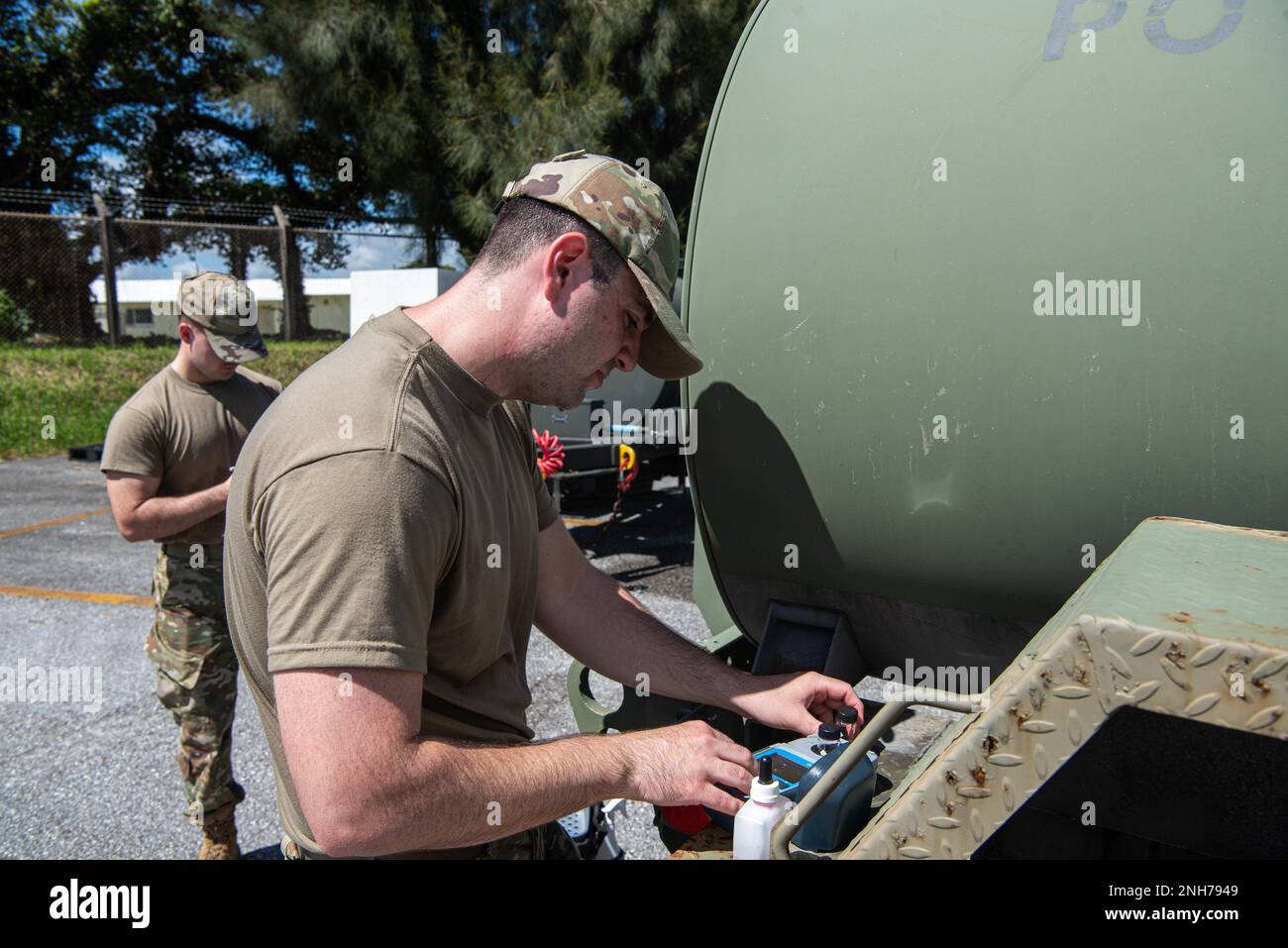 Senior Airman Adam Stoller, 18th Bioenvironmental Engineering Flight technician, tests a water sample at Kadena Air Base, Japan, July 21, 2022. The 18th BEF uses colorimeters to test pH, chlorine and fluoride levels. Stock Photohttps://www.alamy.com/image-license-details/?v=1https://www.alamy.com/senior-airman-adam-stoller-18th-bioenvironmental-engineering-flight-technician-tests-a-water-sample-at-kadena-air-base-japan-july-21-2022-the-18th-bef-uses-colorimeters-to-test-ph-chlorine-and-fluoride-levels-image526921033.html
Senior Airman Adam Stoller, 18th Bioenvironmental Engineering Flight technician, tests a water sample at Kadena Air Base, Japan, July 21, 2022. The 18th BEF uses colorimeters to test pH, chlorine and fluoride levels. Stock Photohttps://www.alamy.com/image-license-details/?v=1https://www.alamy.com/senior-airman-adam-stoller-18th-bioenvironmental-engineering-flight-technician-tests-a-water-sample-at-kadena-air-base-japan-july-21-2022-the-18th-bef-uses-colorimeters-to-test-ph-chlorine-and-fluoride-levels-image526921033.htmlRM2NH7949–Senior Airman Adam Stoller, 18th Bioenvironmental Engineering Flight technician, tests a water sample at Kadena Air Base, Japan, July 21, 2022. The 18th BEF uses colorimeters to test pH, chlorine and fluoride levels.
 The 633rd Civil Engineer Squadron conducted an active chemical, biological, radiological and nuclear (CBRN) response training at Joint Base Langley-Eustis, Virginia, March 29, 2019. For this training, the 633rd CES Fire Department, the 633rd CES explosive ordnance disposal, the 192nd Wing emergency management flight and the 633rd Aerospace Medicine Squadron bioenvironmental engineering flight responded to a simulated chemical munition threat. (U.S. Air Force photo by Senior Airman Anthony Nin Leclerec) Stock Photohttps://www.alamy.com/image-license-details/?v=1https://www.alamy.com/the-633rd-civil-engineer-squadron-conducted-an-active-chemical-biological-radiological-and-nuclear-cbrn-response-training-at-joint-base-langley-eustis-virginia-march-29-2019-for-this-training-the-633rd-ces-fire-department-the-633rd-ces-explosive-ordnance-disposal-the-192nd-wing-emergency-management-flight-and-the-633rd-aerospace-medicine-squadron-bioenvironmental-engineering-flight-responded-to-a-simulated-chemical-munition-threat-us-air-force-photo-by-senior-airman-anthony-nin-leclerec-image273442521.html
The 633rd Civil Engineer Squadron conducted an active chemical, biological, radiological and nuclear (CBRN) response training at Joint Base Langley-Eustis, Virginia, March 29, 2019. For this training, the 633rd CES Fire Department, the 633rd CES explosive ordnance disposal, the 192nd Wing emergency management flight and the 633rd Aerospace Medicine Squadron bioenvironmental engineering flight responded to a simulated chemical munition threat. (U.S. Air Force photo by Senior Airman Anthony Nin Leclerec) Stock Photohttps://www.alamy.com/image-license-details/?v=1https://www.alamy.com/the-633rd-civil-engineer-squadron-conducted-an-active-chemical-biological-radiological-and-nuclear-cbrn-response-training-at-joint-base-langley-eustis-virginia-march-29-2019-for-this-training-the-633rd-ces-fire-department-the-633rd-ces-explosive-ordnance-disposal-the-192nd-wing-emergency-management-flight-and-the-633rd-aerospace-medicine-squadron-bioenvironmental-engineering-flight-responded-to-a-simulated-chemical-munition-threat-us-air-force-photo-by-senior-airman-anthony-nin-leclerec-image273442521.htmlRMWTTAM9–The 633rd Civil Engineer Squadron conducted an active chemical, biological, radiological and nuclear (CBRN) response training at Joint Base Langley-Eustis, Virginia, March 29, 2019. For this training, the 633rd CES Fire Department, the 633rd CES explosive ordnance disposal, the 192nd Wing emergency management flight and the 633rd Aerospace Medicine Squadron bioenvironmental engineering flight responded to a simulated chemical munition threat. (U.S. Air Force photo by Senior Airman Anthony Nin Leclerec)
 YOKOTA AIR BASE, Japan--A member of the Contamination Avoidance Team uses an ADM-300 to screen aircraft and aircrew members returning from a flight to Northern Japan. The team is composed of experts from the 374th Aerospace Medicine Squadron's bioenvironmental engineering flight and the 374th Civil Engineer Squadron's readiness flight. Staff Sgt. Samuel Morse Stock Photohttps://www.alamy.com/image-license-details/?v=1https://www.alamy.com/stock-photo-yokota-air-base-japan-a-member-of-the-contamination-avoidance-team-78706109.html
YOKOTA AIR BASE, Japan--A member of the Contamination Avoidance Team uses an ADM-300 to screen aircraft and aircrew members returning from a flight to Northern Japan. The team is composed of experts from the 374th Aerospace Medicine Squadron's bioenvironmental engineering flight and the 374th Civil Engineer Squadron's readiness flight. Staff Sgt. Samuel Morse Stock Photohttps://www.alamy.com/image-license-details/?v=1https://www.alamy.com/stock-photo-yokota-air-base-japan-a-member-of-the-contamination-avoidance-team-78706109.htmlRMEG1ACD–YOKOTA AIR BASE, Japan--A member of the Contamination Avoidance Team uses an ADM-300 to screen aircraft and aircrew members returning from a flight to Northern Japan. The team is composed of experts from the 374th Aerospace Medicine Squadron's bioenvironmental engineering flight and the 374th Civil Engineer Squadron's readiness flight. Staff Sgt. Samuel Morse
 Airmen check one another’s seal during chemical, biological, radiological, nuclear and environmental training at Ellsworth Air Force Base, S.D., March 23, 2018. Emergency management Airmen from the 28th Civil Engineer Squadron work with the 28th Logistics Readiness Squadron and 28th Medical Operations Squadron bioenvironmental engineering flight to keep Ellsworth AFB Airmen proficient with their mission oriented protective posture gear. Stock Photohttps://www.alamy.com/image-license-details/?v=1https://www.alamy.com/airmen-check-one-anothers-seal-during-chemical-biological-radiological-nuclear-and-environmental-training-at-ellsworth-air-force-base-sd-march-23-2018-emergency-management-airmen-from-the-28th-civil-engineer-squadron-work-with-the-28th-logistics-readiness-squadron-and-28th-medical-operations-squadron-bioenvironmental-engineering-flight-to-keep-ellsworth-afb-airmen-proficient-with-their-mission-oriented-protective-posture-gear-image179618811.html
Airmen check one another’s seal during chemical, biological, radiological, nuclear and environmental training at Ellsworth Air Force Base, S.D., March 23, 2018. Emergency management Airmen from the 28th Civil Engineer Squadron work with the 28th Logistics Readiness Squadron and 28th Medical Operations Squadron bioenvironmental engineering flight to keep Ellsworth AFB Airmen proficient with their mission oriented protective posture gear. Stock Photohttps://www.alamy.com/image-license-details/?v=1https://www.alamy.com/airmen-check-one-anothers-seal-during-chemical-biological-radiological-nuclear-and-environmental-training-at-ellsworth-air-force-base-sd-march-23-2018-emergency-management-airmen-from-the-28th-civil-engineer-squadron-work-with-the-28th-logistics-readiness-squadron-and-28th-medical-operations-squadron-bioenvironmental-engineering-flight-to-keep-ellsworth-afb-airmen-proficient-with-their-mission-oriented-protective-posture-gear-image179618811.htmlRMMC69HF–Airmen check one another’s seal during chemical, biological, radiological, nuclear and environmental training at Ellsworth Air Force Base, S.D., March 23, 2018. Emergency management Airmen from the 28th Civil Engineer Squadron work with the 28th Logistics Readiness Squadron and 28th Medical Operations Squadron bioenvironmental engineering flight to keep Ellsworth AFB Airmen proficient with their mission oriented protective posture gear.
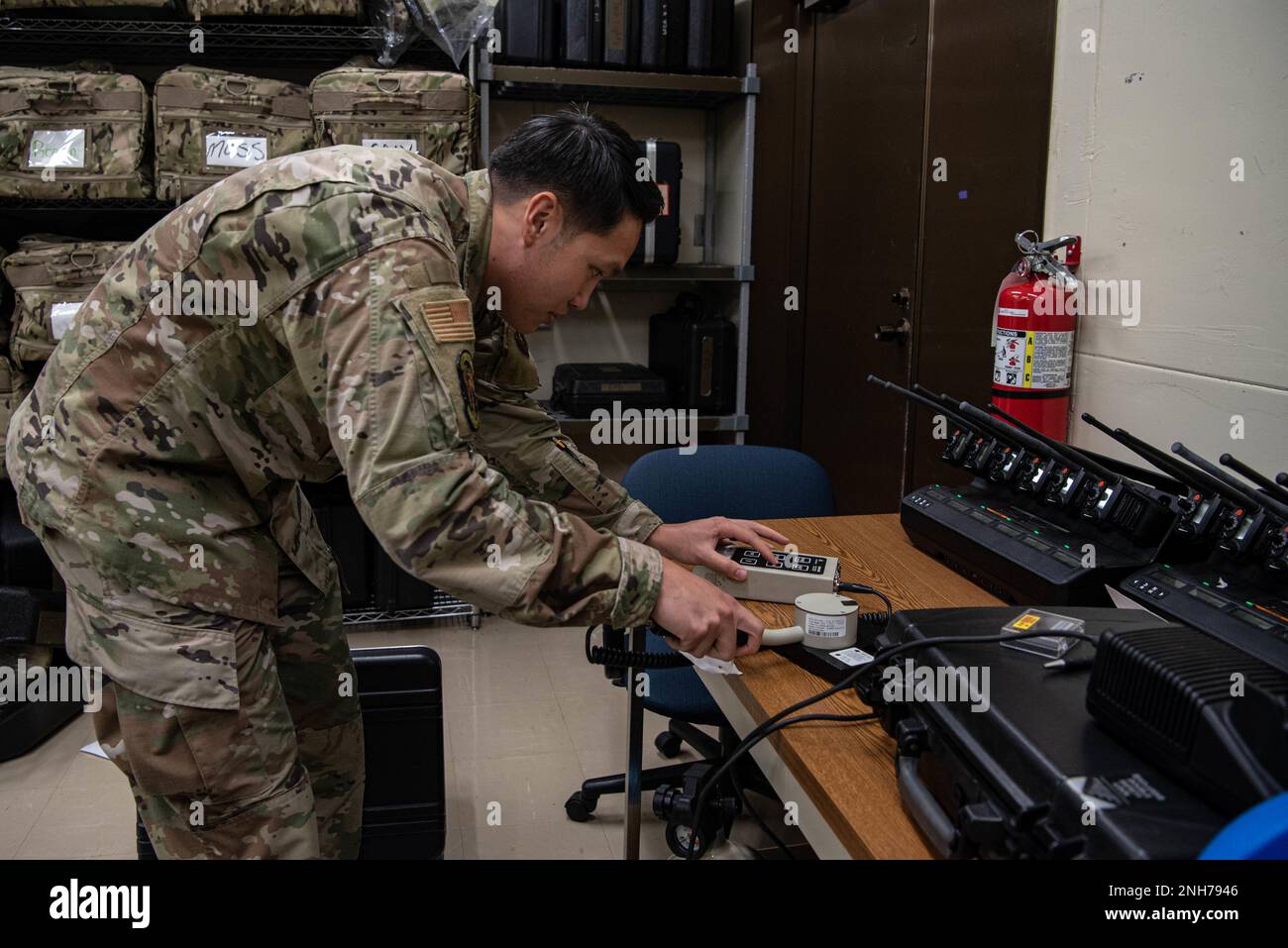 Senior Airman Cullen Jones, 18th Bioenvironmental Engineering Flight technician, performs an equipment test on an ADM-300 to detect radiation at Kadena Air Base, Japan, July 21, 2022. Detection of radioactive materials is part of how the 18th BEF ensures the safety of Airmen and their families. Stock Photohttps://www.alamy.com/image-license-details/?v=1https://www.alamy.com/senior-airman-cullen-jones-18th-bioenvironmental-engineering-flight-technician-performs-an-equipment-test-on-an-adm-300-to-detect-radiation-at-kadena-air-base-japan-july-21-2022-detection-of-radioactive-materials-is-part-of-how-the-18th-bef-ensures-the-safety-of-airmen-and-their-families-image526921030.html
Senior Airman Cullen Jones, 18th Bioenvironmental Engineering Flight technician, performs an equipment test on an ADM-300 to detect radiation at Kadena Air Base, Japan, July 21, 2022. Detection of radioactive materials is part of how the 18th BEF ensures the safety of Airmen and their families. Stock Photohttps://www.alamy.com/image-license-details/?v=1https://www.alamy.com/senior-airman-cullen-jones-18th-bioenvironmental-engineering-flight-technician-performs-an-equipment-test-on-an-adm-300-to-detect-radiation-at-kadena-air-base-japan-july-21-2022-detection-of-radioactive-materials-is-part-of-how-the-18th-bef-ensures-the-safety-of-airmen-and-their-families-image526921030.htmlRM2NH7946–Senior Airman Cullen Jones, 18th Bioenvironmental Engineering Flight technician, performs an equipment test on an ADM-300 to detect radiation at Kadena Air Base, Japan, July 21, 2022. Detection of radioactive materials is part of how the 18th BEF ensures the safety of Airmen and their families.
 YOKOTA AIR BASE, Japan--A member of the Contamination Avoidance Team uses an ADM-300 to screen aircraft and aircrew members returning from a flight to Northern Japan. The team is composed of experts from the 374th Aerospace Medicine Squadron's bioenvironmental engineering flight and the 374th Civil Engineer Squadron's readiness flight. Staff Sgt. Samuel Morse Stock Photohttps://www.alamy.com/image-license-details/?v=1https://www.alamy.com/stock-photo-yokota-air-base-japan-a-member-of-the-contamination-avoidance-team-78706111.html
YOKOTA AIR BASE, Japan--A member of the Contamination Avoidance Team uses an ADM-300 to screen aircraft and aircrew members returning from a flight to Northern Japan. The team is composed of experts from the 374th Aerospace Medicine Squadron's bioenvironmental engineering flight and the 374th Civil Engineer Squadron's readiness flight. Staff Sgt. Samuel Morse Stock Photohttps://www.alamy.com/image-license-details/?v=1https://www.alamy.com/stock-photo-yokota-air-base-japan-a-member-of-the-contamination-avoidance-team-78706111.htmlRMEG1ACF–YOKOTA AIR BASE, Japan--A member of the Contamination Avoidance Team uses an ADM-300 to screen aircraft and aircrew members returning from a flight to Northern Japan. The team is composed of experts from the 374th Aerospace Medicine Squadron's bioenvironmental engineering flight and the 374th Civil Engineer Squadron's readiness flight. Staff Sgt. Samuel Morse
 The Risner Fitness Center displays the current flag condition for July 19, 2018, at Kadena Air Base, Japan. The 18th Aerospace Medical Squadron’s Bioenvironmental Engineering Flight monitors temperatures throughout the day to ensure the safety of Airmen and civilians working in the heat. Stock Photohttps://www.alamy.com/image-license-details/?v=1https://www.alamy.com/the-risner-fitness-center-displays-the-current-flag-condition-for-july-19-2018-at-kadena-air-base-japan-the-18th-aerospace-medical-squadrons-bioenvironmental-engineering-flight-monitors-temperatures-throughout-the-day-to-ensure-the-safety-of-airmen-and-civilians-working-in-the-heat-image217852673.html
The Risner Fitness Center displays the current flag condition for July 19, 2018, at Kadena Air Base, Japan. The 18th Aerospace Medical Squadron’s Bioenvironmental Engineering Flight monitors temperatures throughout the day to ensure the safety of Airmen and civilians working in the heat. Stock Photohttps://www.alamy.com/image-license-details/?v=1https://www.alamy.com/the-risner-fitness-center-displays-the-current-flag-condition-for-july-19-2018-at-kadena-air-base-japan-the-18th-aerospace-medical-squadrons-bioenvironmental-engineering-flight-monitors-temperatures-throughout-the-day-to-ensure-the-safety-of-airmen-and-civilians-working-in-the-heat-image217852673.htmlRMPJC18H–The Risner Fitness Center displays the current flag condition for July 19, 2018, at Kadena Air Base, Japan. The 18th Aerospace Medical Squadron’s Bioenvironmental Engineering Flight monitors temperatures throughout the day to ensure the safety of Airmen and civilians working in the heat.
 Tech. Sgt. Joanie Long, readiness non commisioned officer in charge at Kadena Air Base's 18th Aeromedical Squadrons Bioenvironmental Engineering Flight, holds an electronic personal dosimeter at the bioenvironmental engineering building March 15. The dosimeter is one of the many pieces of equipment the two-man crew from the 18th AMDS took to mainland Japan for the disaster relief efforts. The team has deployed to Yokota Air Base, near Tokyo, to test for radiation and other possible contaminates in the surrounding environment. Airman 1st Class Maeson L. Elleman Stock Photohttps://www.alamy.com/image-license-details/?v=1https://www.alamy.com/stock-photo-tech-sgt-joanie-long-readiness-non-commisioned-officer-in-charge-at-78706149.html
Tech. Sgt. Joanie Long, readiness non commisioned officer in charge at Kadena Air Base's 18th Aeromedical Squadrons Bioenvironmental Engineering Flight, holds an electronic personal dosimeter at the bioenvironmental engineering building March 15. The dosimeter is one of the many pieces of equipment the two-man crew from the 18th AMDS took to mainland Japan for the disaster relief efforts. The team has deployed to Yokota Air Base, near Tokyo, to test for radiation and other possible contaminates in the surrounding environment. Airman 1st Class Maeson L. Elleman Stock Photohttps://www.alamy.com/image-license-details/?v=1https://www.alamy.com/stock-photo-tech-sgt-joanie-long-readiness-non-commisioned-officer-in-charge-at-78706149.htmlRMEG1ADW–Tech. Sgt. Joanie Long, readiness non commisioned officer in charge at Kadena Air Base's 18th Aeromedical Squadrons Bioenvironmental Engineering Flight, holds an electronic personal dosimeter at the bioenvironmental engineering building March 15. The dosimeter is one of the many pieces of equipment the two-man crew from the 18th AMDS took to mainland Japan for the disaster relief efforts. The team has deployed to Yokota Air Base, near Tokyo, to test for radiation and other possible contaminates in the surrounding environment. Airman 1st Class Maeson L. Elleman
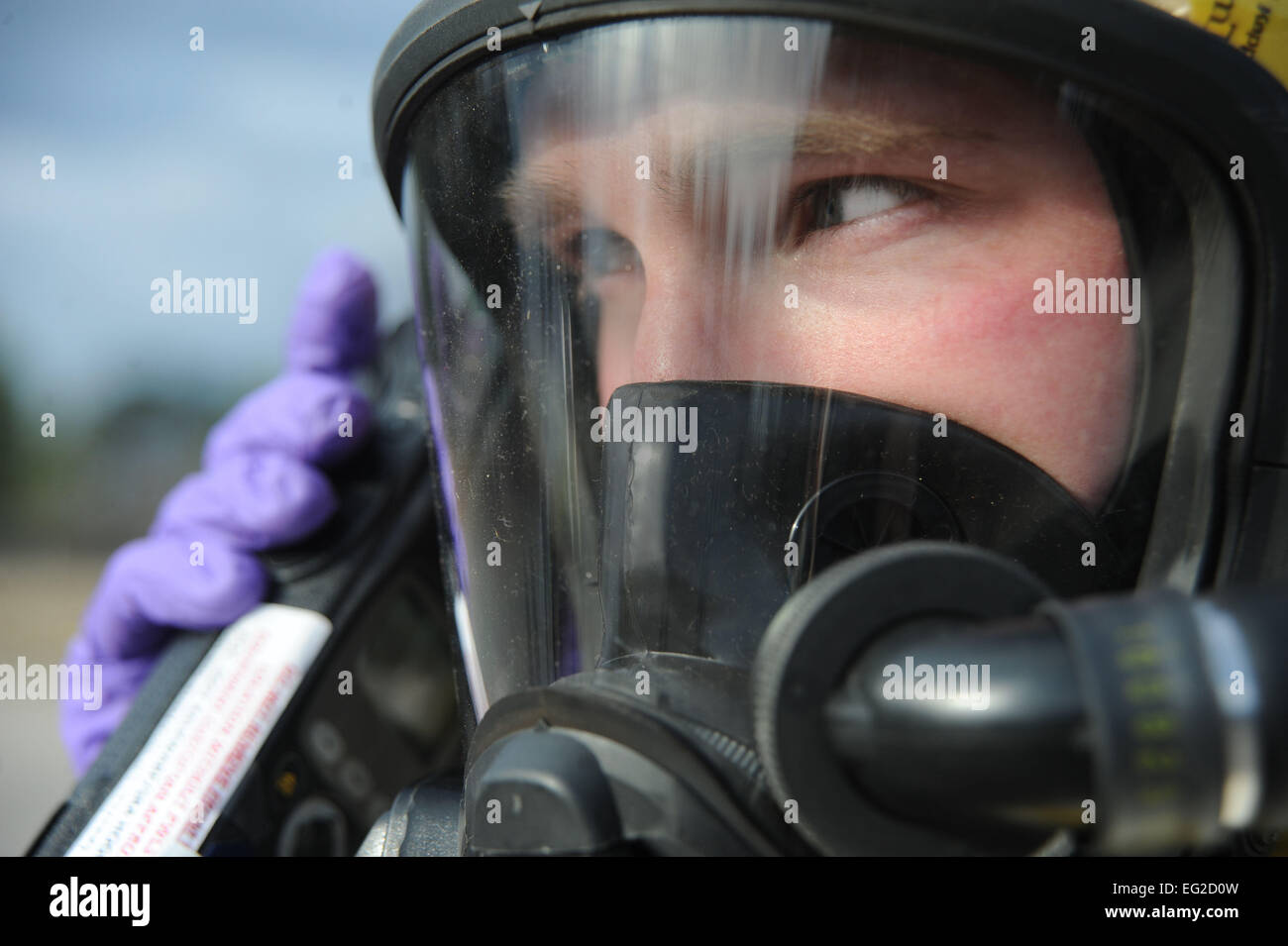 U.S. Air Force Senior Airman Jordan Gagne, 20th Aerospace Medicine Squadron bioenvironmental engineering journeyman, speaks on a radio during an integrated base emergency response capability training at Shaw Air Force Base, S.C., Dec. 9, 2014. The 20th Civil Engineer Squadron emergency management flight and the 20th AMDS bioenvironmental flight were tested on their abilities to react and work together in the event a chemical attack were to happen on base. Airman 1st Class Michael Cossaboom Stock Photohttps://www.alamy.com/image-license-details/?v=1https://www.alamy.com/stock-photo-us-air-force-senior-airman-jordan-gagne-20th-aerospace-medicine-squadron-78730089.html
U.S. Air Force Senior Airman Jordan Gagne, 20th Aerospace Medicine Squadron bioenvironmental engineering journeyman, speaks on a radio during an integrated base emergency response capability training at Shaw Air Force Base, S.C., Dec. 9, 2014. The 20th Civil Engineer Squadron emergency management flight and the 20th AMDS bioenvironmental flight were tested on their abilities to react and work together in the event a chemical attack were to happen on base. Airman 1st Class Michael Cossaboom Stock Photohttps://www.alamy.com/image-license-details/?v=1https://www.alamy.com/stock-photo-us-air-force-senior-airman-jordan-gagne-20th-aerospace-medicine-squadron-78730089.htmlRMEG2D0W–U.S. Air Force Senior Airman Jordan Gagne, 20th Aerospace Medicine Squadron bioenvironmental engineering journeyman, speaks on a radio during an integrated base emergency response capability training at Shaw Air Force Base, S.C., Dec. 9, 2014. The 20th Civil Engineer Squadron emergency management flight and the 20th AMDS bioenvironmental flight were tested on their abilities to react and work together in the event a chemical attack were to happen on base. Airman 1st Class Michael Cossaboom
 Airman 1st Class Tyler De Tata, 18th Bioenvironmental Engineering Flight technician, collects a water sample to test for bacteria at Kadena Air Base, Japan, July 21, 2022. The 18th BEF incubates the water sample for 24 hours to determine if there has been a bacterial contamination. Stock Photohttps://www.alamy.com/image-license-details/?v=1https://www.alamy.com/airman-1st-class-tyler-de-tata-18th-bioenvironmental-engineering-flight-technician-collects-a-water-sample-to-test-for-bacteria-at-kadena-air-base-japan-july-21-2022-the-18th-bef-incubates-the-water-sample-for-24-hours-to-determine-if-there-has-been-a-bacterial-contamination-image526921016.html
Airman 1st Class Tyler De Tata, 18th Bioenvironmental Engineering Flight technician, collects a water sample to test for bacteria at Kadena Air Base, Japan, July 21, 2022. The 18th BEF incubates the water sample for 24 hours to determine if there has been a bacterial contamination. Stock Photohttps://www.alamy.com/image-license-details/?v=1https://www.alamy.com/airman-1st-class-tyler-de-tata-18th-bioenvironmental-engineering-flight-technician-collects-a-water-sample-to-test-for-bacteria-at-kadena-air-base-japan-july-21-2022-the-18th-bef-incubates-the-water-sample-for-24-hours-to-determine-if-there-has-been-a-bacterial-contamination-image526921016.htmlRM2NH793M–Airman 1st Class Tyler De Tata, 18th Bioenvironmental Engineering Flight technician, collects a water sample to test for bacteria at Kadena Air Base, Japan, July 21, 2022. The 18th BEF incubates the water sample for 24 hours to determine if there has been a bacterial contamination.
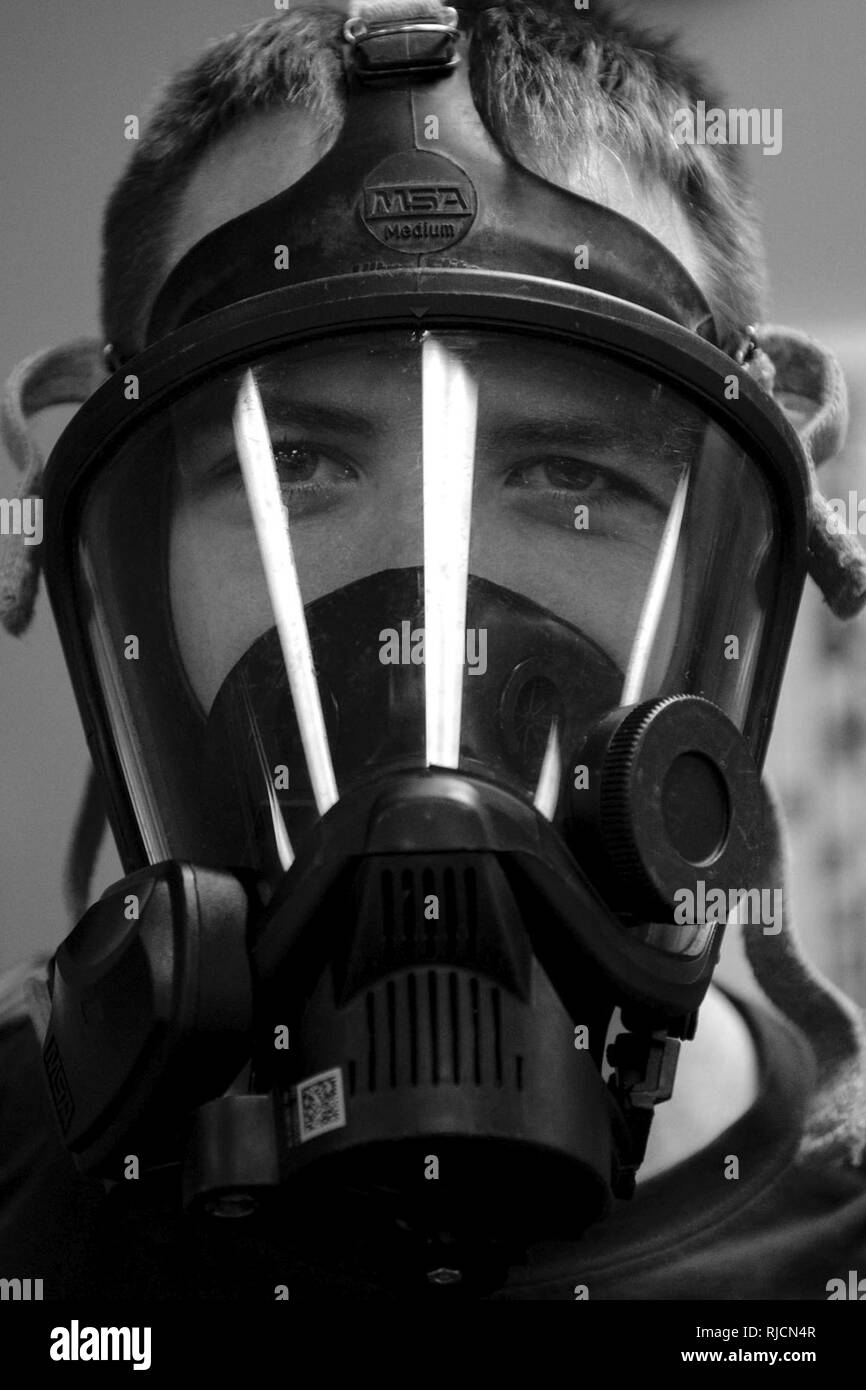 2nd Lt. Eric Olson, 23d Aerospace Medicine Squadron bioenvironmental engineer, gears up during readiness training, Jan. 12, 2018, at Moody Air Force Base, Ga. The Bioenvironmental Engineering Flight tested their response capabilities in a simulated contamination scenario. Bioenvironmental engineering specialists focus on reducing health hazards in the workplace and surrounding areas. Stock Photohttps://www.alamy.com/image-license-details/?v=1https://www.alamy.com/2nd-lt-eric-olson-23d-aerospace-medicine-squadron-bioenvironmental-engineer-gears-up-during-readiness-training-jan-12-2018-at-moody-air-force-base-ga-the-bioenvironmental-engineering-flight-tested-their-response-capabilities-in-a-simulated-contamination-scenario-bioenvironmental-engineering-specialists-focus-on-reducing-health-hazards-in-the-workplace-and-surrounding-areas-image235078615.html
2nd Lt. Eric Olson, 23d Aerospace Medicine Squadron bioenvironmental engineer, gears up during readiness training, Jan. 12, 2018, at Moody Air Force Base, Ga. The Bioenvironmental Engineering Flight tested their response capabilities in a simulated contamination scenario. Bioenvironmental engineering specialists focus on reducing health hazards in the workplace and surrounding areas. Stock Photohttps://www.alamy.com/image-license-details/?v=1https://www.alamy.com/2nd-lt-eric-olson-23d-aerospace-medicine-squadron-bioenvironmental-engineer-gears-up-during-readiness-training-jan-12-2018-at-moody-air-force-base-ga-the-bioenvironmental-engineering-flight-tested-their-response-capabilities-in-a-simulated-contamination-scenario-bioenvironmental-engineering-specialists-focus-on-reducing-health-hazards-in-the-workplace-and-surrounding-areas-image235078615.htmlRMRJCN4R–2nd Lt. Eric Olson, 23d Aerospace Medicine Squadron bioenvironmental engineer, gears up during readiness training, Jan. 12, 2018, at Moody Air Force Base, Ga. The Bioenvironmental Engineering Flight tested their response capabilities in a simulated contamination scenario. Bioenvironmental engineering specialists focus on reducing health hazards in the workplace and surrounding areas.
 Airman 1st Class Tyler De Tata, 18th Bioenvironmental Engineering Flight technician, conducts a water sample chlorine test at Kadena Air Base, Japan, July 21, 2022. The 18th BEF is responsible for monitoring water quality, air quality and respiratory protection for the installation. Stock Photohttps://www.alamy.com/image-license-details/?v=1https://www.alamy.com/airman-1st-class-tyler-de-tata-18th-bioenvironmental-engineering-flight-technician-conducts-a-water-sample-chlorine-test-at-kadena-air-base-japan-july-21-2022-the-18th-bef-is-responsible-for-monitoring-water-quality-air-quality-and-respiratory-protection-for-the-installation-image526921038.html
Airman 1st Class Tyler De Tata, 18th Bioenvironmental Engineering Flight technician, conducts a water sample chlorine test at Kadena Air Base, Japan, July 21, 2022. The 18th BEF is responsible for monitoring water quality, air quality and respiratory protection for the installation. Stock Photohttps://www.alamy.com/image-license-details/?v=1https://www.alamy.com/airman-1st-class-tyler-de-tata-18th-bioenvironmental-engineering-flight-technician-conducts-a-water-sample-chlorine-test-at-kadena-air-base-japan-july-21-2022-the-18th-bef-is-responsible-for-monitoring-water-quality-air-quality-and-respiratory-protection-for-the-installation-image526921038.htmlRM2NH794E–Airman 1st Class Tyler De Tata, 18th Bioenvironmental Engineering Flight technician, conducts a water sample chlorine test at Kadena Air Base, Japan, July 21, 2022. The 18th BEF is responsible for monitoring water quality, air quality and respiratory protection for the installation.
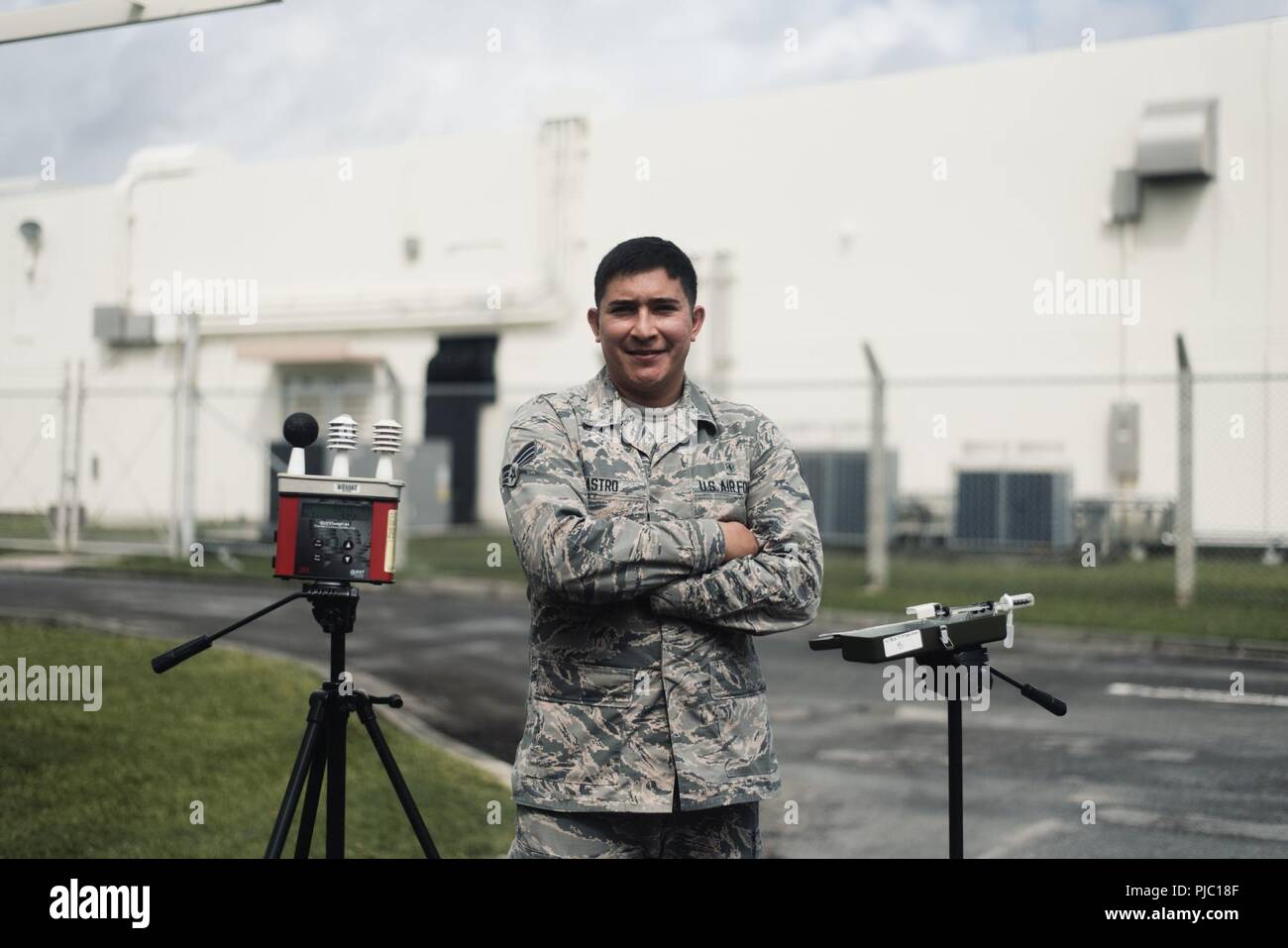 U.S Air Force Senior Airman Rodulfo Castro, 18th Aerospace Medical Squadron bioenvironmental engineering technician poses next to Wet Bulb Globe Temperature Meters July 17, 2018, at Kadena Air Base, Japan. The 18th AMS Bioenvironmental Engineering Flight is responsible for testing Kadena’s water supply, heat index and air quality. Stock Photohttps://www.alamy.com/image-license-details/?v=1https://www.alamy.com/us-air-force-senior-airman-rodulfo-castro-18th-aerospace-medical-squadron-bioenvironmental-engineering-technician-poses-next-to-wet-bulb-globe-temperature-meters-july-17-2018-at-kadena-air-base-japan-the-18th-ams-bioenvironmental-engineering-flight-is-responsible-for-testing-kadenas-water-supply-heat-index-and-air-quality-image217852671.html
U.S Air Force Senior Airman Rodulfo Castro, 18th Aerospace Medical Squadron bioenvironmental engineering technician poses next to Wet Bulb Globe Temperature Meters July 17, 2018, at Kadena Air Base, Japan. The 18th AMS Bioenvironmental Engineering Flight is responsible for testing Kadena’s water supply, heat index and air quality. Stock Photohttps://www.alamy.com/image-license-details/?v=1https://www.alamy.com/us-air-force-senior-airman-rodulfo-castro-18th-aerospace-medical-squadron-bioenvironmental-engineering-technician-poses-next-to-wet-bulb-globe-temperature-meters-july-17-2018-at-kadena-air-base-japan-the-18th-ams-bioenvironmental-engineering-flight-is-responsible-for-testing-kadenas-water-supply-heat-index-and-air-quality-image217852671.htmlRMPJC18F–U.S Air Force Senior Airman Rodulfo Castro, 18th Aerospace Medical Squadron bioenvironmental engineering technician poses next to Wet Bulb Globe Temperature Meters July 17, 2018, at Kadena Air Base, Japan. The 18th AMS Bioenvironmental Engineering Flight is responsible for testing Kadena’s water supply, heat index and air quality.
 Airman 1st Class Tyler De Tata, 18th Bioenvironmental Engineering Flight technician, adds a solution to test a water sample’s pH level at Kadena Air Base, Japan, July 21, 2022. The 18th BEF tests water monthly to ensure safe drinking water for the installation. Stock Photohttps://www.alamy.com/image-license-details/?v=1https://www.alamy.com/airman-1st-class-tyler-de-tata-18th-bioenvironmental-engineering-flight-technician-adds-a-solution-to-test-a-water-samples-ph-level-at-kadena-air-base-japan-july-21-2022-the-18th-bef-tests-water-monthly-to-ensure-safe-drinking-water-for-the-installation-image526921042.html
Airman 1st Class Tyler De Tata, 18th Bioenvironmental Engineering Flight technician, adds a solution to test a water sample’s pH level at Kadena Air Base, Japan, July 21, 2022. The 18th BEF tests water monthly to ensure safe drinking water for the installation. Stock Photohttps://www.alamy.com/image-license-details/?v=1https://www.alamy.com/airman-1st-class-tyler-de-tata-18th-bioenvironmental-engineering-flight-technician-adds-a-solution-to-test-a-water-samples-ph-level-at-kadena-air-base-japan-july-21-2022-the-18th-bef-tests-water-monthly-to-ensure-safe-drinking-water-for-the-installation-image526921042.htmlRM2NH794J–Airman 1st Class Tyler De Tata, 18th Bioenvironmental Engineering Flight technician, adds a solution to test a water sample’s pH level at Kadena Air Base, Japan, July 21, 2022. The 18th BEF tests water monthly to ensure safe drinking water for the installation.
 U.S Air Force Senior Airman Rodulfo Castro, 18th Aerospace Medical Squadron bioenvironmental engineering technician, relays the current flag condition to the Command Post July 17, 2018, at Kadena Air Base, Japan. The 18th AMS Bioenvironmental Engineering Flight is responsible for testing Kadena's water supply, heat index and air quality. Stock Photohttps://www.alamy.com/image-license-details/?v=1https://www.alamy.com/us-air-force-senior-airman-rodulfo-castro-18th-aerospace-medical-squadron-bioenvironmental-engineering-technician-relays-the-current-flag-condition-to-the-command-post-july-17-2018-at-kadena-air-base-japan-the-18th-ams-bioenvironmental-engineering-flight-is-responsible-for-testing-kadenas-water-supply-heat-index-and-air-quality-image217852672.html
U.S Air Force Senior Airman Rodulfo Castro, 18th Aerospace Medical Squadron bioenvironmental engineering technician, relays the current flag condition to the Command Post July 17, 2018, at Kadena Air Base, Japan. The 18th AMS Bioenvironmental Engineering Flight is responsible for testing Kadena's water supply, heat index and air quality. Stock Photohttps://www.alamy.com/image-license-details/?v=1https://www.alamy.com/us-air-force-senior-airman-rodulfo-castro-18th-aerospace-medical-squadron-bioenvironmental-engineering-technician-relays-the-current-flag-condition-to-the-command-post-july-17-2018-at-kadena-air-base-japan-the-18th-ams-bioenvironmental-engineering-flight-is-responsible-for-testing-kadenas-water-supply-heat-index-and-air-quality-image217852672.htmlRMPJC18G–U.S Air Force Senior Airman Rodulfo Castro, 18th Aerospace Medical Squadron bioenvironmental engineering technician, relays the current flag condition to the Command Post July 17, 2018, at Kadena Air Base, Japan. The 18th AMS Bioenvironmental Engineering Flight is responsible for testing Kadena's water supply, heat index and air quality.
 Airman 1st Class Gretta Meixel, 18th Bioenvironmental Engineering Flight technician, tests the fit of a self-contained breathing apparatus during an equipment test at Kadena Air Base, Japan, July 21, 2022. The 18th BEF is responsible for monitoring water quality, air quality and respiratory protection for the installation. Stock Photohttps://www.alamy.com/image-license-details/?v=1https://www.alamy.com/airman-1st-class-gretta-meixel-18th-bioenvironmental-engineering-flight-technician-tests-the-fit-of-a-self-contained-breathing-apparatus-during-an-equipment-test-at-kadena-air-base-japan-july-21-2022-the-18th-bef-is-responsible-for-monitoring-water-quality-air-quality-and-respiratory-protection-for-the-installation-image526921037.html
Airman 1st Class Gretta Meixel, 18th Bioenvironmental Engineering Flight technician, tests the fit of a self-contained breathing apparatus during an equipment test at Kadena Air Base, Japan, July 21, 2022. The 18th BEF is responsible for monitoring water quality, air quality and respiratory protection for the installation. Stock Photohttps://www.alamy.com/image-license-details/?v=1https://www.alamy.com/airman-1st-class-gretta-meixel-18th-bioenvironmental-engineering-flight-technician-tests-the-fit-of-a-self-contained-breathing-apparatus-during-an-equipment-test-at-kadena-air-base-japan-july-21-2022-the-18th-bef-is-responsible-for-monitoring-water-quality-air-quality-and-respiratory-protection-for-the-installation-image526921037.htmlRM2NH794D–Airman 1st Class Gretta Meixel, 18th Bioenvironmental Engineering Flight technician, tests the fit of a self-contained breathing apparatus during an equipment test at Kadena Air Base, Japan, July 21, 2022. The 18th BEF is responsible for monitoring water quality, air quality and respiratory protection for the installation.
 U.S. Air Force Senior Airman Joshua Crenshaw, 8th Healthcare Operations Squadron bioenvironmental engineering technician, inspects a water sample during a training event at Kunsan Air Base, Republic of Korea, Sept. 14, 2022. The bioenvironmental engineering flight increased their water sampling operations during training to mirror the simulated increased threat to the installation’s water sources. Stock Photohttps://www.alamy.com/image-license-details/?v=1https://www.alamy.com/us-air-force-senior-airman-joshua-crenshaw-8th-healthcare-operations-squadron-bioenvironmental-engineering-technician-inspects-a-water-sample-during-a-training-event-at-kunsan-air-base-republic-of-korea-sept-14-2022-the-bioenvironmental-engineering-flight-increased-their-water-sampling-operations-during-training-to-mirror-the-simulated-increased-threat-to-the-installations-water-sources-image511486937.html
U.S. Air Force Senior Airman Joshua Crenshaw, 8th Healthcare Operations Squadron bioenvironmental engineering technician, inspects a water sample during a training event at Kunsan Air Base, Republic of Korea, Sept. 14, 2022. The bioenvironmental engineering flight increased their water sampling operations during training to mirror the simulated increased threat to the installation’s water sources. Stock Photohttps://www.alamy.com/image-license-details/?v=1https://www.alamy.com/us-air-force-senior-airman-joshua-crenshaw-8th-healthcare-operations-squadron-bioenvironmental-engineering-technician-inspects-a-water-sample-during-a-training-event-at-kunsan-air-base-republic-of-korea-sept-14-2022-the-bioenvironmental-engineering-flight-increased-their-water-sampling-operations-during-training-to-mirror-the-simulated-increased-threat-to-the-installations-water-sources-image511486937.htmlRM2MM46PH–U.S. Air Force Senior Airman Joshua Crenshaw, 8th Healthcare Operations Squadron bioenvironmental engineering technician, inspects a water sample during a training event at Kunsan Air Base, Republic of Korea, Sept. 14, 2022. The bioenvironmental engineering flight increased their water sampling operations during training to mirror the simulated increased threat to the installation’s water sources.
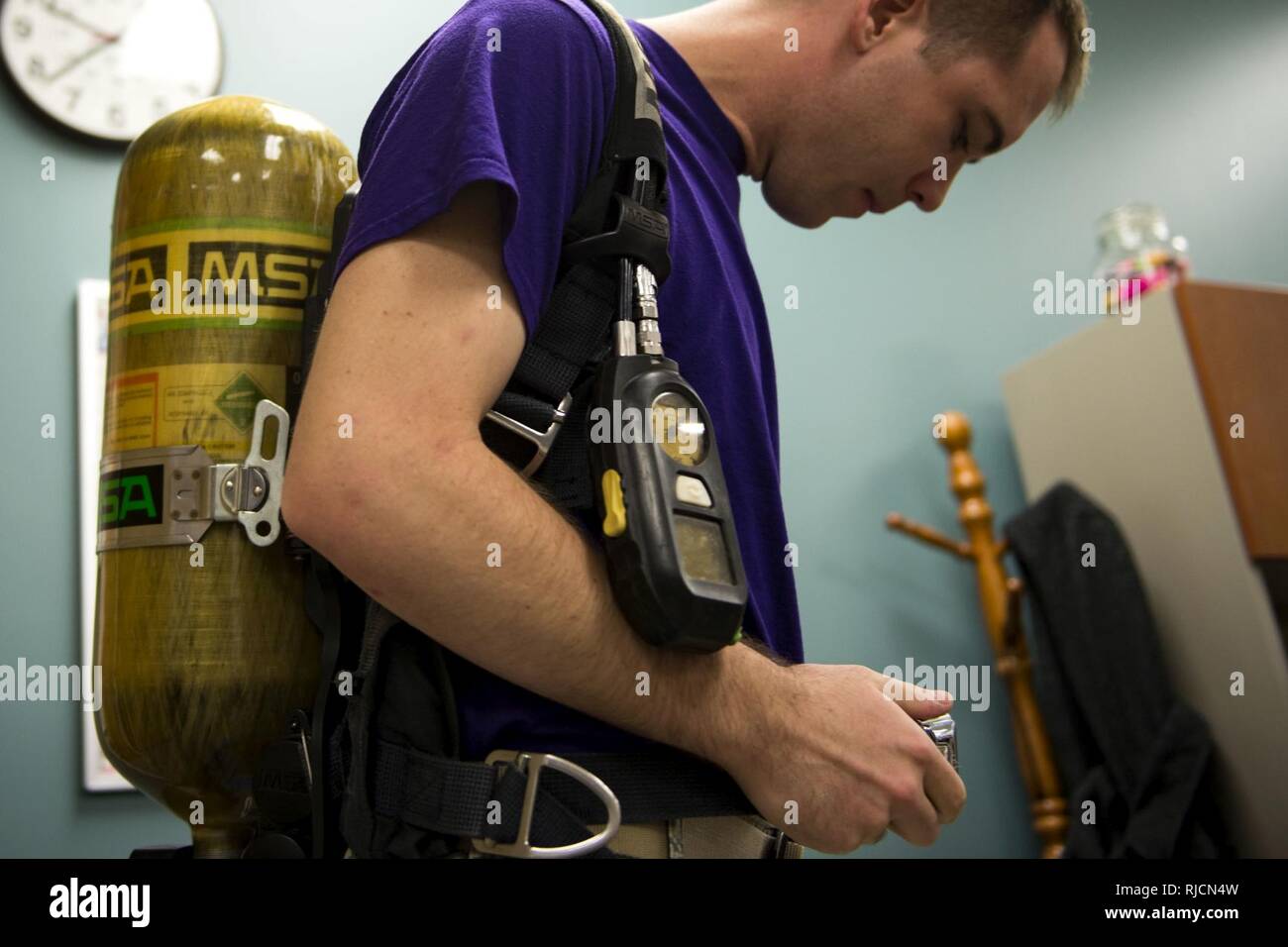 2nd Lt. Eric Olson, 23d Aerospace Medicine Squadron (AMDS) bioenvironmental engineer, secures a breathing apparatus during biohazard readiness training, Jan. 12, 2018, at Moody Air Force Base, Ga. The Bioenvironmental Engineering Flight tested their response capabilities in a simulated contamination scenario. Bioenvironmental engineering specialists focus on reducing health hazards in the workplace and surrounding areas. Stock Photohttps://www.alamy.com/image-license-details/?v=1https://www.alamy.com/2nd-lt-eric-olson-23d-aerospace-medicine-squadron-amds-bioenvironmental-engineer-secures-a-breathing-apparatus-during-biohazard-readiness-training-jan-12-2018-at-moody-air-force-base-ga-the-bioenvironmental-engineering-flight-tested-their-response-capabilities-in-a-simulated-contamination-scenario-bioenvironmental-engineering-specialists-focus-on-reducing-health-hazards-in-the-workplace-and-surrounding-areas-image235078617.html
2nd Lt. Eric Olson, 23d Aerospace Medicine Squadron (AMDS) bioenvironmental engineer, secures a breathing apparatus during biohazard readiness training, Jan. 12, 2018, at Moody Air Force Base, Ga. The Bioenvironmental Engineering Flight tested their response capabilities in a simulated contamination scenario. Bioenvironmental engineering specialists focus on reducing health hazards in the workplace and surrounding areas. Stock Photohttps://www.alamy.com/image-license-details/?v=1https://www.alamy.com/2nd-lt-eric-olson-23d-aerospace-medicine-squadron-amds-bioenvironmental-engineer-secures-a-breathing-apparatus-during-biohazard-readiness-training-jan-12-2018-at-moody-air-force-base-ga-the-bioenvironmental-engineering-flight-tested-their-response-capabilities-in-a-simulated-contamination-scenario-bioenvironmental-engineering-specialists-focus-on-reducing-health-hazards-in-the-workplace-and-surrounding-areas-image235078617.htmlRMRJCN4W–2nd Lt. Eric Olson, 23d Aerospace Medicine Squadron (AMDS) bioenvironmental engineer, secures a breathing apparatus during biohazard readiness training, Jan. 12, 2018, at Moody Air Force Base, Ga. The Bioenvironmental Engineering Flight tested their response capabilities in a simulated contamination scenario. Bioenvironmental engineering specialists focus on reducing health hazards in the workplace and surrounding areas.
 U.S. Air Force Senior Airman Joshua Crenshaw, 8th Healthcare Operations Squadron bioenvironmental engineering technician, inspects a water sample during a training event at Kunsan Air Base, Republic of Korea, Sept. 14, 2022. The bioenvironmental engineering flight increased their water sampling operations during training to mirror the simulated increased threat to the installation’s water sources. Stock Photohttps://www.alamy.com/image-license-details/?v=1https://www.alamy.com/us-air-force-senior-airman-joshua-crenshaw-8th-healthcare-operations-squadron-bioenvironmental-engineering-technician-inspects-a-water-sample-during-a-training-event-at-kunsan-air-base-republic-of-korea-sept-14-2022-the-bioenvironmental-engineering-flight-increased-their-water-sampling-operations-during-training-to-mirror-the-simulated-increased-threat-to-the-installations-water-sources-image491449476.html
U.S. Air Force Senior Airman Joshua Crenshaw, 8th Healthcare Operations Squadron bioenvironmental engineering technician, inspects a water sample during a training event at Kunsan Air Base, Republic of Korea, Sept. 14, 2022. The bioenvironmental engineering flight increased their water sampling operations during training to mirror the simulated increased threat to the installation’s water sources. Stock Photohttps://www.alamy.com/image-license-details/?v=1https://www.alamy.com/us-air-force-senior-airman-joshua-crenshaw-8th-healthcare-operations-squadron-bioenvironmental-engineering-technician-inspects-a-water-sample-during-a-training-event-at-kunsan-air-base-republic-of-korea-sept-14-2022-the-bioenvironmental-engineering-flight-increased-their-water-sampling-operations-during-training-to-mirror-the-simulated-increased-threat-to-the-installations-water-sources-image491449476.htmlRM2KFFCR0–U.S. Air Force Senior Airman Joshua Crenshaw, 8th Healthcare Operations Squadron bioenvironmental engineering technician, inspects a water sample during a training event at Kunsan Air Base, Republic of Korea, Sept. 14, 2022. The bioenvironmental engineering flight increased their water sampling operations during training to mirror the simulated increased threat to the installation’s water sources.
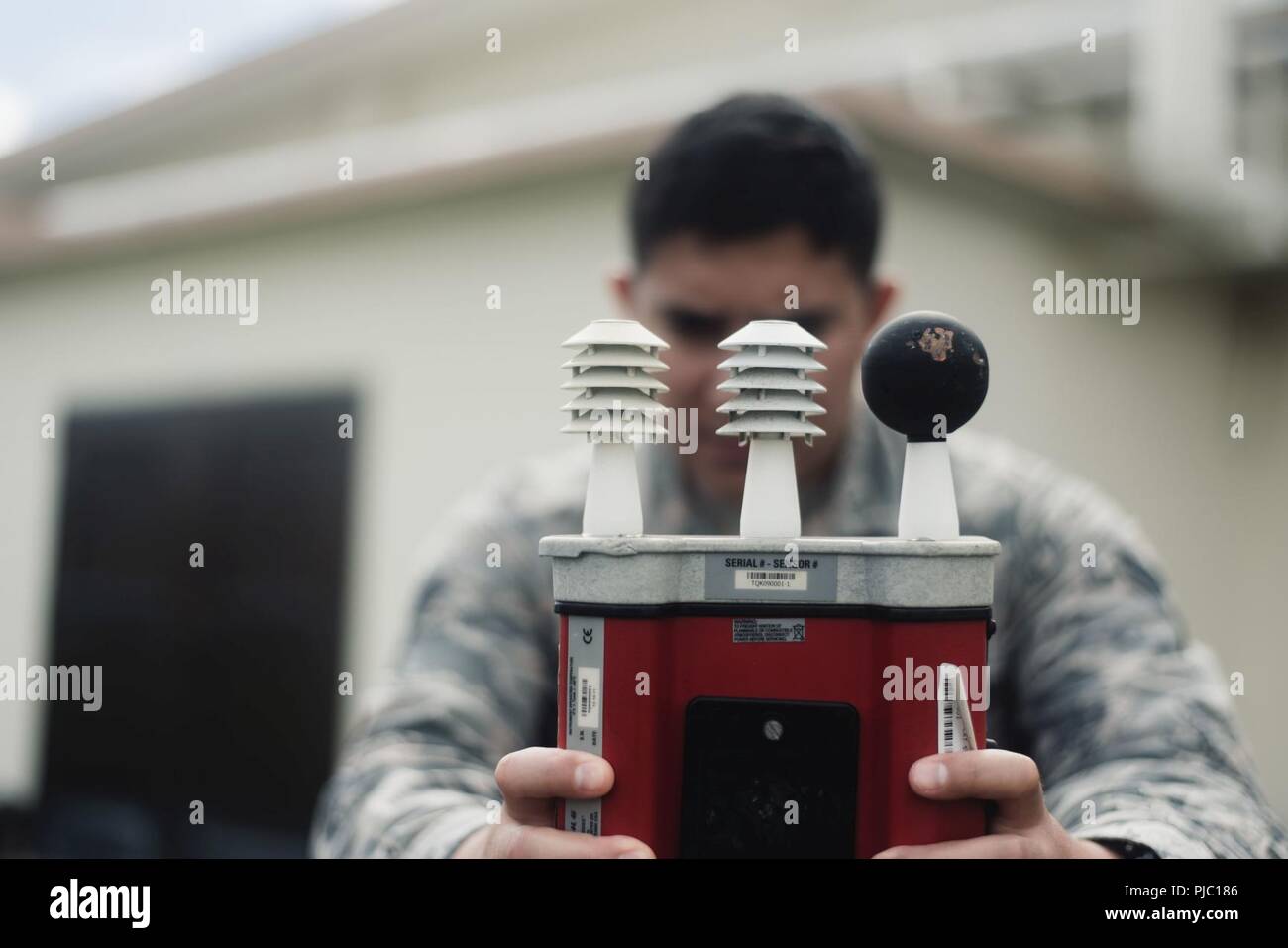 U.S Air Force Senior Airman Rodulfo Castro, 18th Aerospace Medical Squadron bioenvironmental engineering technician, configures an electronic Wet Bulb Globe Temperature Meter July 17, 2018, at Kadena Air Base, Japan. The 18th AMS Bioenvironmental Engineering Flight checks the current temperatures throughout the day to ensure the safety of Airmen and civilians working in the heat. Stock Photohttps://www.alamy.com/image-license-details/?v=1https://www.alamy.com/us-air-force-senior-airman-rodulfo-castro-18th-aerospace-medical-squadron-bioenvironmental-engineering-technician-configures-an-electronic-wet-bulb-globe-temperature-meter-july-17-2018-at-kadena-air-base-japan-the-18th-ams-bioenvironmental-engineering-flight-checks-the-current-temperatures-throughout-the-day-to-ensure-the-safety-of-airmen-and-civilians-working-in-the-heat-image217852662.html
U.S Air Force Senior Airman Rodulfo Castro, 18th Aerospace Medical Squadron bioenvironmental engineering technician, configures an electronic Wet Bulb Globe Temperature Meter July 17, 2018, at Kadena Air Base, Japan. The 18th AMS Bioenvironmental Engineering Flight checks the current temperatures throughout the day to ensure the safety of Airmen and civilians working in the heat. Stock Photohttps://www.alamy.com/image-license-details/?v=1https://www.alamy.com/us-air-force-senior-airman-rodulfo-castro-18th-aerospace-medical-squadron-bioenvironmental-engineering-technician-configures-an-electronic-wet-bulb-globe-temperature-meter-july-17-2018-at-kadena-air-base-japan-the-18th-ams-bioenvironmental-engineering-flight-checks-the-current-temperatures-throughout-the-day-to-ensure-the-safety-of-airmen-and-civilians-working-in-the-heat-image217852662.htmlRMPJC186–U.S Air Force Senior Airman Rodulfo Castro, 18th Aerospace Medical Squadron bioenvironmental engineering technician, configures an electronic Wet Bulb Globe Temperature Meter July 17, 2018, at Kadena Air Base, Japan. The 18th AMS Bioenvironmental Engineering Flight checks the current temperatures throughout the day to ensure the safety of Airmen and civilians working in the heat.
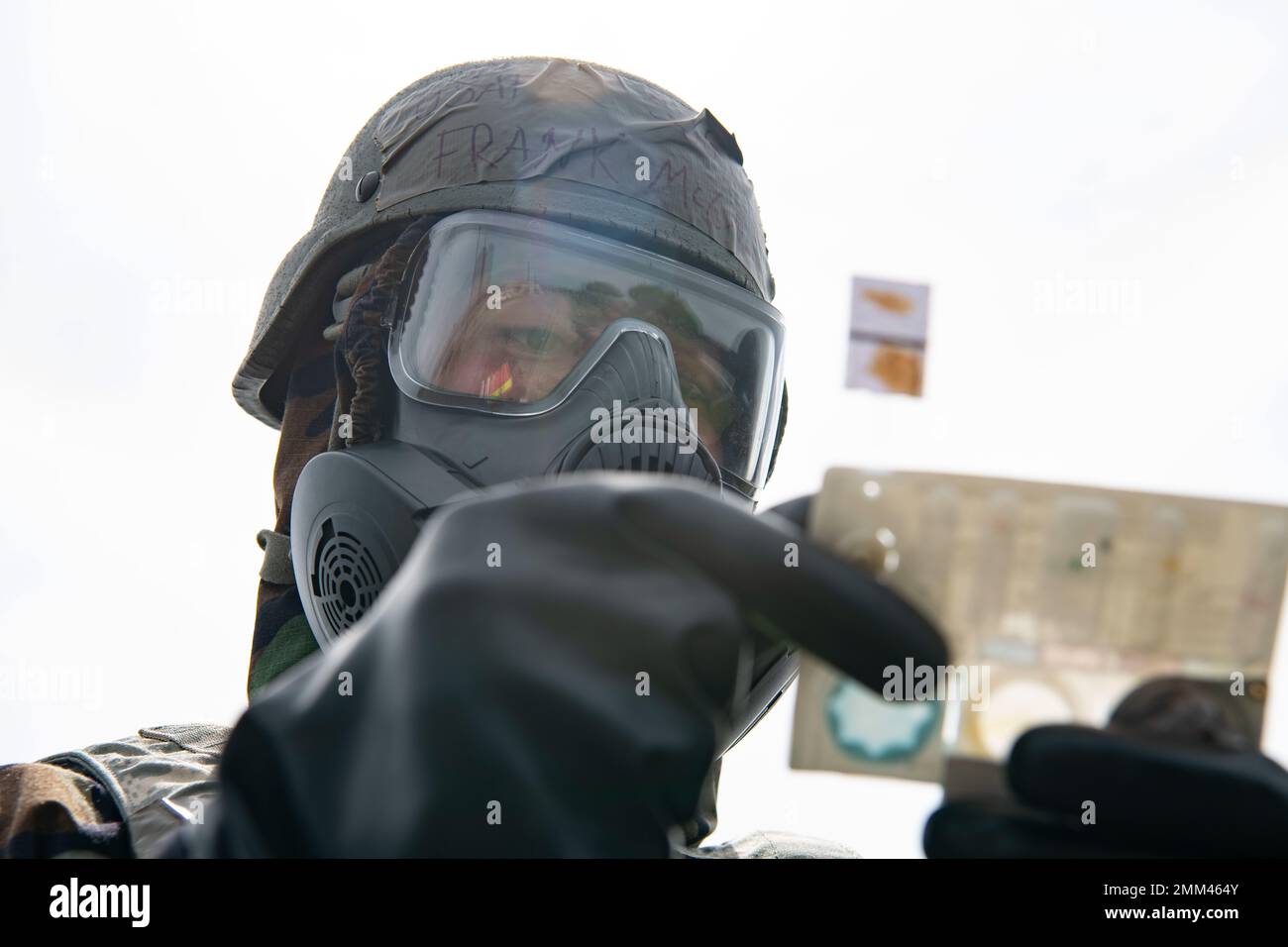 U.S. Air Force Staff Sgt. Frank McCall, 8th Healthcare Operations Squadron bioenvironmental engineering technician, reads an M265 detector kit during a training event at Kunsan Air Base, Republic of Korea, Sept. 14, 2022. During the training scenario, the bioenvironmental engineering flight responded to different locations around the installation to conduct readings and to identify possible chemical attacks. Stock Photohttps://www.alamy.com/image-license-details/?v=1https://www.alamy.com/us-air-force-staff-sgt-frank-mccall-8th-healthcare-operations-squadron-bioenvironmental-engineering-technician-reads-an-m265-detector-kit-during-a-training-event-at-kunsan-air-base-republic-of-korea-sept-14-2022-during-the-training-scenario-the-bioenvironmental-engineering-flight-responded-to-different-locations-around-the-installation-to-conduct-readings-and-to-identify-possible-chemical-attacks-image511486443.html
U.S. Air Force Staff Sgt. Frank McCall, 8th Healthcare Operations Squadron bioenvironmental engineering technician, reads an M265 detector kit during a training event at Kunsan Air Base, Republic of Korea, Sept. 14, 2022. During the training scenario, the bioenvironmental engineering flight responded to different locations around the installation to conduct readings and to identify possible chemical attacks. Stock Photohttps://www.alamy.com/image-license-details/?v=1https://www.alamy.com/us-air-force-staff-sgt-frank-mccall-8th-healthcare-operations-squadron-bioenvironmental-engineering-technician-reads-an-m265-detector-kit-during-a-training-event-at-kunsan-air-base-republic-of-korea-sept-14-2022-during-the-training-scenario-the-bioenvironmental-engineering-flight-responded-to-different-locations-around-the-installation-to-conduct-readings-and-to-identify-possible-chemical-attacks-image511486443.htmlRM2MM464Y–U.S. Air Force Staff Sgt. Frank McCall, 8th Healthcare Operations Squadron bioenvironmental engineering technician, reads an M265 detector kit during a training event at Kunsan Air Base, Republic of Korea, Sept. 14, 2022. During the training scenario, the bioenvironmental engineering flight responded to different locations around the installation to conduct readings and to identify possible chemical attacks.
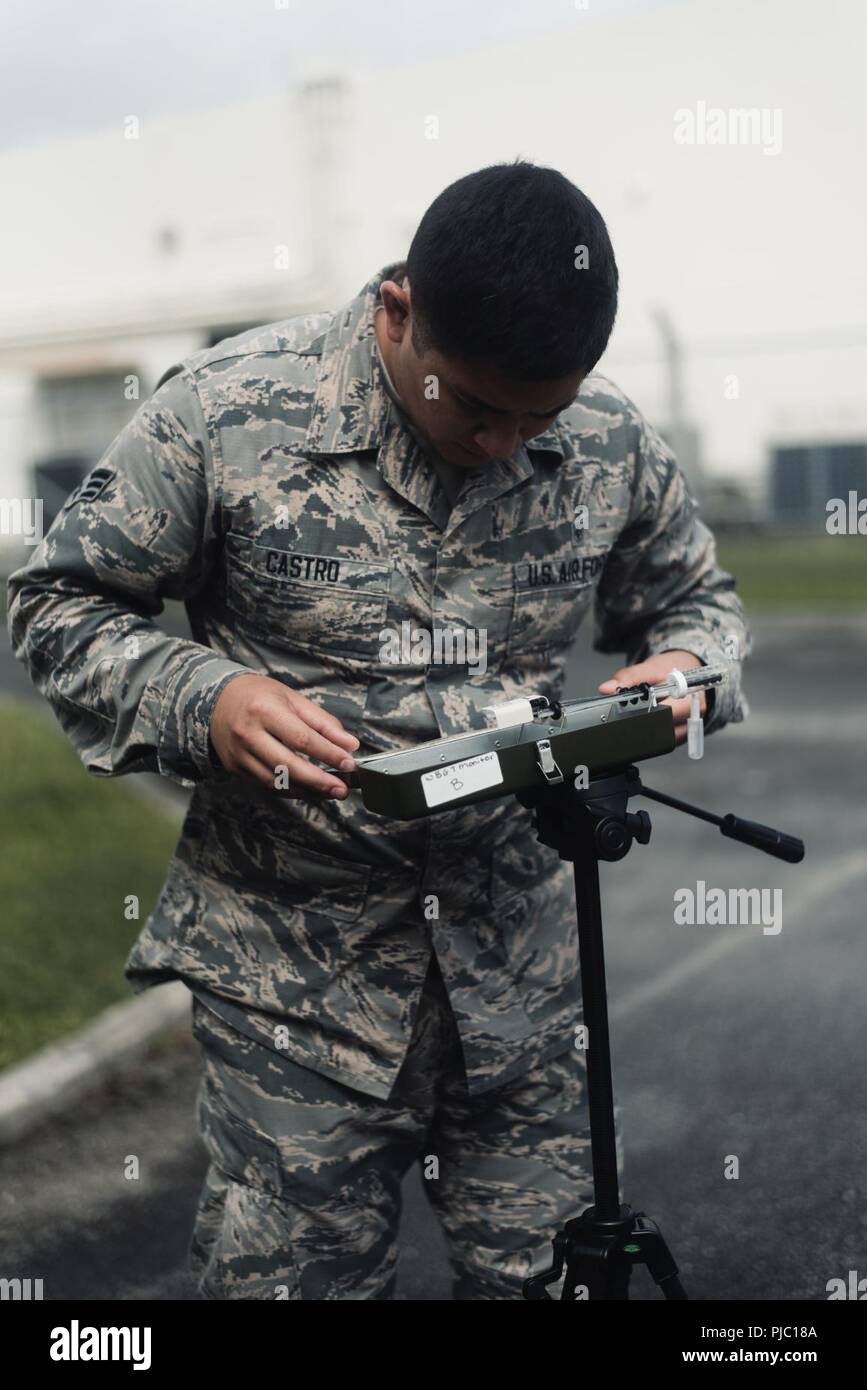 U.S Air Force Senior Airman Rodulfo Castro, 18th Aerospace Medical Squadron bioenvironmental engineering technician, checks the current flag condition using a manual Wet Bulb Globe Temperature Meter July 17, 2018, at Kadena Air Base, Japan. The 18th AMS Bioenvironmental Engineering Flight prevents heat-related injuries through education and monitoring. Stock Photohttps://www.alamy.com/image-license-details/?v=1https://www.alamy.com/us-air-force-senior-airman-rodulfo-castro-18th-aerospace-medical-squadron-bioenvironmental-engineering-technician-checks-the-current-flag-condition-using-a-manual-wet-bulb-globe-temperature-meter-july-17-2018-at-kadena-air-base-japan-the-18th-ams-bioenvironmental-engineering-flight-prevents-heat-related-injuries-through-education-and-monitoring-image217852666.html
U.S Air Force Senior Airman Rodulfo Castro, 18th Aerospace Medical Squadron bioenvironmental engineering technician, checks the current flag condition using a manual Wet Bulb Globe Temperature Meter July 17, 2018, at Kadena Air Base, Japan. The 18th AMS Bioenvironmental Engineering Flight prevents heat-related injuries through education and monitoring. Stock Photohttps://www.alamy.com/image-license-details/?v=1https://www.alamy.com/us-air-force-senior-airman-rodulfo-castro-18th-aerospace-medical-squadron-bioenvironmental-engineering-technician-checks-the-current-flag-condition-using-a-manual-wet-bulb-globe-temperature-meter-july-17-2018-at-kadena-air-base-japan-the-18th-ams-bioenvironmental-engineering-flight-prevents-heat-related-injuries-through-education-and-monitoring-image217852666.htmlRMPJC18A–U.S Air Force Senior Airman Rodulfo Castro, 18th Aerospace Medical Squadron bioenvironmental engineering technician, checks the current flag condition using a manual Wet Bulb Globe Temperature Meter July 17, 2018, at Kadena Air Base, Japan. The 18th AMS Bioenvironmental Engineering Flight prevents heat-related injuries through education and monitoring.
 U.S. Air Force Staff Sgt. Frank McCall, 8th Healthcare Operations Squadron bioenvironmental engineering technician, reads an M265 detector kit during a training event at Kunsan Air Base, Republic of Korea, Sept. 14, 2022. During the training scenario, the bioenvironmental engineering flight responded to different locations around the installation to conduct readings and to identify possible chemical attacks. Stock Photohttps://www.alamy.com/image-license-details/?v=1https://www.alamy.com/us-air-force-staff-sgt-frank-mccall-8th-healthcare-operations-squadron-bioenvironmental-engineering-technician-reads-an-m265-detector-kit-during-a-training-event-at-kunsan-air-base-republic-of-korea-sept-14-2022-during-the-training-scenario-the-bioenvironmental-engineering-flight-responded-to-different-locations-around-the-installation-to-conduct-readings-and-to-identify-possible-chemical-attacks-image491449402.html
U.S. Air Force Staff Sgt. Frank McCall, 8th Healthcare Operations Squadron bioenvironmental engineering technician, reads an M265 detector kit during a training event at Kunsan Air Base, Republic of Korea, Sept. 14, 2022. During the training scenario, the bioenvironmental engineering flight responded to different locations around the installation to conduct readings and to identify possible chemical attacks. Stock Photohttps://www.alamy.com/image-license-details/?v=1https://www.alamy.com/us-air-force-staff-sgt-frank-mccall-8th-healthcare-operations-squadron-bioenvironmental-engineering-technician-reads-an-m265-detector-kit-during-a-training-event-at-kunsan-air-base-republic-of-korea-sept-14-2022-during-the-training-scenario-the-bioenvironmental-engineering-flight-responded-to-different-locations-around-the-installation-to-conduct-readings-and-to-identify-possible-chemical-attacks-image491449402.htmlRM2KFFCMA–U.S. Air Force Staff Sgt. Frank McCall, 8th Healthcare Operations Squadron bioenvironmental engineering technician, reads an M265 detector kit during a training event at Kunsan Air Base, Republic of Korea, Sept. 14, 2022. During the training scenario, the bioenvironmental engineering flight responded to different locations around the installation to conduct readings and to identify possible chemical attacks.
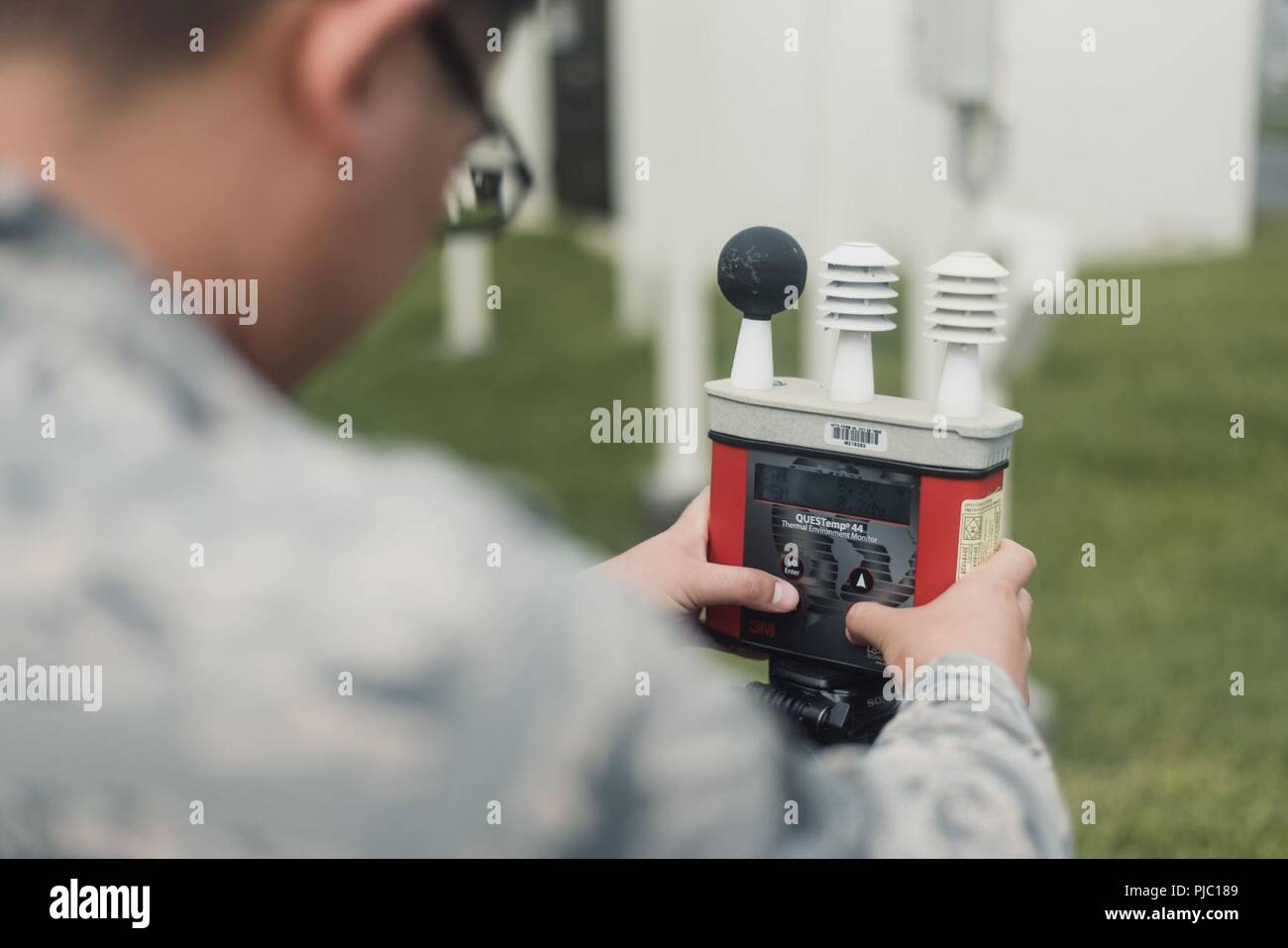 U.S Air Force Senior Airman Rodulfo Castro, 18th Aerospace Medical Squadron bioenvironmental engineering technician, calibrates an electronic Wet Bulb Globe Temperature meter July 17, 2018, at Kadena Air Base, Japan. The 18th Aerospace Medical Squadron’s Bioenvironmental Engineering Flight uses Wet Bulb Globe Temperature Meters to monitor humidity, radiant and dry heat. Stock Photohttps://www.alamy.com/image-license-details/?v=1https://www.alamy.com/us-air-force-senior-airman-rodulfo-castro-18th-aerospace-medical-squadron-bioenvironmental-engineering-technician-calibrates-an-electronic-wet-bulb-globe-temperature-meter-july-17-2018-at-kadena-air-base-japan-the-18th-aerospace-medical-squadrons-bioenvironmental-engineering-flight-uses-wet-bulb-globe-temperature-meters-to-monitor-humidity-radiant-and-dry-heat-image217852665.html
U.S Air Force Senior Airman Rodulfo Castro, 18th Aerospace Medical Squadron bioenvironmental engineering technician, calibrates an electronic Wet Bulb Globe Temperature meter July 17, 2018, at Kadena Air Base, Japan. The 18th Aerospace Medical Squadron’s Bioenvironmental Engineering Flight uses Wet Bulb Globe Temperature Meters to monitor humidity, radiant and dry heat. Stock Photohttps://www.alamy.com/image-license-details/?v=1https://www.alamy.com/us-air-force-senior-airman-rodulfo-castro-18th-aerospace-medical-squadron-bioenvironmental-engineering-technician-calibrates-an-electronic-wet-bulb-globe-temperature-meter-july-17-2018-at-kadena-air-base-japan-the-18th-aerospace-medical-squadrons-bioenvironmental-engineering-flight-uses-wet-bulb-globe-temperature-meters-to-monitor-humidity-radiant-and-dry-heat-image217852665.htmlRMPJC189–U.S Air Force Senior Airman Rodulfo Castro, 18th Aerospace Medical Squadron bioenvironmental engineering technician, calibrates an electronic Wet Bulb Globe Temperature meter July 17, 2018, at Kadena Air Base, Japan. The 18th Aerospace Medical Squadron’s Bioenvironmental Engineering Flight uses Wet Bulb Globe Temperature Meters to monitor humidity, radiant and dry heat.
 Tim Nguyen, 934 AW Bioenvironmental Engineering Flight industrial hygienist, uses a massage chair during a work break at the new wellness center at the Minneapolis-St. Paul Air Reserve Station, Minnesota on Oct. 5, 2022. Stock Photohttps://www.alamy.com/image-license-details/?v=1https://www.alamy.com/tim-nguyen-934-aw-bioenvironmental-engineering-flight-industrial-hygienist-uses-a-massage-chair-during-a-work-break-at-the-new-wellness-center-at-the-minneapolis-st-paul-air-reserve-station-minnesota-on-oct-5-2022-image491854388.html
Tim Nguyen, 934 AW Bioenvironmental Engineering Flight industrial hygienist, uses a massage chair during a work break at the new wellness center at the Minneapolis-St. Paul Air Reserve Station, Minnesota on Oct. 5, 2022. Stock Photohttps://www.alamy.com/image-license-details/?v=1https://www.alamy.com/tim-nguyen-934-aw-bioenvironmental-engineering-flight-industrial-hygienist-uses-a-massage-chair-during-a-work-break-at-the-new-wellness-center-at-the-minneapolis-st-paul-air-reserve-station-minnesota-on-oct-5-2022-image491854388.htmlRM2KG5W84–Tim Nguyen, 934 AW Bioenvironmental Engineering Flight industrial hygienist, uses a massage chair during a work break at the new wellness center at the Minneapolis-St. Paul Air Reserve Station, Minnesota on Oct. 5, 2022.
 A U.S. Airman assigned to the 673d Civil Engineer Group gives a biological operations demonstration to civic leaders with the Department of the Air Force during the DAF civic leader tour at Joint Base Elmendorf-Richardson, Alaska, June 22, 2022. The Bioenvironmental Engineering Flight handles base hazardous material responses and has the capability to respond to an event in as low as 30 minutes. Stock Photohttps://www.alamy.com/image-license-details/?v=1https://www.alamy.com/a-us-airman-assigned-to-the-673d-civil-engineer-group-gives-a-biological-operations-demonstration-to-civic-leaders-with-the-department-of-the-air-force-during-the-daf-civic-leader-tour-at-joint-base-elmendorf-richardson-alaska-june-22-2022-the-bioenvironmental-engineering-flight-handles-base-hazardous-material-responses-and-has-the-capability-to-respond-to-an-event-in-as-low-as-30-minutes-image506436894.html
A U.S. Airman assigned to the 673d Civil Engineer Group gives a biological operations demonstration to civic leaders with the Department of the Air Force during the DAF civic leader tour at Joint Base Elmendorf-Richardson, Alaska, June 22, 2022. The Bioenvironmental Engineering Flight handles base hazardous material responses and has the capability to respond to an event in as low as 30 minutes. Stock Photohttps://www.alamy.com/image-license-details/?v=1https://www.alamy.com/a-us-airman-assigned-to-the-673d-civil-engineer-group-gives-a-biological-operations-demonstration-to-civic-leaders-with-the-department-of-the-air-force-during-the-daf-civic-leader-tour-at-joint-base-elmendorf-richardson-alaska-june-22-2022-the-bioenvironmental-engineering-flight-handles-base-hazardous-material-responses-and-has-the-capability-to-respond-to-an-event-in-as-low-as-30-minutes-image506436894.htmlRM2MBX5BX–A U.S. Airman assigned to the 673d Civil Engineer Group gives a biological operations demonstration to civic leaders with the Department of the Air Force during the DAF civic leader tour at Joint Base Elmendorf-Richardson, Alaska, June 22, 2022. The Bioenvironmental Engineering Flight handles base hazardous material responses and has the capability to respond to an event in as low as 30 minutes.
 Airman 1st Class Briana McIver, left, 23d Aerospace Medicine Squadron (AMDS) bioenvironmental engineering apprentice, secures 2nd Lt. Eric Olson, 23d AMDS bioenvironmental engineer, in a Level A suit during readiness training, Jan. 12, 2018, at Moody Air Force Base, Ga. A Level A suit is designed to protect the user against any biological threat. The Bioenvironmental Engineering Flight tested their response capabilities in a simulated contamination scenario. Bioenvironmental engineering specialists focus on reducing health hazards in the workplace and surrounding areas. Stock Photohttps://www.alamy.com/image-license-details/?v=1https://www.alamy.com/airman-1st-class-briana-mciver-left-23d-aerospace-medicine-squadron-amds-bioenvironmental-engineering-apprentice-secures-2nd-lt-eric-olson-23d-amds-bioenvironmental-engineer-in-a-level-a-suit-during-readiness-training-jan-12-2018-at-moody-air-force-base-ga-a-level-a-suit-is-designed-to-protect-the-user-against-any-biological-threat-the-bioenvironmental-engineering-flight-tested-their-response-capabilities-in-a-simulated-contamination-scenario-bioenvironmental-engineering-specialists-focus-on-reducing-health-hazards-in-the-workplace-and-surrounding-areas-image235078618.html
Airman 1st Class Briana McIver, left, 23d Aerospace Medicine Squadron (AMDS) bioenvironmental engineering apprentice, secures 2nd Lt. Eric Olson, 23d AMDS bioenvironmental engineer, in a Level A suit during readiness training, Jan. 12, 2018, at Moody Air Force Base, Ga. A Level A suit is designed to protect the user against any biological threat. The Bioenvironmental Engineering Flight tested their response capabilities in a simulated contamination scenario. Bioenvironmental engineering specialists focus on reducing health hazards in the workplace and surrounding areas. Stock Photohttps://www.alamy.com/image-license-details/?v=1https://www.alamy.com/airman-1st-class-briana-mciver-left-23d-aerospace-medicine-squadron-amds-bioenvironmental-engineering-apprentice-secures-2nd-lt-eric-olson-23d-amds-bioenvironmental-engineer-in-a-level-a-suit-during-readiness-training-jan-12-2018-at-moody-air-force-base-ga-a-level-a-suit-is-designed-to-protect-the-user-against-any-biological-threat-the-bioenvironmental-engineering-flight-tested-their-response-capabilities-in-a-simulated-contamination-scenario-bioenvironmental-engineering-specialists-focus-on-reducing-health-hazards-in-the-workplace-and-surrounding-areas-image235078618.htmlRMRJCN4X–Airman 1st Class Briana McIver, left, 23d Aerospace Medicine Squadron (AMDS) bioenvironmental engineering apprentice, secures 2nd Lt. Eric Olson, 23d AMDS bioenvironmental engineer, in a Level A suit during readiness training, Jan. 12, 2018, at Moody Air Force Base, Ga. A Level A suit is designed to protect the user against any biological threat. The Bioenvironmental Engineering Flight tested their response capabilities in a simulated contamination scenario. Bioenvironmental engineering specialists focus on reducing health hazards in the workplace and surrounding areas.
 A U.S. Airman assigned to the 673d Civil Engineer Group gives a biological operations demonstration to civic leaders with the Department of the Air Force during the DAF civic leader tour at Joint Base Elmendorf-Richardson, Alaska, June 22, 2022. The Bioenvironmental Engineering Flight handles base hazardous material responses and has the capability to respond to an event in as low as 30 minutes. Stock Photohttps://www.alamy.com/image-license-details/?v=1https://www.alamy.com/a-us-airman-assigned-to-the-673d-civil-engineer-group-gives-a-biological-operations-demonstration-to-civic-leaders-with-the-department-of-the-air-force-during-the-daf-civic-leader-tour-at-joint-base-elmendorf-richardson-alaska-june-22-2022-the-bioenvironmental-engineering-flight-handles-base-hazardous-material-responses-and-has-the-capability-to-respond-to-an-event-in-as-low-as-30-minutes-image506437265.html
A U.S. Airman assigned to the 673d Civil Engineer Group gives a biological operations demonstration to civic leaders with the Department of the Air Force during the DAF civic leader tour at Joint Base Elmendorf-Richardson, Alaska, June 22, 2022. The Bioenvironmental Engineering Flight handles base hazardous material responses and has the capability to respond to an event in as low as 30 minutes. Stock Photohttps://www.alamy.com/image-license-details/?v=1https://www.alamy.com/a-us-airman-assigned-to-the-673d-civil-engineer-group-gives-a-biological-operations-demonstration-to-civic-leaders-with-the-department-of-the-air-force-during-the-daf-civic-leader-tour-at-joint-base-elmendorf-richardson-alaska-june-22-2022-the-bioenvironmental-engineering-flight-handles-base-hazardous-material-responses-and-has-the-capability-to-respond-to-an-event-in-as-low-as-30-minutes-image506437265.htmlRM2MBX5W5–A U.S. Airman assigned to the 673d Civil Engineer Group gives a biological operations demonstration to civic leaders with the Department of the Air Force during the DAF civic leader tour at Joint Base Elmendorf-Richardson, Alaska, June 22, 2022. The Bioenvironmental Engineering Flight handles base hazardous material responses and has the capability to respond to an event in as low as 30 minutes.
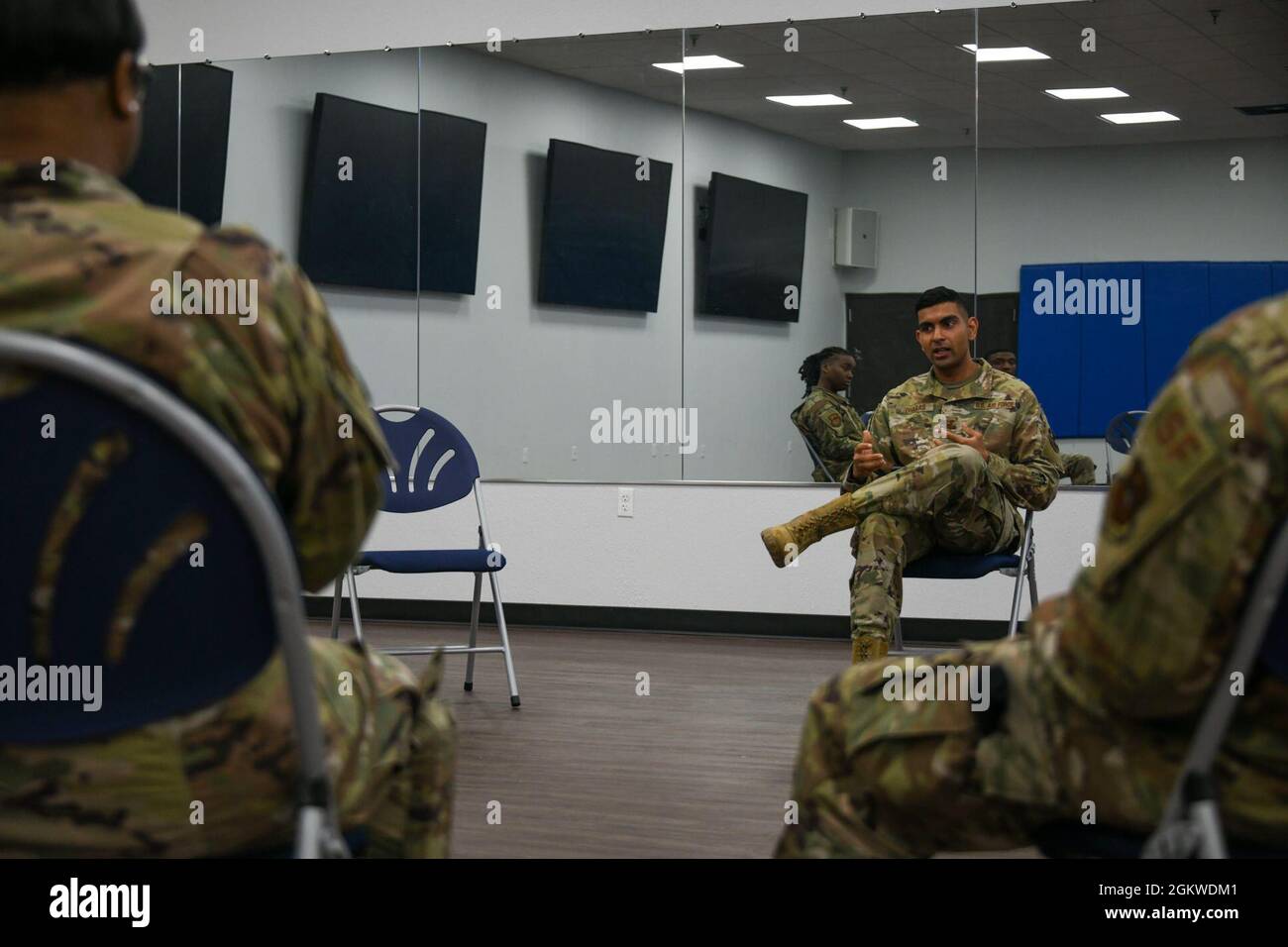 U.S. Air Force Capt. Mohamed Dharas, 97th Operational Medical Readiness Squadron Bioenvironmental Engineering Flight commander, leads a meeting of the Diversity and Inclusion (D&I) Working Group at Altus Air Force Base, Oklahoma, on June 8 2021. Dharas is the manager of the D&I program for the base and the group is tasked with providing a foundation for understanding and long-term change for Airmen. Stock Photohttps://www.alamy.com/image-license-details/?v=1https://www.alamy.com/us-air-force-capt-mohamed-dharas-97th-operational-medical-readiness-squadron-bioenvironmental-engineering-flight-commander-leads-a-meeting-of-the-diversity-and-inclusion-di-working-group-at-altus-air-force-base-oklahoma-on-june-8-2021-dharas-is-the-manager-of-the-di-program-for-the-base-and-the-group-is-tasked-with-providing-a-foundation-for-understanding-and-long-term-change-for-airmen-image442497217.html
U.S. Air Force Capt. Mohamed Dharas, 97th Operational Medical Readiness Squadron Bioenvironmental Engineering Flight commander, leads a meeting of the Diversity and Inclusion (D&I) Working Group at Altus Air Force Base, Oklahoma, on June 8 2021. Dharas is the manager of the D&I program for the base and the group is tasked with providing a foundation for understanding and long-term change for Airmen. Stock Photohttps://www.alamy.com/image-license-details/?v=1https://www.alamy.com/us-air-force-capt-mohamed-dharas-97th-operational-medical-readiness-squadron-bioenvironmental-engineering-flight-commander-leads-a-meeting-of-the-diversity-and-inclusion-di-working-group-at-altus-air-force-base-oklahoma-on-june-8-2021-dharas-is-the-manager-of-the-di-program-for-the-base-and-the-group-is-tasked-with-providing-a-foundation-for-understanding-and-long-term-change-for-airmen-image442497217.htmlRM2GKWDM1–U.S. Air Force Capt. Mohamed Dharas, 97th Operational Medical Readiness Squadron Bioenvironmental Engineering Flight commander, leads a meeting of the Diversity and Inclusion (D&I) Working Group at Altus Air Force Base, Oklahoma, on June 8 2021. Dharas is the manager of the D&I program for the base and the group is tasked with providing a foundation for understanding and long-term change for Airmen.
 ROBINS AIR FORCE BASE, Ga. – Airman Taegan Thomas, 78th Bioenvironmental Engineering Flight journeyman, performs a respirator fit test at Robins Air Force Base, Georgia, Feb. 9, 2021. Testers, like Airman Thomas, use an irritant smoke to detect leakage into a respirator or mask. Individuals are asked to perform different movements to make sure the personal protective equipment fits correctly. Stock Photohttps://www.alamy.com/image-license-details/?v=1https://www.alamy.com/robins-air-force-base-ga-airman-taegan-thomas-78th-bioenvironmental-engineering-flight-journeyman-performs-a-respirator-fit-test-at-robins-air-force-base-georgia-feb-9-2021-testers-like-airman-thomas-use-an-irritant-smoke-to-detect-leakage-into-a-respirator-or-mask-individuals-are-asked-to-perform-different-movements-to-make-sure-the-personal-protective-equipment-fits-correctly-image447785538.html
ROBINS AIR FORCE BASE, Ga. – Airman Taegan Thomas, 78th Bioenvironmental Engineering Flight journeyman, performs a respirator fit test at Robins Air Force Base, Georgia, Feb. 9, 2021. Testers, like Airman Thomas, use an irritant smoke to detect leakage into a respirator or mask. Individuals are asked to perform different movements to make sure the personal protective equipment fits correctly. Stock Photohttps://www.alamy.com/image-license-details/?v=1https://www.alamy.com/robins-air-force-base-ga-airman-taegan-thomas-78th-bioenvironmental-engineering-flight-journeyman-performs-a-respirator-fit-test-at-robins-air-force-base-georgia-feb-9-2021-testers-like-airman-thomas-use-an-irritant-smoke-to-detect-leakage-into-a-respirator-or-mask-individuals-are-asked-to-perform-different-movements-to-make-sure-the-personal-protective-equipment-fits-correctly-image447785538.htmlRM2H0EB0J–ROBINS AIR FORCE BASE, Ga. – Airman Taegan Thomas, 78th Bioenvironmental Engineering Flight journeyman, performs a respirator fit test at Robins Air Force Base, Georgia, Feb. 9, 2021. Testers, like Airman Thomas, use an irritant smoke to detect leakage into a respirator or mask. Individuals are asked to perform different movements to make sure the personal protective equipment fits correctly.
 Brig. Gen. Jeannine Ryder, 59th Medical Wing commander, receives a briefing from Lt. Col. Brian Clarke, 559th Medical Group bioenvironmental engineering flight commander, during a walkthrough of the group, May 13, 2021 at Joint Base San Antonio Lackland, Texas. Ryder, who took command of the 59 MDW on April 29, is visiting each of the wing’s six groups to hear from teams firsthand. Stock Photohttps://www.alamy.com/image-license-details/?v=1https://www.alamy.com/brig-gen-jeannine-ryder-59th-medical-wing-commander-receives-a-briefing-from-lt-col-brian-clarke-559th-medical-group-bioenvironmental-engineering-flight-commander-during-a-walkthrough-of-the-group-may-13-2021-at-joint-base-san-antonio-lackland-texas-ryder-who-took-command-of-the-59-mdw-on-april-29-is-visiting-each-of-the-wings-six-groups-to-hear-from-teams-firsthand-image442361431.html
Brig. Gen. Jeannine Ryder, 59th Medical Wing commander, receives a briefing from Lt. Col. Brian Clarke, 559th Medical Group bioenvironmental engineering flight commander, during a walkthrough of the group, May 13, 2021 at Joint Base San Antonio Lackland, Texas. Ryder, who took command of the 59 MDW on April 29, is visiting each of the wing’s six groups to hear from teams firsthand. Stock Photohttps://www.alamy.com/image-license-details/?v=1https://www.alamy.com/brig-gen-jeannine-ryder-59th-medical-wing-commander-receives-a-briefing-from-lt-col-brian-clarke-559th-medical-group-bioenvironmental-engineering-flight-commander-during-a-walkthrough-of-the-group-may-13-2021-at-joint-base-san-antonio-lackland-texas-ryder-who-took-command-of-the-59-mdw-on-april-29-is-visiting-each-of-the-wings-six-groups-to-hear-from-teams-firsthand-image442361431.htmlRM2GKK8EF–Brig. Gen. Jeannine Ryder, 59th Medical Wing commander, receives a briefing from Lt. Col. Brian Clarke, 559th Medical Group bioenvironmental engineering flight commander, during a walkthrough of the group, May 13, 2021 at Joint Base San Antonio Lackland, Texas. Ryder, who took command of the 59 MDW on April 29, is visiting each of the wing’s six groups to hear from teams firsthand.
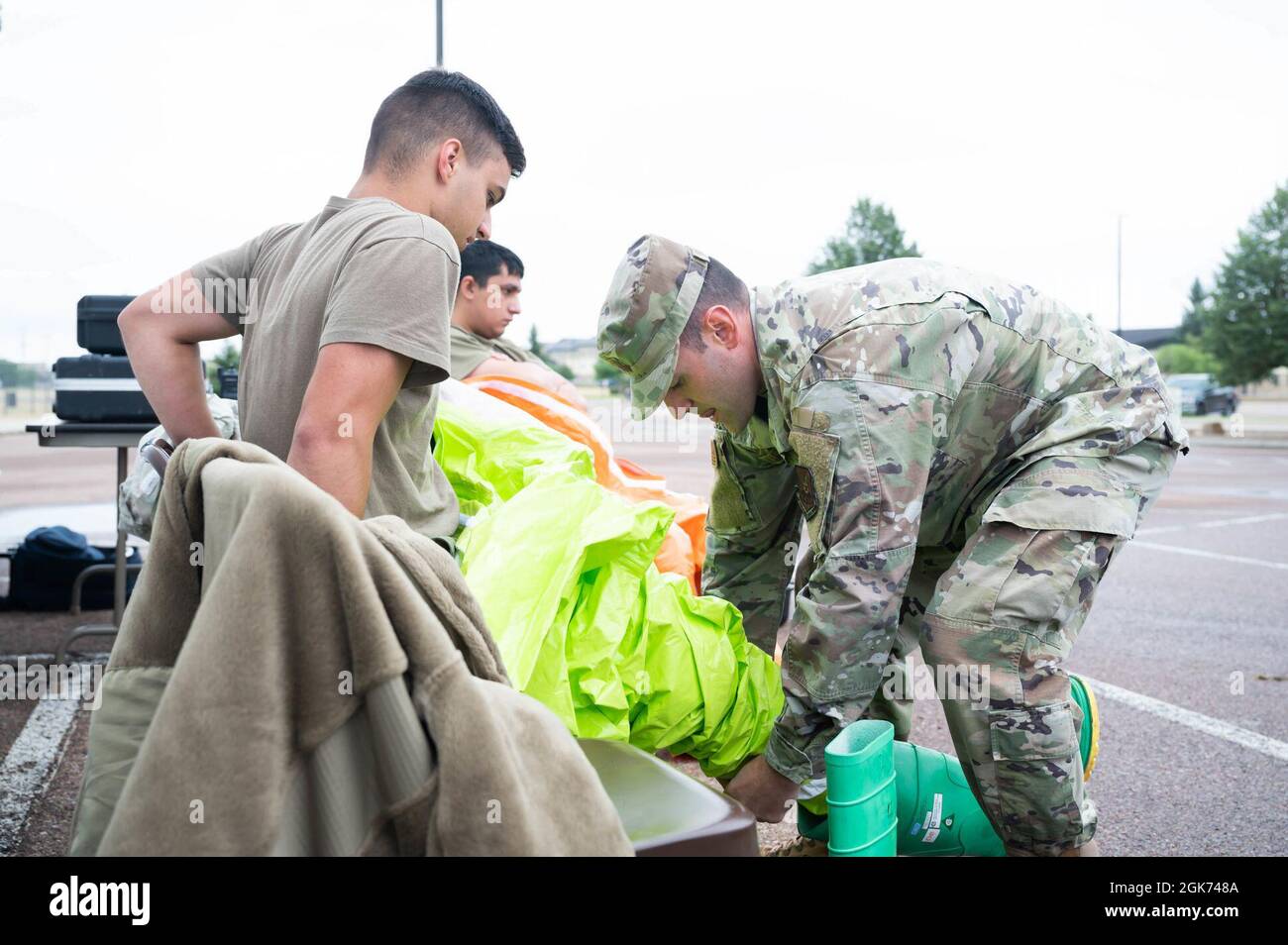 Capt. Daniel Wilkinson, right, 341st Operational Medical Readiness Squadron bioenvironmental engineering flight commander, helps Airman 1st Class Dylan Baggett, left, 341st OMRS bioenvironmental engineer apprentice, don a Level A fully encapsulating suit during a medical readiness exercise Aug. 20, 2021, at Malmstrom Air Force Base, Mont. During the exercise scenario, bioenvironmental was responsible for checking the scene for simulated chemical contaminants. Stock Photohttps://www.alamy.com/image-license-details/?v=1https://www.alamy.com/capt-daniel-wilkinson-right-341st-operational-medical-readiness-squadron-bioenvironmental-engineering-flight-commander-helps-airman-1st-class-dylan-baggett-left-341st-omrs-bioenvironmental-engineer-apprentice-don-a-level-a-fully-encapsulating-suit-during-a-medical-readiness-exercise-aug-20-2021-at-malmstrom-air-force-base-mont-during-the-exercise-scenario-bioenvironmental-was-responsible-for-checking-the-scene-for-simulated-chemical-contaminants-image442094698.html
Capt. Daniel Wilkinson, right, 341st Operational Medical Readiness Squadron bioenvironmental engineering flight commander, helps Airman 1st Class Dylan Baggett, left, 341st OMRS bioenvironmental engineer apprentice, don a Level A fully encapsulating suit during a medical readiness exercise Aug. 20, 2021, at Malmstrom Air Force Base, Mont. During the exercise scenario, bioenvironmental was responsible for checking the scene for simulated chemical contaminants. Stock Photohttps://www.alamy.com/image-license-details/?v=1https://www.alamy.com/capt-daniel-wilkinson-right-341st-operational-medical-readiness-squadron-bioenvironmental-engineering-flight-commander-helps-airman-1st-class-dylan-baggett-left-341st-omrs-bioenvironmental-engineer-apprentice-don-a-level-a-fully-encapsulating-suit-during-a-medical-readiness-exercise-aug-20-2021-at-malmstrom-air-force-base-mont-during-the-exercise-scenario-bioenvironmental-was-responsible-for-checking-the-scene-for-simulated-chemical-contaminants-image442094698.htmlRM2GK748A–Capt. Daniel Wilkinson, right, 341st Operational Medical Readiness Squadron bioenvironmental engineering flight commander, helps Airman 1st Class Dylan Baggett, left, 341st OMRS bioenvironmental engineer apprentice, don a Level A fully encapsulating suit during a medical readiness exercise Aug. 20, 2021, at Malmstrom Air Force Base, Mont. During the exercise scenario, bioenvironmental was responsible for checking the scene for simulated chemical contaminants.
 A chemical, biological, radiological and nuclear team, assigned to the 28th Civil Engineer Squadron, and the bioenvironmental engineering flight, assigned to the 28th Medical Group, conduct chemical agent tests during a training scenario for exercise Ready Eagle on Ellsworth Air Force Base, S.D., May 14, 2021. The teams were called upon after simulated victims involved in the mass casualty exercise showed signs of possible chemical exposure. Stock Photohttps://www.alamy.com/image-license-details/?v=1https://www.alamy.com/a-chemical-biological-radiological-and-nuclear-team-assigned-to-the-28th-civil-engineer-squadron-and-the-bioenvironmental-engineering-flight-assigned-to-the-28th-medical-group-conduct-chemical-agent-tests-during-a-training-scenario-for-exercise-ready-eagle-on-ellsworth-air-force-base-sd-may-14-2021-the-teams-were-called-upon-after-simulated-victims-involved-in-the-mass-casualty-exercise-showed-signs-of-possible-chemical-exposure-image442364508.html
A chemical, biological, radiological and nuclear team, assigned to the 28th Civil Engineer Squadron, and the bioenvironmental engineering flight, assigned to the 28th Medical Group, conduct chemical agent tests during a training scenario for exercise Ready Eagle on Ellsworth Air Force Base, S.D., May 14, 2021. The teams were called upon after simulated victims involved in the mass casualty exercise showed signs of possible chemical exposure. Stock Photohttps://www.alamy.com/image-license-details/?v=1https://www.alamy.com/a-chemical-biological-radiological-and-nuclear-team-assigned-to-the-28th-civil-engineer-squadron-and-the-bioenvironmental-engineering-flight-assigned-to-the-28th-medical-group-conduct-chemical-agent-tests-during-a-training-scenario-for-exercise-ready-eagle-on-ellsworth-air-force-base-sd-may-14-2021-the-teams-were-called-upon-after-simulated-victims-involved-in-the-mass-casualty-exercise-showed-signs-of-possible-chemical-exposure-image442364508.htmlRM2GKKCCC–A chemical, biological, radiological and nuclear team, assigned to the 28th Civil Engineer Squadron, and the bioenvironmental engineering flight, assigned to the 28th Medical Group, conduct chemical agent tests during a training scenario for exercise Ready Eagle on Ellsworth Air Force Base, S.D., May 14, 2021. The teams were called upon after simulated victims involved in the mass casualty exercise showed signs of possible chemical exposure.
 Staff Sgts. Linda Boateng (left), and Frank McCall, 8th Healthcare Operations Squadron (HCOS) bioenvironmental engineer technicians, record radiation readings during a training event at Kunsan Air Base, Republic of Korea, Feb. 9, 2023. In a real-world scenario, 8th HCOS bioenvironmental engineering flight personnel would set up several ADM300 multifunction survey meters around the installation, frequently taking readings until the air was deemed safe. Stock Photohttps://www.alamy.com/image-license-details/?v=1https://www.alamy.com/staff-sgts-linda-boateng-left-and-frank-mccall-8th-healthcare-operations-squadron-hcos-bioenvironmental-engineer-technicians-record-radiation-readings-during-a-training-event-at-kunsan-air-base-republic-of-korea-feb-9-2023-in-a-real-world-scenario-8th-hcos-bioenvironmental-engineering-flight-personnel-would-set-up-several-adm300-multifunction-survey-meters-around-the-installation-frequently-taking-readings-until-the-air-was-deemed-safe-image533265317.html
Staff Sgts. Linda Boateng (left), and Frank McCall, 8th Healthcare Operations Squadron (HCOS) bioenvironmental engineer technicians, record radiation readings during a training event at Kunsan Air Base, Republic of Korea, Feb. 9, 2023. In a real-world scenario, 8th HCOS bioenvironmental engineering flight personnel would set up several ADM300 multifunction survey meters around the installation, frequently taking readings until the air was deemed safe. Stock Photohttps://www.alamy.com/image-license-details/?v=1https://www.alamy.com/staff-sgts-linda-boateng-left-and-frank-mccall-8th-healthcare-operations-squadron-hcos-bioenvironmental-engineer-technicians-record-radiation-readings-during-a-training-event-at-kunsan-air-base-republic-of-korea-feb-9-2023-in-a-real-world-scenario-8th-hcos-bioenvironmental-engineering-flight-personnel-would-set-up-several-adm300-multifunction-survey-meters-around-the-installation-frequently-taking-readings-until-the-air-was-deemed-safe-image533265317.htmlRM2NYG99W–Staff Sgts. Linda Boateng (left), and Frank McCall, 8th Healthcare Operations Squadron (HCOS) bioenvironmental engineer technicians, record radiation readings during a training event at Kunsan Air Base, Republic of Korea, Feb. 9, 2023. In a real-world scenario, 8th HCOS bioenvironmental engineering flight personnel would set up several ADM300 multifunction survey meters around the installation, frequently taking readings until the air was deemed safe.
 U.S. Air Force 8th Civil Engineer Squadron emergency management (left) and 8th Healthcare Operations Squadron bioenvironmental engineering flight teams, test for contaminants during a training event at Kunsan Air Base, Republic of Korea, Sept. 14, 2022. Following the simulated chemical agent attack, the teams were sent out to further identify the type of chemical agent present and followed up with a containment plan to ensure the simulated attack did not impact the installation’s mission. Stock Photohttps://www.alamy.com/image-license-details/?v=1https://www.alamy.com/us-air-force-8th-civil-engineer-squadron-emergency-management-left-and-8th-healthcare-operations-squadron-bioenvironmental-engineering-flight-teams-test-for-contaminants-during-a-training-event-at-kunsan-air-base-republic-of-korea-sept-14-2022-following-the-simulated-chemical-agent-attack-the-teams-were-sent-out-to-further-identify-the-type-of-chemical-agent-present-and-followed-up-with-a-containment-plan-to-ensure-the-simulated-attack-did-not-impact-the-installations-mission-image511502484.html
U.S. Air Force 8th Civil Engineer Squadron emergency management (left) and 8th Healthcare Operations Squadron bioenvironmental engineering flight teams, test for contaminants during a training event at Kunsan Air Base, Republic of Korea, Sept. 14, 2022. Following the simulated chemical agent attack, the teams were sent out to further identify the type of chemical agent present and followed up with a containment plan to ensure the simulated attack did not impact the installation’s mission. Stock Photohttps://www.alamy.com/image-license-details/?v=1https://www.alamy.com/us-air-force-8th-civil-engineer-squadron-emergency-management-left-and-8th-healthcare-operations-squadron-bioenvironmental-engineering-flight-teams-test-for-contaminants-during-a-training-event-at-kunsan-air-base-republic-of-korea-sept-14-2022-following-the-simulated-chemical-agent-attack-the-teams-were-sent-out-to-further-identify-the-type-of-chemical-agent-present-and-followed-up-with-a-containment-plan-to-ensure-the-simulated-attack-did-not-impact-the-installations-mission-image511502484.htmlRM2MM4XHT–U.S. Air Force 8th Civil Engineer Squadron emergency management (left) and 8th Healthcare Operations Squadron bioenvironmental engineering flight teams, test for contaminants during a training event at Kunsan Air Base, Republic of Korea, Sept. 14, 2022. Following the simulated chemical agent attack, the teams were sent out to further identify the type of chemical agent present and followed up with a containment plan to ensure the simulated attack did not impact the installation’s mission.
 An Airman assigned to the 48th Aerospace Medicine Squadron Bioenvironmental Engineering flight places a water sample in an incubator at Royal Air Force Lakenheath, England, June 19, 2018. The 48th Bioenvironmental Engineering flight uses incubation of water samples as a form of testing for possible contaminants. Stock Photohttps://www.alamy.com/image-license-details/?v=1https://www.alamy.com/an-airman-assigned-to-the-48th-aerospace-medicine-squadron-bioenvironmental-engineering-flight-places-a-water-sample-in-an-incubator-at-royal-air-force-lakenheath-england-june-19-2018-the-48th-bioenvironmental-engineering-flight-uses-incubation-of-water-samples-as-a-form-of-testing-for-possible-contaminants-image216991129.html
An Airman assigned to the 48th Aerospace Medicine Squadron Bioenvironmental Engineering flight places a water sample in an incubator at Royal Air Force Lakenheath, England, June 19, 2018. The 48th Bioenvironmental Engineering flight uses incubation of water samples as a form of testing for possible contaminants. Stock Photohttps://www.alamy.com/image-license-details/?v=1https://www.alamy.com/an-airman-assigned-to-the-48th-aerospace-medicine-squadron-bioenvironmental-engineering-flight-places-a-water-sample-in-an-incubator-at-royal-air-force-lakenheath-england-june-19-2018-the-48th-bioenvironmental-engineering-flight-uses-incubation-of-water-samples-as-a-form-of-testing-for-possible-contaminants-image216991129.htmlRMPH0PB5–An Airman assigned to the 48th Aerospace Medicine Squadron Bioenvironmental Engineering flight places a water sample in an incubator at Royal Air Force Lakenheath, England, June 19, 2018. The 48th Bioenvironmental Engineering flight uses incubation of water samples as a form of testing for possible contaminants.
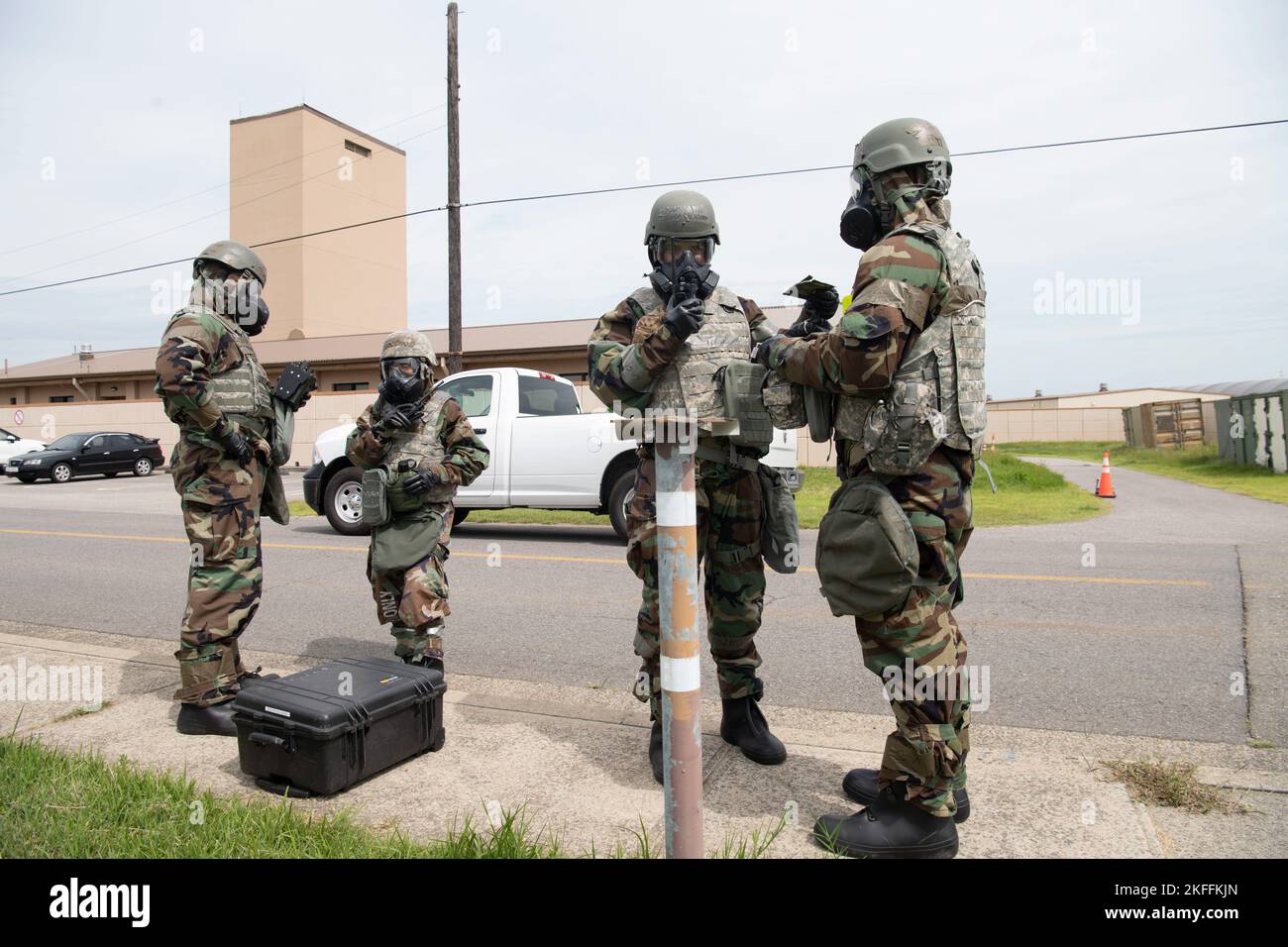 U.S. Air Force 8th Civil Engineer Squadron emergency management (left) and 8th Healthcare Operations Squadron bioenvironmental engineering flight teams, test for contaminants during a training event at Kunsan Air Base, Republic of Korea, Sept. 14, 2022. Following the simulated chemical agent attack, the teams were sent out to further identify the type of chemical agent present and followed up with a containment plan to ensure the simulated attack did not impact the installation’s mission. Stock Photohttps://www.alamy.com/image-license-details/?v=1https://www.alamy.com/us-air-force-8th-civil-engineer-squadron-emergency-management-left-and-8th-healthcare-operations-squadron-bioenvironmental-engineering-flight-teams-test-for-contaminants-during-a-training-event-at-kunsan-air-base-republic-of-korea-sept-14-2022-following-the-simulated-chemical-agent-attack-the-teams-were-sent-out-to-further-identify-the-type-of-chemical-agent-present-and-followed-up-with-a-containment-plan-to-ensure-the-simulated-attack-did-not-impact-the-installations-mission-image491454845.html
U.S. Air Force 8th Civil Engineer Squadron emergency management (left) and 8th Healthcare Operations Squadron bioenvironmental engineering flight teams, test for contaminants during a training event at Kunsan Air Base, Republic of Korea, Sept. 14, 2022. Following the simulated chemical agent attack, the teams were sent out to further identify the type of chemical agent present and followed up with a containment plan to ensure the simulated attack did not impact the installation’s mission. Stock Photohttps://www.alamy.com/image-license-details/?v=1https://www.alamy.com/us-air-force-8th-civil-engineer-squadron-emergency-management-left-and-8th-healthcare-operations-squadron-bioenvironmental-engineering-flight-teams-test-for-contaminants-during-a-training-event-at-kunsan-air-base-republic-of-korea-sept-14-2022-following-the-simulated-chemical-agent-attack-the-teams-were-sent-out-to-further-identify-the-type-of-chemical-agent-present-and-followed-up-with-a-containment-plan-to-ensure-the-simulated-attack-did-not-impact-the-installations-mission-image491454845.htmlRM2KFFKJN–U.S. Air Force 8th Civil Engineer Squadron emergency management (left) and 8th Healthcare Operations Squadron bioenvironmental engineering flight teams, test for contaminants during a training event at Kunsan Air Base, Republic of Korea, Sept. 14, 2022. Following the simulated chemical agent attack, the teams were sent out to further identify the type of chemical agent present and followed up with a containment plan to ensure the simulated attack did not impact the installation’s mission.
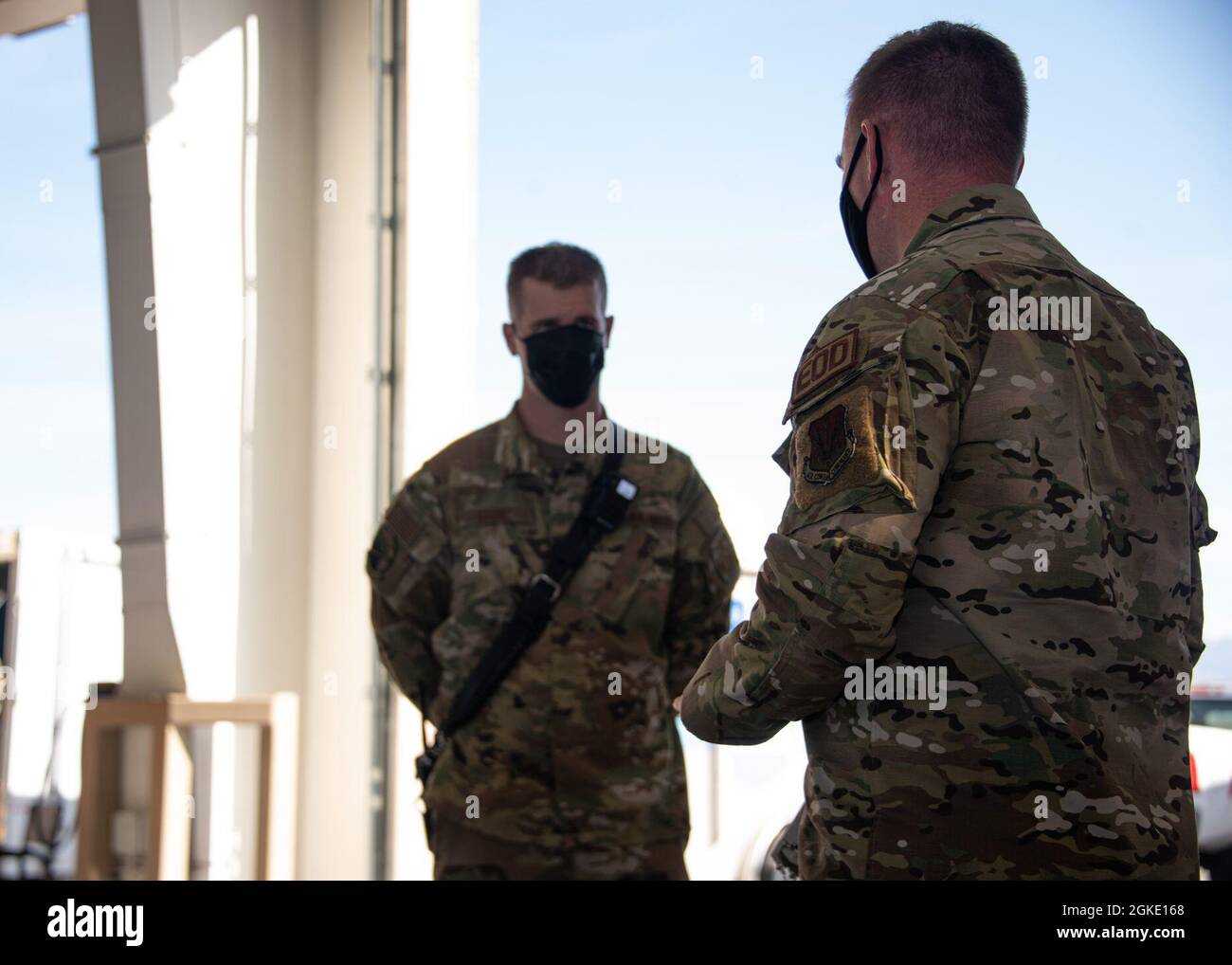 An Airman from the 355th Civil Engineer Squadron Explosive Ordnance Disposal Flight trains another Airman during hazardous material training at Davis-Monthan Air Force Base, Arizona, March 25, 2021. Units from across the 355th Wing, including the 355th Medical Group Bioenvironmental Engineering Flight, 355th CES EOD, 355th CES Fire and Emergency Services Flight, as well as Airmen from the 162nd Wing participated in this training to ensure their capabilities and readiness for any situation. Stock Photohttps://www.alamy.com/image-license-details/?v=1https://www.alamy.com/an-airman-from-the-355th-civil-engineer-squadron-explosive-ordnance-disposal-flight-trains-another-airman-during-hazardous-material-training-at-davis-monthan-air-force-base-arizona-march-25-2021-units-from-across-the-355th-wing-including-the-355th-medical-group-bioenvironmental-engineering-flight-355th-ces-eod-355th-ces-fire-and-emergency-services-flight-as-well-as-airmen-from-the-162nd-wing-participated-in-this-training-to-ensure-their-capabilities-and-readiness-for-any-situation-image442245952.html
An Airman from the 355th Civil Engineer Squadron Explosive Ordnance Disposal Flight trains another Airman during hazardous material training at Davis-Monthan Air Force Base, Arizona, March 25, 2021. Units from across the 355th Wing, including the 355th Medical Group Bioenvironmental Engineering Flight, 355th CES EOD, 355th CES Fire and Emergency Services Flight, as well as Airmen from the 162nd Wing participated in this training to ensure their capabilities and readiness for any situation. Stock Photohttps://www.alamy.com/image-license-details/?v=1https://www.alamy.com/an-airman-from-the-355th-civil-engineer-squadron-explosive-ordnance-disposal-flight-trains-another-airman-during-hazardous-material-training-at-davis-monthan-air-force-base-arizona-march-25-2021-units-from-across-the-355th-wing-including-the-355th-medical-group-bioenvironmental-engineering-flight-355th-ces-eod-355th-ces-fire-and-emergency-services-flight-as-well-as-airmen-from-the-162nd-wing-participated-in-this-training-to-ensure-their-capabilities-and-readiness-for-any-situation-image442245952.htmlRM2GKE168–An Airman from the 355th Civil Engineer Squadron Explosive Ordnance Disposal Flight trains another Airman during hazardous material training at Davis-Monthan Air Force Base, Arizona, March 25, 2021. Units from across the 355th Wing, including the 355th Medical Group Bioenvironmental Engineering Flight, 355th CES EOD, 355th CES Fire and Emergency Services Flight, as well as Airmen from the 162nd Wing participated in this training to ensure their capabilities and readiness for any situation.
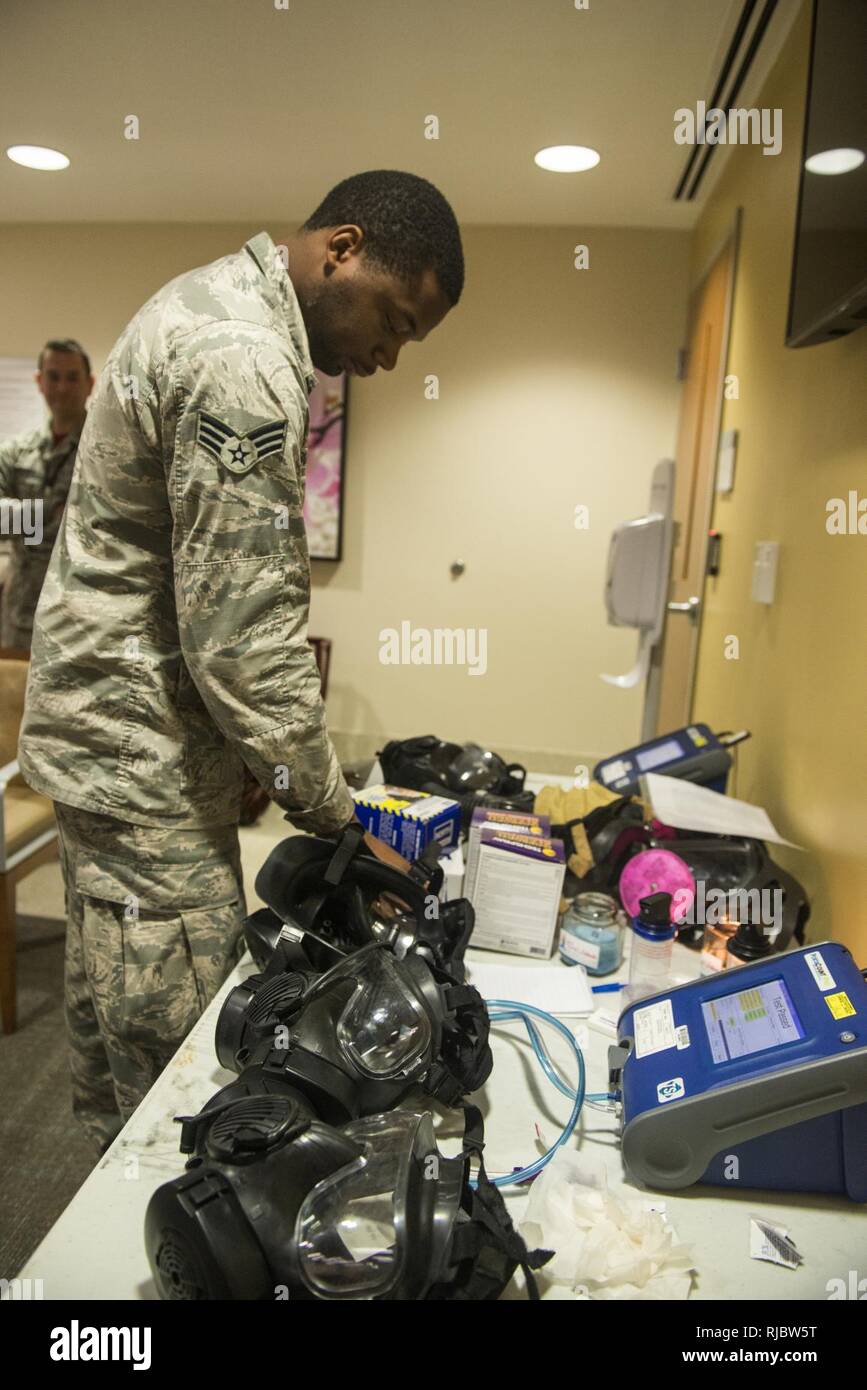 U.S. Air Force Senior Airman Brandon Burgess, 20th Aerospace Medicine Squadron bioenvironmental journeyman, prepares gas masks for fit testing at Shaw Air Force Base, S.C., Jan. 12, 2018. The bioenvironmental engineering flight does a gas mask fit test for Airmen on the installation to prepare them for deployments. Stock Photohttps://www.alamy.com/image-license-details/?v=1https://www.alamy.com/us-air-force-senior-airman-brandon-burgess-20th-aerospace-medicine-squadron-bioenvironmental-journeyman-prepares-gas-masks-for-fit-testing-at-shaw-air-force-base-sc-jan-12-2018-the-bioenvironmental-engineering-flight-does-a-gas-mask-fit-test-for-airmen-on-the-installation-to-prepare-them-for-deployments-image235059828.html
U.S. Air Force Senior Airman Brandon Burgess, 20th Aerospace Medicine Squadron bioenvironmental journeyman, prepares gas masks for fit testing at Shaw Air Force Base, S.C., Jan. 12, 2018. The bioenvironmental engineering flight does a gas mask fit test for Airmen on the installation to prepare them for deployments. Stock Photohttps://www.alamy.com/image-license-details/?v=1https://www.alamy.com/us-air-force-senior-airman-brandon-burgess-20th-aerospace-medicine-squadron-bioenvironmental-journeyman-prepares-gas-masks-for-fit-testing-at-shaw-air-force-base-sc-jan-12-2018-the-bioenvironmental-engineering-flight-does-a-gas-mask-fit-test-for-airmen-on-the-installation-to-prepare-them-for-deployments-image235059828.htmlRMRJBW5T–U.S. Air Force Senior Airman Brandon Burgess, 20th Aerospace Medicine Squadron bioenvironmental journeyman, prepares gas masks for fit testing at Shaw Air Force Base, S.C., Jan. 12, 2018. The bioenvironmental engineering flight does a gas mask fit test for Airmen on the installation to prepare them for deployments.
 An Airman from the 355th Civil Engineer Squadron Explosive Ordnance Disposal Flight trains other Airmen during hazardous material training at Davis-Monthan Air Force Base, Arizona, March 25, 2021. Units from across the 355th Wing, including the 355th Medical Group Bioenvironmental Engineering Flight, 355th CES EOD, 355th CES Fire and Emergency Services Flight, as well as Airmen from the 162nd Wing participated in this training to ensure their capabilities and readiness for any situation. Stock Photohttps://www.alamy.com/image-license-details/?v=1https://www.alamy.com/an-airman-from-the-355th-civil-engineer-squadron-explosive-ordnance-disposal-flight-trains-other-airmen-during-hazardous-material-training-at-davis-monthan-air-force-base-arizona-march-25-2021-units-from-across-the-355th-wing-including-the-355th-medical-group-bioenvironmental-engineering-flight-355th-ces-eod-355th-ces-fire-and-emergency-services-flight-as-well-as-airmen-from-the-162nd-wing-participated-in-this-training-to-ensure-their-capabilities-and-readiness-for-any-situation-image442245934.html
An Airman from the 355th Civil Engineer Squadron Explosive Ordnance Disposal Flight trains other Airmen during hazardous material training at Davis-Monthan Air Force Base, Arizona, March 25, 2021. Units from across the 355th Wing, including the 355th Medical Group Bioenvironmental Engineering Flight, 355th CES EOD, 355th CES Fire and Emergency Services Flight, as well as Airmen from the 162nd Wing participated in this training to ensure their capabilities and readiness for any situation. Stock Photohttps://www.alamy.com/image-license-details/?v=1https://www.alamy.com/an-airman-from-the-355th-civil-engineer-squadron-explosive-ordnance-disposal-flight-trains-other-airmen-during-hazardous-material-training-at-davis-monthan-air-force-base-arizona-march-25-2021-units-from-across-the-355th-wing-including-the-355th-medical-group-bioenvironmental-engineering-flight-355th-ces-eod-355th-ces-fire-and-emergency-services-flight-as-well-as-airmen-from-the-162nd-wing-participated-in-this-training-to-ensure-their-capabilities-and-readiness-for-any-situation-image442245934.htmlRM2GKE15J–An Airman from the 355th Civil Engineer Squadron Explosive Ordnance Disposal Flight trains other Airmen during hazardous material training at Davis-Monthan Air Force Base, Arizona, March 25, 2021. Units from across the 355th Wing, including the 355th Medical Group Bioenvironmental Engineering Flight, 355th CES EOD, 355th CES Fire and Emergency Services Flight, as well as Airmen from the 162nd Wing participated in this training to ensure their capabilities and readiness for any situation.
 U.S. Air Force Airman 1st Class Jackson Gordon, 20th Aerospace Medicine Squadron bioenvironmental apprentice, prepares an x-ray probe for calibration at Shaw Air Force Base, S.C., Jan. 12, 2018. The bioenvironmental engineering flight is responsible for calibrating some of their tools, such as the x-ray probe, to ensure accuracy when they monitor hazards in workplaces. Stock Photohttps://www.alamy.com/image-license-details/?v=1https://www.alamy.com/us-air-force-airman-1st-class-jackson-gordon-20th-aerospace-medicine-squadron-bioenvironmental-apprentice-prepares-an-x-ray-probe-for-calibration-at-shaw-air-force-base-sc-jan-12-2018-the-bioenvironmental-engineering-flight-is-responsible-for-calibrating-some-of-their-tools-such-as-the-x-ray-probe-to-ensure-accuracy-when-they-monitor-hazards-in-workplaces-image235059827.html
U.S. Air Force Airman 1st Class Jackson Gordon, 20th Aerospace Medicine Squadron bioenvironmental apprentice, prepares an x-ray probe for calibration at Shaw Air Force Base, S.C., Jan. 12, 2018. The bioenvironmental engineering flight is responsible for calibrating some of their tools, such as the x-ray probe, to ensure accuracy when they monitor hazards in workplaces. Stock Photohttps://www.alamy.com/image-license-details/?v=1https://www.alamy.com/us-air-force-airman-1st-class-jackson-gordon-20th-aerospace-medicine-squadron-bioenvironmental-apprentice-prepares-an-x-ray-probe-for-calibration-at-shaw-air-force-base-sc-jan-12-2018-the-bioenvironmental-engineering-flight-is-responsible-for-calibrating-some-of-their-tools-such-as-the-x-ray-probe-to-ensure-accuracy-when-they-monitor-hazards-in-workplaces-image235059827.htmlRMRJBW5R–U.S. Air Force Airman 1st Class Jackson Gordon, 20th Aerospace Medicine Squadron bioenvironmental apprentice, prepares an x-ray probe for calibration at Shaw Air Force Base, S.C., Jan. 12, 2018. The bioenvironmental engineering flight is responsible for calibrating some of their tools, such as the x-ray probe, to ensure accuracy when they monitor hazards in workplaces.
 Maj. Ben Weaver, 628th Operational Medical Readiness Squadron Bioenvironmental Engineering flight commander, listens as Maj. Gen. Mark Camerer, U.S. Air Force Expeditionary Center commander, asks a question about the Transport Isolation System at Joint Base Charleston, S.C., Feb. 9, 2021. Camerer, along with Chief Master Sgt. Anthony W. Green, USAF Expeditionary Center command chief, toured the base to get a firsthand look at Team Charleston’s capabilities and accomplishments. Stock Photohttps://www.alamy.com/image-license-details/?v=1https://www.alamy.com/maj-ben-weaver-628th-operational-medical-readiness-squadron-bioenvironmental-engineering-flight-commander-listens-as-maj-gen-mark-camerer-us-air-force-expeditionary-center-commander-asks-a-question-about-the-transport-isolation-system-at-joint-base-charleston-sc-feb-9-2021-camerer-along-with-chief-master-sgt-anthony-w-green-usaf-expeditionary-center-command-chief-toured-the-base-to-get-a-firsthand-look-at-team-charlestons-capabilities-and-accomplishments-image447785486.html
Maj. Ben Weaver, 628th Operational Medical Readiness Squadron Bioenvironmental Engineering flight commander, listens as Maj. Gen. Mark Camerer, U.S. Air Force Expeditionary Center commander, asks a question about the Transport Isolation System at Joint Base Charleston, S.C., Feb. 9, 2021. Camerer, along with Chief Master Sgt. Anthony W. Green, USAF Expeditionary Center command chief, toured the base to get a firsthand look at Team Charleston’s capabilities and accomplishments. Stock Photohttps://www.alamy.com/image-license-details/?v=1https://www.alamy.com/maj-ben-weaver-628th-operational-medical-readiness-squadron-bioenvironmental-engineering-flight-commander-listens-as-maj-gen-mark-camerer-us-air-force-expeditionary-center-commander-asks-a-question-about-the-transport-isolation-system-at-joint-base-charleston-sc-feb-9-2021-camerer-along-with-chief-master-sgt-anthony-w-green-usaf-expeditionary-center-command-chief-toured-the-base-to-get-a-firsthand-look-at-team-charlestons-capabilities-and-accomplishments-image447785486.htmlRM2H0EAXP–Maj. Ben Weaver, 628th Operational Medical Readiness Squadron Bioenvironmental Engineering flight commander, listens as Maj. Gen. Mark Camerer, U.S. Air Force Expeditionary Center commander, asks a question about the Transport Isolation System at Joint Base Charleston, S.C., Feb. 9, 2021. Camerer, along with Chief Master Sgt. Anthony W. Green, USAF Expeditionary Center command chief, toured the base to get a firsthand look at Team Charleston’s capabilities and accomplishments.
 Airmen from the 56th Occupational Medicine Readiness Squadron bioenvironmental engineering flight train on air sampling standard operating procedures Jan. 15, 2020, at Luke Air Force Base, Ariz. The flight trains weekly to retain proficiency on a wide variety of tasks and equipment. Bioenvironmental engineering’s mission is to provide reliable health risk expertise to optimize human performance and prevent adverse health effects of Airmen. (U.S. Air Force photo by Airman 1st Class Brooke Moeder) Stock Photohttps://www.alamy.com/image-license-details/?v=1https://www.alamy.com/airmen-from-the-56th-occupational-medicine-readiness-squadron-bioenvironmental-engineering-flight-train-on-air-sampling-standard-operating-procedures-jan-15-2020-at-luke-air-force-base-ariz-the-flight-trains-weekly-to-retain-proficiency-on-a-wide-variety-of-tasks-and-equipment-bioenvironmental-engineerings-mission-is-to-provide-reliable-health-risk-expertise-to-optimize-human-performance-and-prevent-adverse-health-effects-of-airmen-us-air-force-photo-by-airman-1st-class-brooke-moeder-image447279303.html
Airmen from the 56th Occupational Medicine Readiness Squadron bioenvironmental engineering flight train on air sampling standard operating procedures Jan. 15, 2020, at Luke Air Force Base, Ariz. The flight trains weekly to retain proficiency on a wide variety of tasks and equipment. Bioenvironmental engineering’s mission is to provide reliable health risk expertise to optimize human performance and prevent adverse health effects of Airmen. (U.S. Air Force photo by Airman 1st Class Brooke Moeder) Stock Photohttps://www.alamy.com/image-license-details/?v=1https://www.alamy.com/airmen-from-the-56th-occupational-medicine-readiness-squadron-bioenvironmental-engineering-flight-train-on-air-sampling-standard-operating-procedures-jan-15-2020-at-luke-air-force-base-ariz-the-flight-trains-weekly-to-retain-proficiency-on-a-wide-variety-of-tasks-and-equipment-bioenvironmental-engineerings-mission-is-to-provide-reliable-health-risk-expertise-to-optimize-human-performance-and-prevent-adverse-health-effects-of-airmen-us-air-force-photo-by-airman-1st-class-brooke-moeder-image447279303.htmlRM2GYK98R–Airmen from the 56th Occupational Medicine Readiness Squadron bioenvironmental engineering flight train on air sampling standard operating procedures Jan. 15, 2020, at Luke Air Force Base, Ariz. The flight trains weekly to retain proficiency on a wide variety of tasks and equipment. Bioenvironmental engineering’s mission is to provide reliable health risk expertise to optimize human performance and prevent adverse health effects of Airmen. (U.S. Air Force photo by Airman 1st Class Brooke Moeder)
 U.S. Air Force Maj. Sean Dyson, 56th Operational Medical Readiness Squadron bioenvironmental engineering flight commander, instructs Airmen assigned to the 56th Fighter Wing on self-aid buddy care during a chemical, biological, radiological, nuclear, and high-yield explosives training scenario, during Exercise Crown Talon, May 4, 2022, at Luke Air Force Base, Arizona. Readiness exercises such as Crown Talon sharpen Airmen’s combat support capabilities and optimize skills necessary for real-world contingencies. Stock Photohttps://www.alamy.com/image-license-details/?v=1https://www.alamy.com/us-air-force-maj-sean-dyson-56th-operational-medical-readiness-squadron-bioenvironmental-engineering-flight-commander-instructs-airmen-assigned-to-the-56th-fighter-wing-on-self-aid-buddy-care-during-a-chemical-biological-radiological-nuclear-and-high-yield-explosives-training-scenario-during-exercise-crown-talon-may-4-2022-at-luke-air-force-base-arizona-readiness-exercises-such-as-crown-talon-sharpen-airmens-combat-support-capabilities-and-optimize-skills-necessary-for-real-world-contingencies-image503317053.html
U.S. Air Force Maj. Sean Dyson, 56th Operational Medical Readiness Squadron bioenvironmental engineering flight commander, instructs Airmen assigned to the 56th Fighter Wing on self-aid buddy care during a chemical, biological, radiological, nuclear, and high-yield explosives training scenario, during Exercise Crown Talon, May 4, 2022, at Luke Air Force Base, Arizona. Readiness exercises such as Crown Talon sharpen Airmen’s combat support capabilities and optimize skills necessary for real-world contingencies. Stock Photohttps://www.alamy.com/image-license-details/?v=1https://www.alamy.com/us-air-force-maj-sean-dyson-56th-operational-medical-readiness-squadron-bioenvironmental-engineering-flight-commander-instructs-airmen-assigned-to-the-56th-fighter-wing-on-self-aid-buddy-care-during-a-chemical-biological-radiological-nuclear-and-high-yield-explosives-training-scenario-during-exercise-crown-talon-may-4-2022-at-luke-air-force-base-arizona-readiness-exercises-such-as-crown-talon-sharpen-airmens-combat-support-capabilities-and-optimize-skills-necessary-for-real-world-contingencies-image503317053.htmlRM2M6T211–U.S. Air Force Maj. Sean Dyson, 56th Operational Medical Readiness Squadron bioenvironmental engineering flight commander, instructs Airmen assigned to the 56th Fighter Wing on self-aid buddy care during a chemical, biological, radiological, nuclear, and high-yield explosives training scenario, during Exercise Crown Talon, May 4, 2022, at Luke Air Force Base, Arizona. Readiness exercises such as Crown Talon sharpen Airmen’s combat support capabilities and optimize skills necessary for real-world contingencies.
 Jason Rice, 355th Civil Engineer Squadron Fire and Emergency Services Flight fire captain, trains Airmen on tactics and procedures during hazardous material training at Davis-Monthan Air Force Base, Arizona, March 25, 2021. Units from across the 355th Wing, including the 355th Medical Group Bioenvironmental Engineering Flight, 355th CES Explosive Ordnance Disposal, 355th CES Fire and Emergency Services Flight and Airmen from the 162nd Wing participated in this training to ensure their capabilities and readiness for any situation. Stock Photohttps://www.alamy.com/image-license-details/?v=1https://www.alamy.com/jason-rice-355th-civil-engineer-squadron-fire-and-emergency-services-flight-fire-captain-trains-airmen-on-tactics-and-procedures-during-hazardous-material-training-at-davis-monthan-air-force-base-arizona-march-25-2021-units-from-across-the-355th-wing-including-the-355th-medical-group-bioenvironmental-engineering-flight-355th-ces-explosive-ordnance-disposal-355th-ces-fire-and-emergency-services-flight-and-airmen-from-the-162nd-wing-participated-in-this-training-to-ensure-their-capabilities-and-readiness-for-any-situation-image442245943.html
Jason Rice, 355th Civil Engineer Squadron Fire and Emergency Services Flight fire captain, trains Airmen on tactics and procedures during hazardous material training at Davis-Monthan Air Force Base, Arizona, March 25, 2021. Units from across the 355th Wing, including the 355th Medical Group Bioenvironmental Engineering Flight, 355th CES Explosive Ordnance Disposal, 355th CES Fire and Emergency Services Flight and Airmen from the 162nd Wing participated in this training to ensure their capabilities and readiness for any situation. Stock Photohttps://www.alamy.com/image-license-details/?v=1https://www.alamy.com/jason-rice-355th-civil-engineer-squadron-fire-and-emergency-services-flight-fire-captain-trains-airmen-on-tactics-and-procedures-during-hazardous-material-training-at-davis-monthan-air-force-base-arizona-march-25-2021-units-from-across-the-355th-wing-including-the-355th-medical-group-bioenvironmental-engineering-flight-355th-ces-explosive-ordnance-disposal-355th-ces-fire-and-emergency-services-flight-and-airmen-from-the-162nd-wing-participated-in-this-training-to-ensure-their-capabilities-and-readiness-for-any-situation-image442245943.htmlRM2GKE15Y–Jason Rice, 355th Civil Engineer Squadron Fire and Emergency Services Flight fire captain, trains Airmen on tactics and procedures during hazardous material training at Davis-Monthan Air Force Base, Arizona, March 25, 2021. Units from across the 355th Wing, including the 355th Medical Group Bioenvironmental Engineering Flight, 355th CES Explosive Ordnance Disposal, 355th CES Fire and Emergency Services Flight and Airmen from the 162nd Wing participated in this training to ensure their capabilities and readiness for any situation.
 Maj. Kenneth Kirk, 56th Operational Medicine Readiness Squadron bioenvironmental engineering flight commander, demonstrates the functionality of Canary equipment Jan. 14, 2020, at Luke Air Force Base, Ariz. The Canary monitors wet bulb temperature, air quality, humidity, air pressure, etc. every minute, everywhere on base. Bioenvironmental engineering’s mission is to provide reliable health risk expertise to optimize human performance and prevent adverse health effects of Airmen. (U.S. Air Force photo by Airman 1st Class Brooke Moeder) Stock Photohttps://www.alamy.com/image-license-details/?v=1https://www.alamy.com/maj-kenneth-kirk-56th-operational-medicine-readiness-squadron-bioenvironmental-engineering-flight-commander-demonstrates-the-functionality-of-canary-equipment-jan-14-2020-at-luke-air-force-base-ariz-the-canary-monitors-wet-bulb-temperature-air-quality-humidity-air-pressure-etc-every-minute-everywhere-on-base-bioenvironmental-engineerings-mission-is-to-provide-reliable-health-risk-expertise-to-optimize-human-performance-and-prevent-adverse-health-effects-of-airmen-us-air-force-photo-by-airman-1st-class-brooke-moeder-image447277179.html
Maj. Kenneth Kirk, 56th Operational Medicine Readiness Squadron bioenvironmental engineering flight commander, demonstrates the functionality of Canary equipment Jan. 14, 2020, at Luke Air Force Base, Ariz. The Canary monitors wet bulb temperature, air quality, humidity, air pressure, etc. every minute, everywhere on base. Bioenvironmental engineering’s mission is to provide reliable health risk expertise to optimize human performance and prevent adverse health effects of Airmen. (U.S. Air Force photo by Airman 1st Class Brooke Moeder) Stock Photohttps://www.alamy.com/image-license-details/?v=1https://www.alamy.com/maj-kenneth-kirk-56th-operational-medicine-readiness-squadron-bioenvironmental-engineering-flight-commander-demonstrates-the-functionality-of-canary-equipment-jan-14-2020-at-luke-air-force-base-ariz-the-canary-monitors-wet-bulb-temperature-air-quality-humidity-air-pressure-etc-every-minute-everywhere-on-base-bioenvironmental-engineerings-mission-is-to-provide-reliable-health-risk-expertise-to-optimize-human-performance-and-prevent-adverse-health-effects-of-airmen-us-air-force-photo-by-airman-1st-class-brooke-moeder-image447277179.htmlRM2GYK6GY–Maj. Kenneth Kirk, 56th Operational Medicine Readiness Squadron bioenvironmental engineering flight commander, demonstrates the functionality of Canary equipment Jan. 14, 2020, at Luke Air Force Base, Ariz. The Canary monitors wet bulb temperature, air quality, humidity, air pressure, etc. every minute, everywhere on base. Bioenvironmental engineering’s mission is to provide reliable health risk expertise to optimize human performance and prevent adverse health effects of Airmen. (U.S. Air Force photo by Airman 1st Class Brooke Moeder)
 U.S. Air Force Gen. Duke Z. Richardson, Air Force Materiel Command commander, U.S. Air Force Chief Master Sgt. James Fitch, Air Force Materiel Command command chief, and U.S. Air Force Senior Airman Angel Perez, 30th Medical Group Bioenvironmental Engineering Flight bioenvironmental engineering journeyman, met during a tour at Vandenberg Space Force Base, Calif., Feb. 21, 2024. Perez highlighted the quality-of-life contributions the 30th MDG Bioenvironmental Engineering Flight make at Vandenberg. Space Force Stock Photohttps://www.alamy.com/image-license-details/?v=1https://www.alamy.com/us-air-force-gen-duke-z-richardson-air-force-materiel-command-commander-us-air-force-chief-master-sgt-james-fitch-air-force-materiel-command-command-chief-and-us-air-force-senior-airman-angel-perez-30th-medical-group-bioenvironmental-engineering-flight-bioenvironmental-engineering-journeyman-met-during-a-tour-at-vandenberg-space-force-base-calif-feb-21-2024-perez-highlighted-the-quality-of-life-contributions-the-30th-mdg-bioenvironmental-engineering-flight-make-at-vandenberg-space-force-image601005504.html
U.S. Air Force Gen. Duke Z. Richardson, Air Force Materiel Command commander, U.S. Air Force Chief Master Sgt. James Fitch, Air Force Materiel Command command chief, and U.S. Air Force Senior Airman Angel Perez, 30th Medical Group Bioenvironmental Engineering Flight bioenvironmental engineering journeyman, met during a tour at Vandenberg Space Force Base, Calif., Feb. 21, 2024. Perez highlighted the quality-of-life contributions the 30th MDG Bioenvironmental Engineering Flight make at Vandenberg. Space Force Stock Photohttps://www.alamy.com/image-license-details/?v=1https://www.alamy.com/us-air-force-gen-duke-z-richardson-air-force-materiel-command-commander-us-air-force-chief-master-sgt-james-fitch-air-force-materiel-command-command-chief-and-us-air-force-senior-airman-angel-perez-30th-medical-group-bioenvironmental-engineering-flight-bioenvironmental-engineering-journeyman-met-during-a-tour-at-vandenberg-space-force-base-calif-feb-21-2024-perez-highlighted-the-quality-of-life-contributions-the-30th-mdg-bioenvironmental-engineering-flight-make-at-vandenberg-space-force-image601005504.htmlRM2WWP4J8–U.S. Air Force Gen. Duke Z. Richardson, Air Force Materiel Command commander, U.S. Air Force Chief Master Sgt. James Fitch, Air Force Materiel Command command chief, and U.S. Air Force Senior Airman Angel Perez, 30th Medical Group Bioenvironmental Engineering Flight bioenvironmental engineering journeyman, met during a tour at Vandenberg Space Force Base, Calif., Feb. 21, 2024. Perez highlighted the quality-of-life contributions the 30th MDG Bioenvironmental Engineering Flight make at Vandenberg. Space Force
 U.S. Air Force Airman Treshun Word, a Swainsboro, Georgia, native with the 366th Operational Medical Readiness Squadron from Mountain Home Air Force Base, Idaho, collects patient information and directs a vaccine recipient at the NRG Community Vaccination Center (CVC) in Houston, March 18, 2021. Word is a member of the Bioenvironmental Engineering Flight which provides communicable disease prevention, force health, environment protection, and industrial hygiene for the base population. U.S. Northern Command, through U.S. Army North, remains committed to providing continued, flexible Department Stock Photohttps://www.alamy.com/image-license-details/?v=1https://www.alamy.com/us-air-force-airman-treshun-word-a-swainsboro-georgia-native-with-the-366th-operational-medical-readiness-squadron-from-mountain-home-air-force-base-idaho-collects-patient-information-and-directs-a-vaccine-recipient-at-the-nrg-community-vaccination-center-cvc-in-houston-march-18-2021-word-is-a-member-of-the-bioenvironmental-engineering-flight-which-provides-communicable-disease-prevention-force-health-environment-protection-and-industrial-hygiene-for-the-base-population-us-northern-command-through-us-army-north-remains-committed-to-providing-continued-flexible-department-image442228338.html
U.S. Air Force Airman Treshun Word, a Swainsboro, Georgia, native with the 366th Operational Medical Readiness Squadron from Mountain Home Air Force Base, Idaho, collects patient information and directs a vaccine recipient at the NRG Community Vaccination Center (CVC) in Houston, March 18, 2021. Word is a member of the Bioenvironmental Engineering Flight which provides communicable disease prevention, force health, environment protection, and industrial hygiene for the base population. U.S. Northern Command, through U.S. Army North, remains committed to providing continued, flexible Department Stock Photohttps://www.alamy.com/image-license-details/?v=1https://www.alamy.com/us-air-force-airman-treshun-word-a-swainsboro-georgia-native-with-the-366th-operational-medical-readiness-squadron-from-mountain-home-air-force-base-idaho-collects-patient-information-and-directs-a-vaccine-recipient-at-the-nrg-community-vaccination-center-cvc-in-houston-march-18-2021-word-is-a-member-of-the-bioenvironmental-engineering-flight-which-provides-communicable-disease-prevention-force-health-environment-protection-and-industrial-hygiene-for-the-base-population-us-northern-command-through-us-army-north-remains-committed-to-providing-continued-flexible-department-image442228338.htmlRM2GKD6N6–U.S. Air Force Airman Treshun Word, a Swainsboro, Georgia, native with the 366th Operational Medical Readiness Squadron from Mountain Home Air Force Base, Idaho, collects patient information and directs a vaccine recipient at the NRG Community Vaccination Center (CVC) in Houston, March 18, 2021. Word is a member of the Bioenvironmental Engineering Flight which provides communicable disease prevention, force health, environment protection, and industrial hygiene for the base population. U.S. Northern Command, through U.S. Army North, remains committed to providing continued, flexible Department
 An Airman assigned to the 48th Aerospace Medicine Squadron Bioenvironmental Engineering flight tests the acidity levels of the drinking water at Royal Air Force Lakenheath, England, June 19, 2018. The 48th AMDS, Bioenvironmental Engineering flight uses engineering principles to check for pollutants and radioactive materials, implementing environmental protections, monitoring OSHA and NRC work safety standards and permits, and other duties to reduce health risks and dangers to Airmen. Stock Photohttps://www.alamy.com/image-license-details/?v=1https://www.alamy.com/an-airman-assigned-to-the-48th-aerospace-medicine-squadron-bioenvironmental-engineering-flight-tests-the-acidity-levels-of-the-drinking-water-at-royal-air-force-lakenheath-england-june-19-2018-the-48th-amds-bioenvironmental-engineering-flight-uses-engineering-principles-to-check-for-pollutants-and-radioactive-materials-implementing-environmental-protections-monitoring-osha-and-nrc-work-safety-standards-and-permits-and-other-duties-to-reduce-health-risks-and-dangers-to-airmen-image216991127.html
An Airman assigned to the 48th Aerospace Medicine Squadron Bioenvironmental Engineering flight tests the acidity levels of the drinking water at Royal Air Force Lakenheath, England, June 19, 2018. The 48th AMDS, Bioenvironmental Engineering flight uses engineering principles to check for pollutants and radioactive materials, implementing environmental protections, monitoring OSHA and NRC work safety standards and permits, and other duties to reduce health risks and dangers to Airmen. Stock Photohttps://www.alamy.com/image-license-details/?v=1https://www.alamy.com/an-airman-assigned-to-the-48th-aerospace-medicine-squadron-bioenvironmental-engineering-flight-tests-the-acidity-levels-of-the-drinking-water-at-royal-air-force-lakenheath-england-june-19-2018-the-48th-amds-bioenvironmental-engineering-flight-uses-engineering-principles-to-check-for-pollutants-and-radioactive-materials-implementing-environmental-protections-monitoring-osha-and-nrc-work-safety-standards-and-permits-and-other-duties-to-reduce-health-risks-and-dangers-to-airmen-image216991127.htmlRMPH0PB3–An Airman assigned to the 48th Aerospace Medicine Squadron Bioenvironmental Engineering flight tests the acidity levels of the drinking water at Royal Air Force Lakenheath, England, June 19, 2018. The 48th AMDS, Bioenvironmental Engineering flight uses engineering principles to check for pollutants and radioactive materials, implementing environmental protections, monitoring OSHA and NRC work safety standards and permits, and other duties to reduce health risks and dangers to Airmen.
 U.S. Air Force Airman Treshun Word, a Swainsboro, Georgia, native with the 366th Operational Medical Readiness Squadron from Mountain Home Air Force Base, Idaho, directs traffic at the NRG Community Vaccination Center (CVC) in Houston, March 18, 2021. Word is a member of the Bioenvironmental Engineering Flight which provides communicable disease prevention, force health, environment protection, and industrial hygiene for the base population. U.S. Northern Command, through U.S. Army North, remains committed to providing continued, flexible Department of Defense support to the Federal Emergency Stock Photohttps://www.alamy.com/image-license-details/?v=1https://www.alamy.com/us-air-force-airman-treshun-word-a-swainsboro-georgia-native-with-the-366th-operational-medical-readiness-squadron-from-mountain-home-air-force-base-idaho-directs-traffic-at-the-nrg-community-vaccination-center-cvc-in-houston-march-18-2021-word-is-a-member-of-the-bioenvironmental-engineering-flight-which-provides-communicable-disease-prevention-force-health-environment-protection-and-industrial-hygiene-for-the-base-population-us-northern-command-through-us-army-north-remains-committed-to-providing-continued-flexible-department-of-defense-support-to-the-federal-emergency-image442228258.html
U.S. Air Force Airman Treshun Word, a Swainsboro, Georgia, native with the 366th Operational Medical Readiness Squadron from Mountain Home Air Force Base, Idaho, directs traffic at the NRG Community Vaccination Center (CVC) in Houston, March 18, 2021. Word is a member of the Bioenvironmental Engineering Flight which provides communicable disease prevention, force health, environment protection, and industrial hygiene for the base population. U.S. Northern Command, through U.S. Army North, remains committed to providing continued, flexible Department of Defense support to the Federal Emergency Stock Photohttps://www.alamy.com/image-license-details/?v=1https://www.alamy.com/us-air-force-airman-treshun-word-a-swainsboro-georgia-native-with-the-366th-operational-medical-readiness-squadron-from-mountain-home-air-force-base-idaho-directs-traffic-at-the-nrg-community-vaccination-center-cvc-in-houston-march-18-2021-word-is-a-member-of-the-bioenvironmental-engineering-flight-which-provides-communicable-disease-prevention-force-health-environment-protection-and-industrial-hygiene-for-the-base-population-us-northern-command-through-us-army-north-remains-committed-to-providing-continued-flexible-department-of-defense-support-to-the-federal-emergency-image442228258.htmlRM2GKD6JA–U.S. Air Force Airman Treshun Word, a Swainsboro, Georgia, native with the 366th Operational Medical Readiness Squadron from Mountain Home Air Force Base, Idaho, directs traffic at the NRG Community Vaccination Center (CVC) in Houston, March 18, 2021. Word is a member of the Bioenvironmental Engineering Flight which provides communicable disease prevention, force health, environment protection, and industrial hygiene for the base population. U.S. Northern Command, through U.S. Army North, remains committed to providing continued, flexible Department of Defense support to the Federal Emergency
 U.S. Air Force Master Sgt. Frank Yuvan, 23rd Operational Medical Readiness Squadron operational medicine flight chief, left, and Master Sgt. Adam Ruiz, 23rd OMRS bioenvironmental engineering flight chief, review a medical kit during exercise Agile Flag 22-2 at Avon Park, Florida, July 22, 2022. Agile Flag 22-2 is Air Combat Command's first lead-wing certification event designed to demonstrate the 23rd Wing's capability to generate combat air power while continuing to move, maneuver, and sustain the Wing and subordinate force elements in a dynamic and contested environment. Stock Photohttps://www.alamy.com/image-license-details/?v=1https://www.alamy.com/us-air-force-master-sgt-frank-yuvan-23rd-operational-medical-readiness-squadron-operational-medicine-flight-chief-left-and-master-sgt-adam-ruiz-23rd-omrs-bioenvironmental-engineering-flight-chief-review-a-medical-kit-during-exercise-agile-flag-22-2-at-avon-park-florida-july-22-2022-agile-flag-22-2-is-air-combat-commands-first-lead-wing-certification-event-designed-to-demonstrate-the-23rd-wings-capability-to-generate-combat-air-power-while-continuing-to-move-maneuver-and-sustain-the-wing-and-subordinate-force-elements-in-a-dynamic-and-contested-environment-image507437281.html
U.S. Air Force Master Sgt. Frank Yuvan, 23rd Operational Medical Readiness Squadron operational medicine flight chief, left, and Master Sgt. Adam Ruiz, 23rd OMRS bioenvironmental engineering flight chief, review a medical kit during exercise Agile Flag 22-2 at Avon Park, Florida, July 22, 2022. Agile Flag 22-2 is Air Combat Command's first lead-wing certification event designed to demonstrate the 23rd Wing's capability to generate combat air power while continuing to move, maneuver, and sustain the Wing and subordinate force elements in a dynamic and contested environment. Stock Photohttps://www.alamy.com/image-license-details/?v=1https://www.alamy.com/us-air-force-master-sgt-frank-yuvan-23rd-operational-medical-readiness-squadron-operational-medicine-flight-chief-left-and-master-sgt-adam-ruiz-23rd-omrs-bioenvironmental-engineering-flight-chief-review-a-medical-kit-during-exercise-agile-flag-22-2-at-avon-park-florida-july-22-2022-agile-flag-22-2-is-air-combat-commands-first-lead-wing-certification-event-designed-to-demonstrate-the-23rd-wings-capability-to-generate-combat-air-power-while-continuing-to-move-maneuver-and-sustain-the-wing-and-subordinate-force-elements-in-a-dynamic-and-contested-environment-image507437281.htmlRM2MDFNC1–U.S. Air Force Master Sgt. Frank Yuvan, 23rd Operational Medical Readiness Squadron operational medicine flight chief, left, and Master Sgt. Adam Ruiz, 23rd OMRS bioenvironmental engineering flight chief, review a medical kit during exercise Agile Flag 22-2 at Avon Park, Florida, July 22, 2022. Agile Flag 22-2 is Air Combat Command's first lead-wing certification event designed to demonstrate the 23rd Wing's capability to generate combat air power while continuing to move, maneuver, and sustain the Wing and subordinate force elements in a dynamic and contested environment.
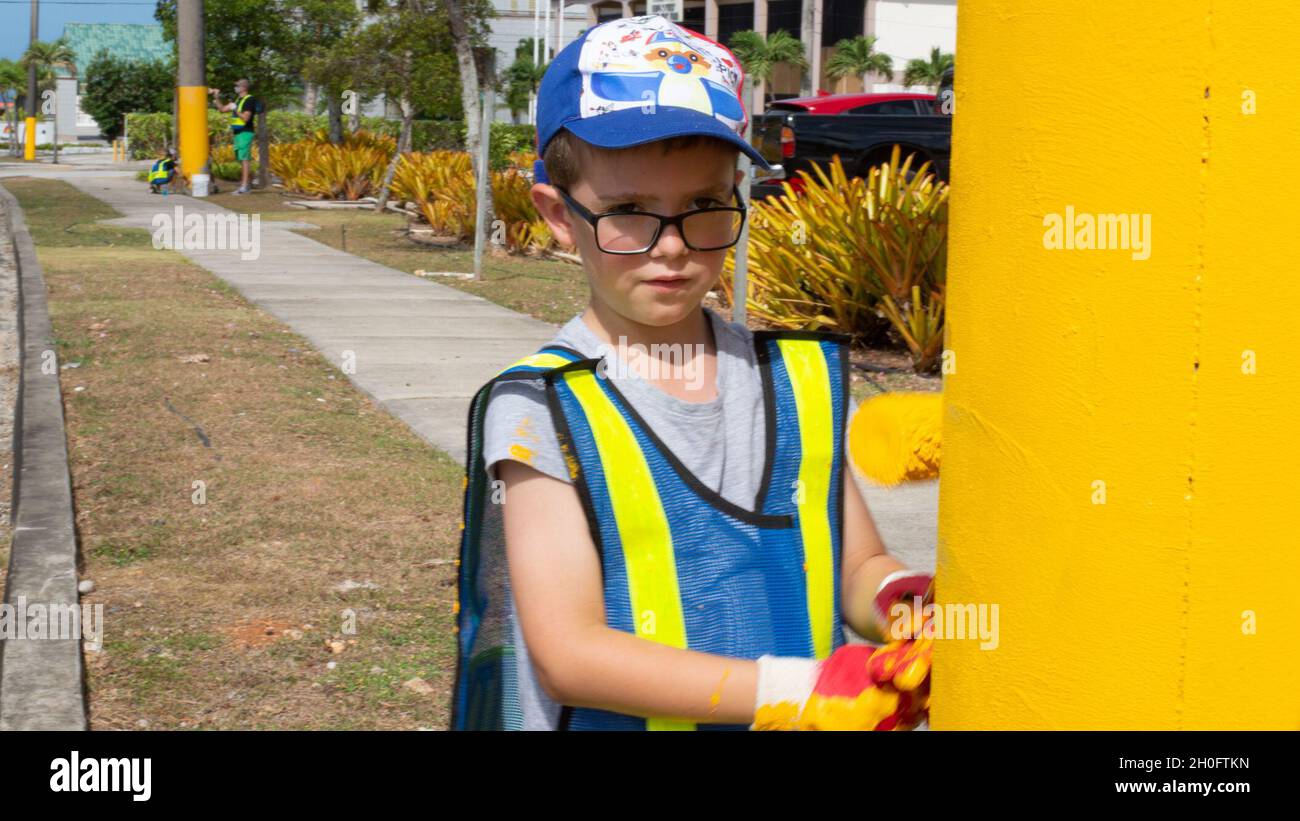 The son of U.S. Air Force Capt. Brennan Houbrick, 36th Operational Medical Readiness Squadron bioenvironmental engineering flight commander, paints a power pole during a village beautification event in Mongmong-Toto-Maite, Guam, Feb. 27, 2021. Twenty-five 36th OMRS volunteers helped paint power poles within the village through the Andersen Air Force Base Sister Village Sister Squadron program, in which squadron volunteers collaborate with Guam residents in events to strengthen their friendship and partnership. The yellow paint helps to increase nighttime visibility of the power poles on busy r Stock Photohttps://www.alamy.com/image-license-details/?v=1https://www.alamy.com/the-son-of-us-air-force-capt-brennan-houbrick-36th-operational-medical-readiness-squadron-bioenvironmental-engineering-flight-commander-paints-a-power-pole-during-a-village-beautification-event-in-mongmong-toto-maite-guam-feb-27-2021-twenty-five-36th-omrs-volunteers-helped-paint-power-poles-within-the-village-through-the-andersen-air-force-base-sister-village-sister-squadron-program-in-which-squadron-volunteers-collaborate-with-guam-residents-in-events-to-strengthen-their-friendship-and-partnership-the-yellow-paint-helps-to-increase-nighttime-visibility-of-the-power-poles-on-busy-r-image447818217.html
The son of U.S. Air Force Capt. Brennan Houbrick, 36th Operational Medical Readiness Squadron bioenvironmental engineering flight commander, paints a power pole during a village beautification event in Mongmong-Toto-Maite, Guam, Feb. 27, 2021. Twenty-five 36th OMRS volunteers helped paint power poles within the village through the Andersen Air Force Base Sister Village Sister Squadron program, in which squadron volunteers collaborate with Guam residents in events to strengthen their friendship and partnership. The yellow paint helps to increase nighttime visibility of the power poles on busy r Stock Photohttps://www.alamy.com/image-license-details/?v=1https://www.alamy.com/the-son-of-us-air-force-capt-brennan-houbrick-36th-operational-medical-readiness-squadron-bioenvironmental-engineering-flight-commander-paints-a-power-pole-during-a-village-beautification-event-in-mongmong-toto-maite-guam-feb-27-2021-twenty-five-36th-omrs-volunteers-helped-paint-power-poles-within-the-village-through-the-andersen-air-force-base-sister-village-sister-squadron-program-in-which-squadron-volunteers-collaborate-with-guam-residents-in-events-to-strengthen-their-friendship-and-partnership-the-yellow-paint-helps-to-increase-nighttime-visibility-of-the-power-poles-on-busy-r-image447818217.htmlRM2H0FTKN–The son of U.S. Air Force Capt. Brennan Houbrick, 36th Operational Medical Readiness Squadron bioenvironmental engineering flight commander, paints a power pole during a village beautification event in Mongmong-Toto-Maite, Guam, Feb. 27, 2021. Twenty-five 36th OMRS volunteers helped paint power poles within the village through the Andersen Air Force Base Sister Village Sister Squadron program, in which squadron volunteers collaborate with Guam residents in events to strengthen their friendship and partnership. The yellow paint helps to increase nighttime visibility of the power poles on busy r
 Maj. Michael Smith, 4th Aerospace Medicine Squadron bioenvironmental engineering flight commander, secures a simulated sample of Staphylococcal Enterotoxin B during an integrated base emergency response capabilities training exercise June 25, 2015, at Seymour Johnson Air Force Base, N.C. IBERCT helped prepare participants for potential real-world scenarios involving chemical, biological, radiological, nuclear, and explosive threats. Senior Airman John Nieves Camacho) Stock Photohttps://www.alamy.com/image-license-details/?v=1https://www.alamy.com/stock-photo-maj-michael-smith-4th-aerospace-medicine-squadron-bioenvironmental-129293161.html
Maj. Michael Smith, 4th Aerospace Medicine Squadron bioenvironmental engineering flight commander, secures a simulated sample of Staphylococcal Enterotoxin B during an integrated base emergency response capabilities training exercise June 25, 2015, at Seymour Johnson Air Force Base, N.C. IBERCT helped prepare participants for potential real-world scenarios involving chemical, biological, radiological, nuclear, and explosive threats. Senior Airman John Nieves Camacho) Stock Photohttps://www.alamy.com/image-license-details/?v=1https://www.alamy.com/stock-photo-maj-michael-smith-4th-aerospace-medicine-squadron-bioenvironmental-129293161.htmlRMHE9PMW–Maj. Michael Smith, 4th Aerospace Medicine Squadron bioenvironmental engineering flight commander, secures a simulated sample of Staphylococcal Enterotoxin B during an integrated base emergency response capabilities training exercise June 25, 2015, at Seymour Johnson Air Force Base, N.C. IBERCT helped prepare participants for potential real-world scenarios involving chemical, biological, radiological, nuclear, and explosive threats. Senior Airman John Nieves Camacho)
 An Airman assigned to the 48th Aerospace Medicine Squadron Bioenvironmental Engineering flight tests the acidity levels of the drinking water at Royal Air Force Lakenheath, England, June 19, 2018. The 48th AMDS, Bioenvironmental Engineering flight uses engineering principles to check for pollutants and radioactive materials, implementing environmental protections, monitoring OSHA and NRC work safety standards and permits, and other duties to reduce health risks and dangers to Airmen. Stock Photohttps://www.alamy.com/image-license-details/?v=1https://www.alamy.com/an-airman-assigned-to-the-48th-aerospace-medicine-squadron-bioenvironmental-engineering-flight-tests-the-acidity-levels-of-the-drinking-water-at-royal-air-force-lakenheath-england-june-19-2018-the-48th-amds-bioenvironmental-engineering-flight-uses-engineering-principles-to-check-for-pollutants-and-radioactive-materials-implementing-environmental-protections-monitoring-osha-and-nrc-work-safety-standards-and-permits-and-other-duties-to-reduce-health-risks-and-dangers-to-airmen-image216991128.html
An Airman assigned to the 48th Aerospace Medicine Squadron Bioenvironmental Engineering flight tests the acidity levels of the drinking water at Royal Air Force Lakenheath, England, June 19, 2018. The 48th AMDS, Bioenvironmental Engineering flight uses engineering principles to check for pollutants and radioactive materials, implementing environmental protections, monitoring OSHA and NRC work safety standards and permits, and other duties to reduce health risks and dangers to Airmen. Stock Photohttps://www.alamy.com/image-license-details/?v=1https://www.alamy.com/an-airman-assigned-to-the-48th-aerospace-medicine-squadron-bioenvironmental-engineering-flight-tests-the-acidity-levels-of-the-drinking-water-at-royal-air-force-lakenheath-england-june-19-2018-the-48th-amds-bioenvironmental-engineering-flight-uses-engineering-principles-to-check-for-pollutants-and-radioactive-materials-implementing-environmental-protections-monitoring-osha-and-nrc-work-safety-standards-and-permits-and-other-duties-to-reduce-health-risks-and-dangers-to-airmen-image216991128.htmlRMPH0PB4–An Airman assigned to the 48th Aerospace Medicine Squadron Bioenvironmental Engineering flight tests the acidity levels of the drinking water at Royal Air Force Lakenheath, England, June 19, 2018. The 48th AMDS, Bioenvironmental Engineering flight uses engineering principles to check for pollutants and radioactive materials, implementing environmental protections, monitoring OSHA and NRC work safety standards and permits, and other duties to reduce health risks and dangers to Airmen.
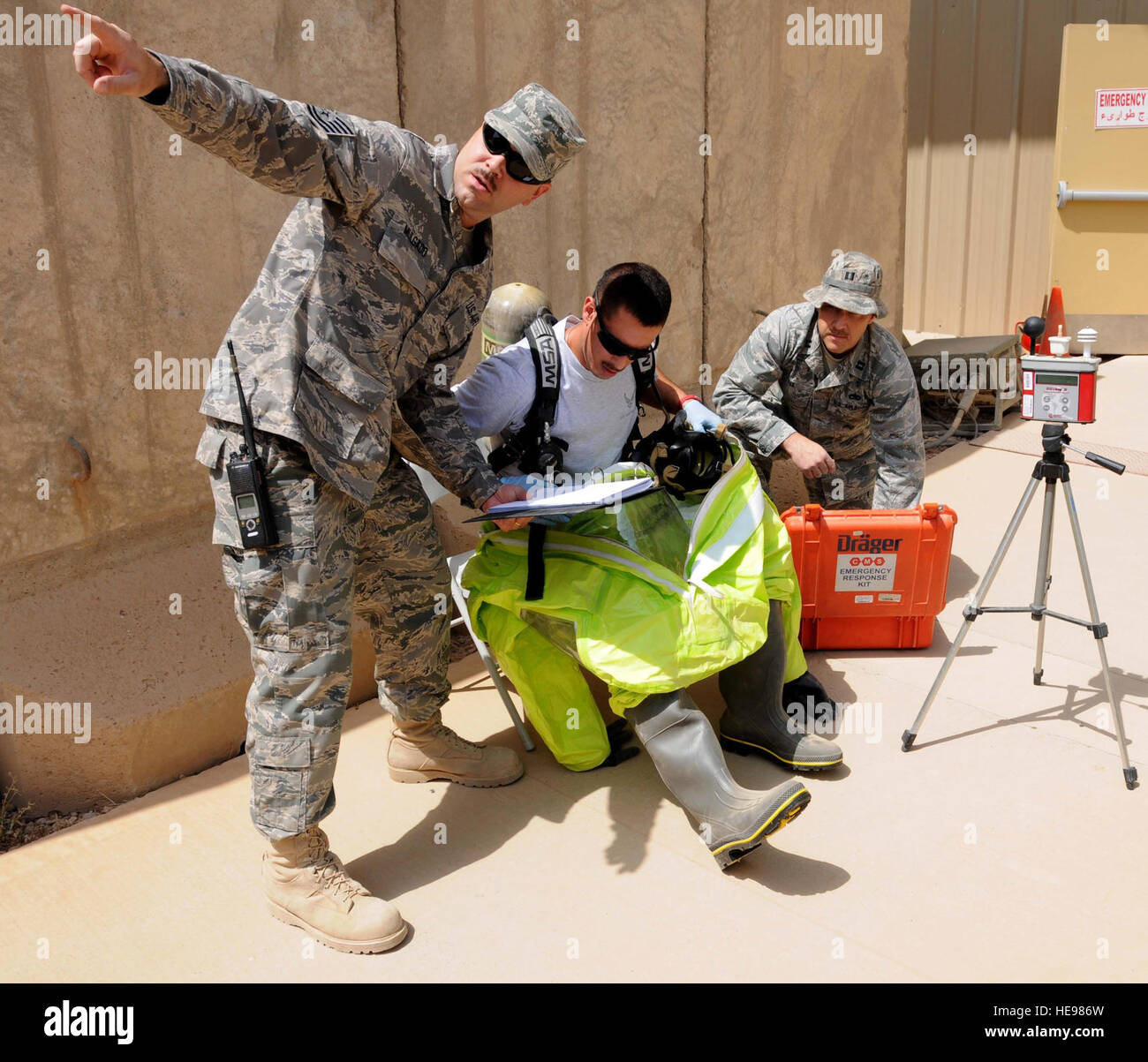 Airmen from the 332nd Expeditionary Medical Group Bioenvironmental Engineering Flight run through equipment checks. The BEF has a myriad of responsibilities on Joint Base Balad, Iraq, such as preparing for hazardous material threats, as well as, tests the JBB water supply for quality assurance. Stock Photohttps://www.alamy.com/image-license-details/?v=1https://www.alamy.com/stock-photo-airmen-from-the-332nd-expeditionary-medical-group-bioenvironmental-129281793.html
Airmen from the 332nd Expeditionary Medical Group Bioenvironmental Engineering Flight run through equipment checks. The BEF has a myriad of responsibilities on Joint Base Balad, Iraq, such as preparing for hazardous material threats, as well as, tests the JBB water supply for quality assurance. Stock Photohttps://www.alamy.com/image-license-details/?v=1https://www.alamy.com/stock-photo-airmen-from-the-332nd-expeditionary-medical-group-bioenvironmental-129281793.htmlRMHE986W–Airmen from the 332nd Expeditionary Medical Group Bioenvironmental Engineering Flight run through equipment checks. The BEF has a myriad of responsibilities on Joint Base Balad, Iraq, such as preparing for hazardous material threats, as well as, tests the JBB water supply for quality assurance.
 U.S. Airmen with the 47th Fire Emergency Services flight, 47th Readiness and Emergency Management Flight and the 47th Bioenvironmental Engineering Flight, transport vital chemical, biological, radiological and nuclear detection and testing equipment at a joint unit response training event at Laughlin Air Force Base, Texas, June 17, 2014. Staff Sgt. Steven R. Doty Stock Photohttps://www.alamy.com/image-license-details/?v=1https://www.alamy.com/stock-photo-us-airmen-with-the-47th-fire-emergency-services-flight-47th-readiness-129327993.html
U.S. Airmen with the 47th Fire Emergency Services flight, 47th Readiness and Emergency Management Flight and the 47th Bioenvironmental Engineering Flight, transport vital chemical, biological, radiological and nuclear detection and testing equipment at a joint unit response training event at Laughlin Air Force Base, Texas, June 17, 2014. Staff Sgt. Steven R. Doty Stock Photohttps://www.alamy.com/image-license-details/?v=1https://www.alamy.com/stock-photo-us-airmen-with-the-47th-fire-emergency-services-flight-47th-readiness-129327993.htmlRMHEBB4W–U.S. Airmen with the 47th Fire Emergency Services flight, 47th Readiness and Emergency Management Flight and the 47th Bioenvironmental Engineering Flight, transport vital chemical, biological, radiological and nuclear detection and testing equipment at a joint unit response training event at Laughlin Air Force Base, Texas, June 17, 2014. Staff Sgt. Steven R. Doty
 Staff Sgt. Marcus Maltese, 628th Aerospace Medicine Squadron Bioenvironmental Engineering flight, replaces ceiling tiles, Sept. 7, 2012, at Rollings Middle School of the Arts in Summerville, S.C. The Day of Caring, organized locally by the Trident United Way, saw more than 8,500 volunteers working on more than 300 projects around the Lowcountry. Stock Photohttps://www.alamy.com/image-license-details/?v=1https://www.alamy.com/stock-photo-staff-sgt-marcus-maltese-628th-aerospace-medicine-squadron-bioenvironmental-129288937.html
Staff Sgt. Marcus Maltese, 628th Aerospace Medicine Squadron Bioenvironmental Engineering flight, replaces ceiling tiles, Sept. 7, 2012, at Rollings Middle School of the Arts in Summerville, S.C. The Day of Caring, organized locally by the Trident United Way, saw more than 8,500 volunteers working on more than 300 projects around the Lowcountry. Stock Photohttps://www.alamy.com/image-license-details/?v=1https://www.alamy.com/stock-photo-staff-sgt-marcus-maltese-628th-aerospace-medicine-squadron-bioenvironmental-129288937.htmlRMHE9HA1–Staff Sgt. Marcus Maltese, 628th Aerospace Medicine Squadron Bioenvironmental Engineering flight, replaces ceiling tiles, Sept. 7, 2012, at Rollings Middle School of the Arts in Summerville, S.C. The Day of Caring, organized locally by the Trident United Way, saw more than 8,500 volunteers working on more than 300 projects around the Lowcountry.
 U.S. Air Force Airman 1st Class Bart Bolin, 97th Medical Operations Squadron bioenvironmental engineering journeyman, checks the acidity of a water sample Sept. 25. The bioenvironmental engineering flight gathers water samples quarterly to test for chemicals. Checking the pH levels within the water measures how acidic it is. (U.S. Air Force photo by Airman 1st Class Franklin R. Ramos/Released) Stock Photohttps://www.alamy.com/image-license-details/?v=1https://www.alamy.com/stock-photo-us-air-force-airman-1st-class-bart-bolin-97th-medical-operations-squadron-129343297.html
U.S. Air Force Airman 1st Class Bart Bolin, 97th Medical Operations Squadron bioenvironmental engineering journeyman, checks the acidity of a water sample Sept. 25. The bioenvironmental engineering flight gathers water samples quarterly to test for chemicals. Checking the pH levels within the water measures how acidic it is. (U.S. Air Force photo by Airman 1st Class Franklin R. Ramos/Released) Stock Photohttps://www.alamy.com/image-license-details/?v=1https://www.alamy.com/stock-photo-us-air-force-airman-1st-class-bart-bolin-97th-medical-operations-squadron-129343297.htmlRMHEC2KD–U.S. Air Force Airman 1st Class Bart Bolin, 97th Medical Operations Squadron bioenvironmental engineering journeyman, checks the acidity of a water sample Sept. 25. The bioenvironmental engineering flight gathers water samples quarterly to test for chemicals. Checking the pH levels within the water measures how acidic it is. (U.S. Air Force photo by Airman 1st Class Franklin R. Ramos/Released)
 U.S. Air Force Maj. Roger Lee, a 60th Aerospace Medicine Squadron bioenvironmental engineering flight commander assigned to Travis Air Force Base, Calif., prepares dogs for the Iditarod sled dog race March 10, 2015, in Fairbanks, Alaska. Lee trained with dog sled teams in order to gain experience toward becoming a competitor in future races. Senior Airman Peter Reft Stock Photohttps://www.alamy.com/image-license-details/?v=1https://www.alamy.com/stock-photo-us-air-force-maj-roger-lee-a-60th-aerospace-medicine-squadron-bioenvironmental-129235972.html
U.S. Air Force Maj. Roger Lee, a 60th Aerospace Medicine Squadron bioenvironmental engineering flight commander assigned to Travis Air Force Base, Calif., prepares dogs for the Iditarod sled dog race March 10, 2015, in Fairbanks, Alaska. Lee trained with dog sled teams in order to gain experience toward becoming a competitor in future races. Senior Airman Peter Reft Stock Photohttps://www.alamy.com/image-license-details/?v=1https://www.alamy.com/stock-photo-us-air-force-maj-roger-lee-a-60th-aerospace-medicine-squadron-bioenvironmental-129235972.htmlRMHE75PC–U.S. Air Force Maj. Roger Lee, a 60th Aerospace Medicine Squadron bioenvironmental engineering flight commander assigned to Travis Air Force Base, Calif., prepares dogs for the Iditarod sled dog race March 10, 2015, in Fairbanks, Alaska. Lee trained with dog sled teams in order to gain experience toward becoming a competitor in future races. Senior Airman Peter Reft
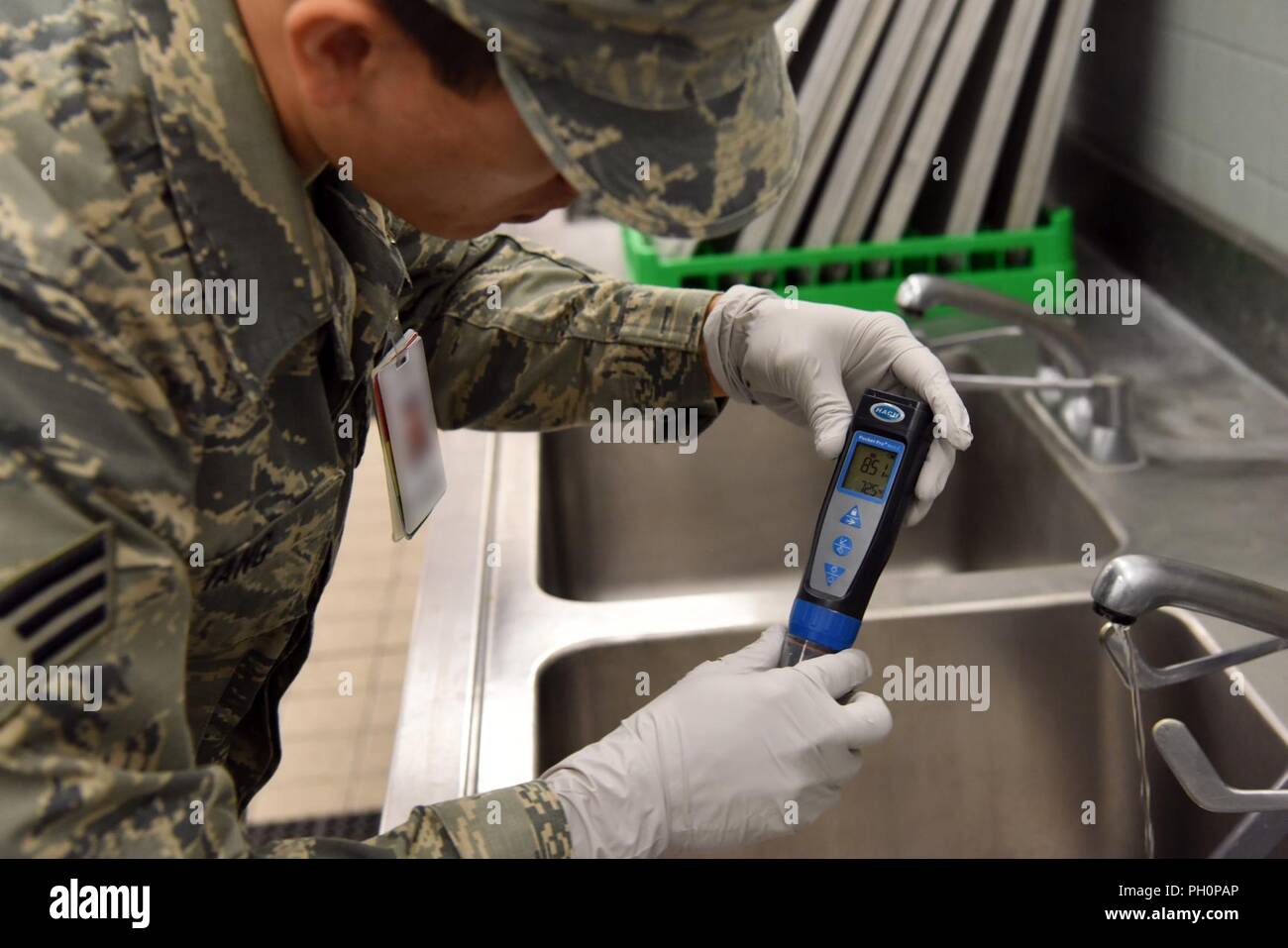 An Airman assigned to the 48th Aerospace Medicine Squadron Bioenvironmental Engineering flight checks the acidity levels of the drinking water at Royal Air Force Lakenheath, England, June 19, 2018. The 48th AMDS, Bioenvironmental Engineering flight uses engineering principles to check for pollutants and radioactive materials, implementing environmental protections, monitoring OSHA and NRC work safety standards and permits, and other duties to reduce health risks and dangers to Airmen. Stock Photohttps://www.alamy.com/image-license-details/?v=1https://www.alamy.com/an-airman-assigned-to-the-48th-aerospace-medicine-squadron-bioenvironmental-engineering-flight-checks-the-acidity-levels-of-the-drinking-water-at-royal-air-force-lakenheath-england-june-19-2018-the-48th-amds-bioenvironmental-engineering-flight-uses-engineering-principles-to-check-for-pollutants-and-radioactive-materials-implementing-environmental-protections-monitoring-osha-and-nrc-work-safety-standards-and-permits-and-other-duties-to-reduce-health-risks-and-dangers-to-airmen-image216991118.html
An Airman assigned to the 48th Aerospace Medicine Squadron Bioenvironmental Engineering flight checks the acidity levels of the drinking water at Royal Air Force Lakenheath, England, June 19, 2018. The 48th AMDS, Bioenvironmental Engineering flight uses engineering principles to check for pollutants and radioactive materials, implementing environmental protections, monitoring OSHA and NRC work safety standards and permits, and other duties to reduce health risks and dangers to Airmen. Stock Photohttps://www.alamy.com/image-license-details/?v=1https://www.alamy.com/an-airman-assigned-to-the-48th-aerospace-medicine-squadron-bioenvironmental-engineering-flight-checks-the-acidity-levels-of-the-drinking-water-at-royal-air-force-lakenheath-england-june-19-2018-the-48th-amds-bioenvironmental-engineering-flight-uses-engineering-principles-to-check-for-pollutants-and-radioactive-materials-implementing-environmental-protections-monitoring-osha-and-nrc-work-safety-standards-and-permits-and-other-duties-to-reduce-health-risks-and-dangers-to-airmen-image216991118.htmlRMPH0PAP–An Airman assigned to the 48th Aerospace Medicine Squadron Bioenvironmental Engineering flight checks the acidity levels of the drinking water at Royal Air Force Lakenheath, England, June 19, 2018. The 48th AMDS, Bioenvironmental Engineering flight uses engineering principles to check for pollutants and radioactive materials, implementing environmental protections, monitoring OSHA and NRC work safety standards and permits, and other duties to reduce health risks and dangers to Airmen.
 U.S. Air Force Maj. Roger Lee, a 60th Aerospace Medicine Squadron bioenvironmental engineering flight commander assigned to Travis Air Force Base, Calif., prepares Morgan, a sled dog on Team Jenssen, for the Iditarod sled dog race March 10, 2015, in Fairbanks, Alaska. Lee trained with dog sled teams in order to gain experience toward becoming a competitor in future races. Senior Airman Peter Reft Stock Photohttps://www.alamy.com/image-license-details/?v=1https://www.alamy.com/stock-photo-us-air-force-maj-roger-lee-a-60th-aerospace-medicine-squadron-bioenvironmental-129235973.html
U.S. Air Force Maj. Roger Lee, a 60th Aerospace Medicine Squadron bioenvironmental engineering flight commander assigned to Travis Air Force Base, Calif., prepares Morgan, a sled dog on Team Jenssen, for the Iditarod sled dog race March 10, 2015, in Fairbanks, Alaska. Lee trained with dog sled teams in order to gain experience toward becoming a competitor in future races. Senior Airman Peter Reft Stock Photohttps://www.alamy.com/image-license-details/?v=1https://www.alamy.com/stock-photo-us-air-force-maj-roger-lee-a-60th-aerospace-medicine-squadron-bioenvironmental-129235973.htmlRMHE75PD–U.S. Air Force Maj. Roger Lee, a 60th Aerospace Medicine Squadron bioenvironmental engineering flight commander assigned to Travis Air Force Base, Calif., prepares Morgan, a sled dog on Team Jenssen, for the Iditarod sled dog race March 10, 2015, in Fairbanks, Alaska. Lee trained with dog sled teams in order to gain experience toward becoming a competitor in future races. Senior Airman Peter Reft
 An Airman assigned to the 48th Aerospace Medicine Squadron Bioenvironmental Engineering flight tests the acidity levels of the drinking water at Royal Air Force Lakenheath, England, June 19, 2018. The 48th AMDS, Bioenvironmental Engineering flight uses engineering principles to check for pollutants and radioactive materials, implementing environmental protections, monitoring OSHA and NRC work safety standards and permits, and other duties to reduce health risks and dangers to Airmen. Stock Photohttps://www.alamy.com/image-license-details/?v=1https://www.alamy.com/an-airman-assigned-to-the-48th-aerospace-medicine-squadron-bioenvironmental-engineering-flight-tests-the-acidity-levels-of-the-drinking-water-at-royal-air-force-lakenheath-england-june-19-2018-the-48th-amds-bioenvironmental-engineering-flight-uses-engineering-principles-to-check-for-pollutants-and-radioactive-materials-implementing-environmental-protections-monitoring-osha-and-nrc-work-safety-standards-and-permits-and-other-duties-to-reduce-health-risks-and-dangers-to-airmen-image216991126.html
An Airman assigned to the 48th Aerospace Medicine Squadron Bioenvironmental Engineering flight tests the acidity levels of the drinking water at Royal Air Force Lakenheath, England, June 19, 2018. The 48th AMDS, Bioenvironmental Engineering flight uses engineering principles to check for pollutants and radioactive materials, implementing environmental protections, monitoring OSHA and NRC work safety standards and permits, and other duties to reduce health risks and dangers to Airmen. Stock Photohttps://www.alamy.com/image-license-details/?v=1https://www.alamy.com/an-airman-assigned-to-the-48th-aerospace-medicine-squadron-bioenvironmental-engineering-flight-tests-the-acidity-levels-of-the-drinking-water-at-royal-air-force-lakenheath-england-june-19-2018-the-48th-amds-bioenvironmental-engineering-flight-uses-engineering-principles-to-check-for-pollutants-and-radioactive-materials-implementing-environmental-protections-monitoring-osha-and-nrc-work-safety-standards-and-permits-and-other-duties-to-reduce-health-risks-and-dangers-to-airmen-image216991126.htmlRMPH0PB2–An Airman assigned to the 48th Aerospace Medicine Squadron Bioenvironmental Engineering flight tests the acidity levels of the drinking water at Royal Air Force Lakenheath, England, June 19, 2018. The 48th AMDS, Bioenvironmental Engineering flight uses engineering principles to check for pollutants and radioactive materials, implementing environmental protections, monitoring OSHA and NRC work safety standards and permits, and other duties to reduce health risks and dangers to Airmen.
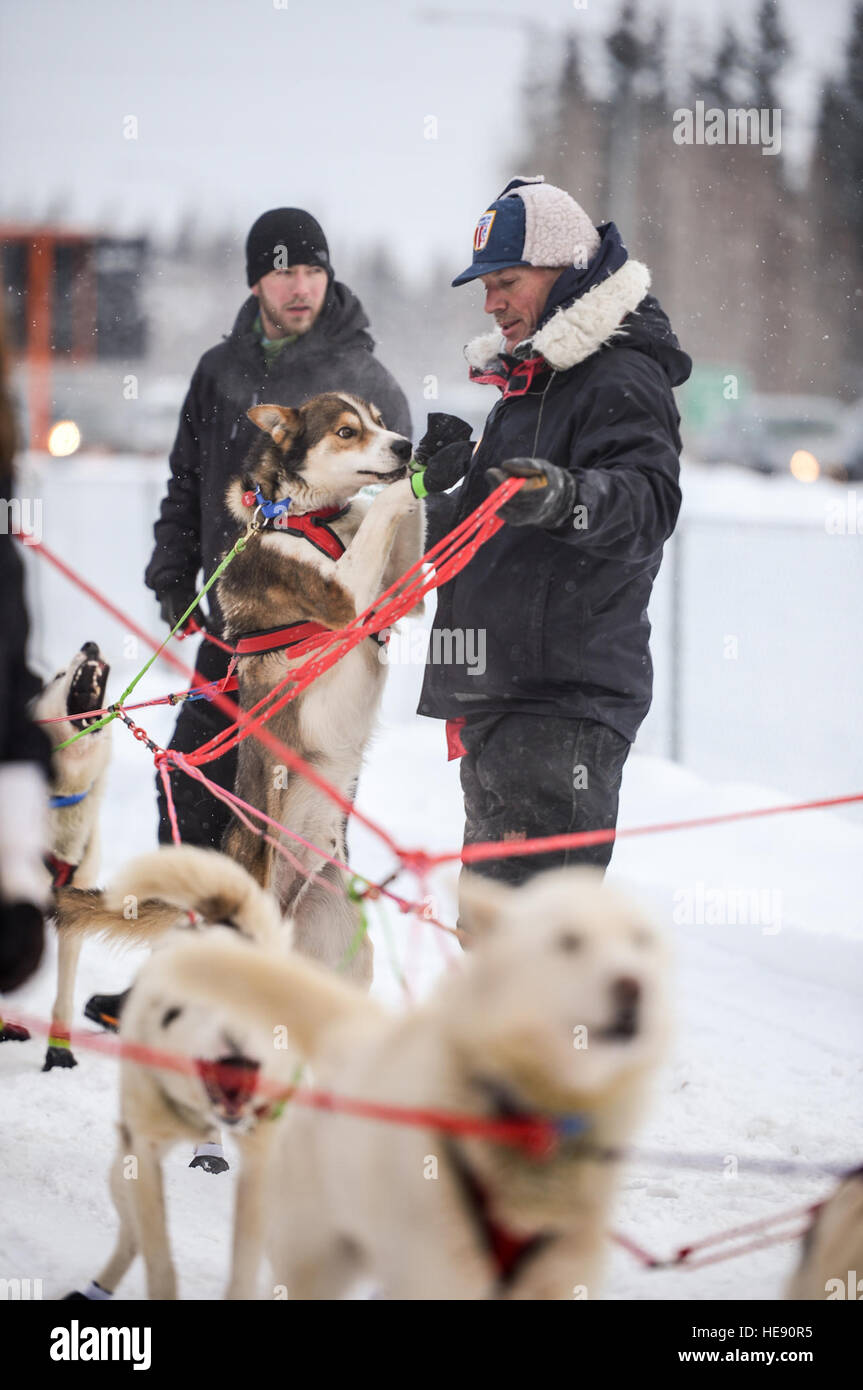 U.S. Air Force Maj. Roger Lee, a 60th Aerospace Medicine Squadron bioenvironmental engineering flight commander assigned to Travis Air Force Base, Calif., prepares Morgan, a sled dog on Team Jenssen, for the Iditarod sled dog race March 10, 2015, in Fairbanks, Alaska. Lee trained with dog sled teams in order to gain experience toward becoming a competitor in future races. Senior Airman Peter Reft Stock Photohttps://www.alamy.com/image-license-details/?v=1https://www.alamy.com/stock-photo-us-air-force-maj-roger-lee-a-60th-aerospace-medicine-squadron-bioenvironmental-129275977.html
U.S. Air Force Maj. Roger Lee, a 60th Aerospace Medicine Squadron bioenvironmental engineering flight commander assigned to Travis Air Force Base, Calif., prepares Morgan, a sled dog on Team Jenssen, for the Iditarod sled dog race March 10, 2015, in Fairbanks, Alaska. Lee trained with dog sled teams in order to gain experience toward becoming a competitor in future races. Senior Airman Peter Reft Stock Photohttps://www.alamy.com/image-license-details/?v=1https://www.alamy.com/stock-photo-us-air-force-maj-roger-lee-a-60th-aerospace-medicine-squadron-bioenvironmental-129275977.htmlRMHE90R5–U.S. Air Force Maj. Roger Lee, a 60th Aerospace Medicine Squadron bioenvironmental engineering flight commander assigned to Travis Air Force Base, Calif., prepares Morgan, a sled dog on Team Jenssen, for the Iditarod sled dog race March 10, 2015, in Fairbanks, Alaska. Lee trained with dog sled teams in order to gain experience toward becoming a competitor in future races. Senior Airman Peter Reft
 Staff Sgt. Marshall Varrato, 97th Medical Operations Squadron bioenvironmental engineering NCO in charge of readiness and training, adds a chlorine agent to a water sample during a routine water sampling at the main water line on base. The chlorine agent tests for residual chlorine in the water. Members of the 97th MDOS bioenvironmental engineering flight conduct water samplings twice a month. (U.S. Air Force photo by Senior Airman Kenneth W. Norman / Released) Stock Photohttps://www.alamy.com/image-license-details/?v=1https://www.alamy.com/stock-photo-staff-sgt-marshall-varrato-97th-medical-operations-squadron-bioenvironmental-129332029.html
Staff Sgt. Marshall Varrato, 97th Medical Operations Squadron bioenvironmental engineering NCO in charge of readiness and training, adds a chlorine agent to a water sample during a routine water sampling at the main water line on base. The chlorine agent tests for residual chlorine in the water. Members of the 97th MDOS bioenvironmental engineering flight conduct water samplings twice a month. (U.S. Air Force photo by Senior Airman Kenneth W. Norman / Released) Stock Photohttps://www.alamy.com/image-license-details/?v=1https://www.alamy.com/stock-photo-staff-sgt-marshall-varrato-97th-medical-operations-squadron-bioenvironmental-129332029.htmlRMHEBG91–Staff Sgt. Marshall Varrato, 97th Medical Operations Squadron bioenvironmental engineering NCO in charge of readiness and training, adds a chlorine agent to a water sample during a routine water sampling at the main water line on base. The chlorine agent tests for residual chlorine in the water. Members of the 97th MDOS bioenvironmental engineering flight conduct water samplings twice a month. (U.S. Air Force photo by Senior Airman Kenneth W. Norman / Released)
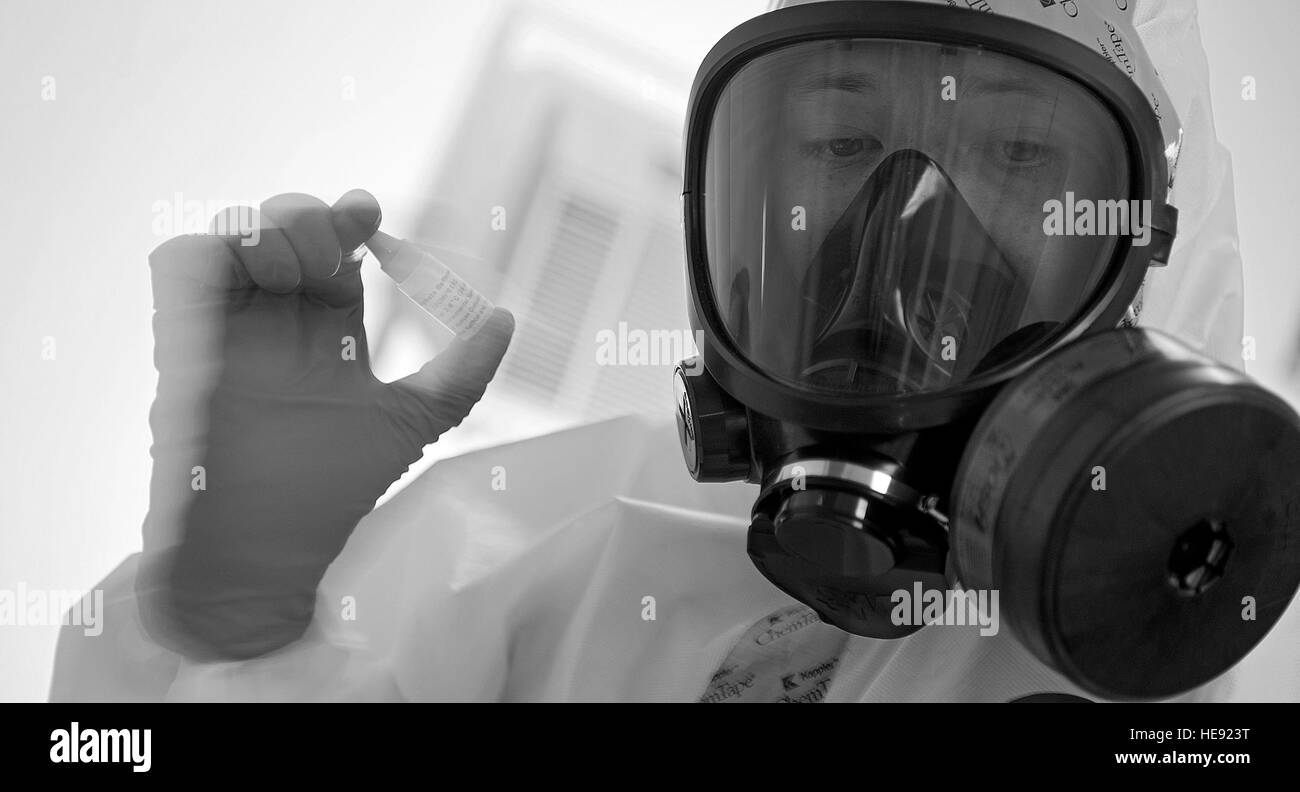 Staff Sgt. Daniel Burdick, 97th Medical Operations Support Squadron bioenvironmental engineering flight entry team member, runs a test on contaminants found in a simulated contaminated area as part of the all hazards chemical, biological, radiological and nuclear response (ACR) training, July 25. The Altus AFB ACR team ensure that responders who go in harm's way are protected and anything potentially criminal is investigated properly in line with crime scene evidence collection processes. Senior Airman Jesse Lopez / Released) Stock Photohttps://www.alamy.com/image-license-details/?v=1https://www.alamy.com/stock-photo-staff-sgt-daniel-burdick-97th-medical-operations-support-squadron-129277004.html
Staff Sgt. Daniel Burdick, 97th Medical Operations Support Squadron bioenvironmental engineering flight entry team member, runs a test on contaminants found in a simulated contaminated area as part of the all hazards chemical, biological, radiological and nuclear response (ACR) training, July 25. The Altus AFB ACR team ensure that responders who go in harm's way are protected and anything potentially criminal is investigated properly in line with crime scene evidence collection processes. Senior Airman Jesse Lopez / Released) Stock Photohttps://www.alamy.com/image-license-details/?v=1https://www.alamy.com/stock-photo-staff-sgt-daniel-burdick-97th-medical-operations-support-squadron-129277004.htmlRMHE923T–Staff Sgt. Daniel Burdick, 97th Medical Operations Support Squadron bioenvironmental engineering flight entry team member, runs a test on contaminants found in a simulated contaminated area as part of the all hazards chemical, biological, radiological and nuclear response (ACR) training, July 25. The Altus AFB ACR team ensure that responders who go in harm's way are protected and anything potentially criminal is investigated properly in line with crime scene evidence collection processes. Senior Airman Jesse Lopez / Released)
 ALTUS AIR FORCE BASE, Okla. – Master Sgt. Kenneth Estes, 97th Medical Operations Squadron NCO in charge of bioenvironmental engineering, prepares to add Phenol Red Solution to a water sample, July 16, 2013 during a routine water sampling. Members of the 97th MDOS bioenvironmental engineering flight routinely monitor for the presence of drinking water contaminants. The base receives its drinking water from the City of Altus water treatment plant. (U.S. Air Force photo by Senior Airman Kenneth W. Norman / Released) Stock Photohttps://www.alamy.com/image-license-details/?v=1https://www.alamy.com/stock-photo-altus-air-force-base-okla-master-sgt-kenneth-estes-97th-medical-operations-129332030.html
ALTUS AIR FORCE BASE, Okla. – Master Sgt. Kenneth Estes, 97th Medical Operations Squadron NCO in charge of bioenvironmental engineering, prepares to add Phenol Red Solution to a water sample, July 16, 2013 during a routine water sampling. Members of the 97th MDOS bioenvironmental engineering flight routinely monitor for the presence of drinking water contaminants. The base receives its drinking water from the City of Altus water treatment plant. (U.S. Air Force photo by Senior Airman Kenneth W. Norman / Released) Stock Photohttps://www.alamy.com/image-license-details/?v=1https://www.alamy.com/stock-photo-altus-air-force-base-okla-master-sgt-kenneth-estes-97th-medical-operations-129332030.htmlRMHEBG92–ALTUS AIR FORCE BASE, Okla. – Master Sgt. Kenneth Estes, 97th Medical Operations Squadron NCO in charge of bioenvironmental engineering, prepares to add Phenol Red Solution to a water sample, July 16, 2013 during a routine water sampling. Members of the 97th MDOS bioenvironmental engineering flight routinely monitor for the presence of drinking water contaminants. The base receives its drinking water from the City of Altus water treatment plant. (U.S. Air Force photo by Senior Airman Kenneth W. Norman / Released)
 Tech. Sgt. Saquadrea Crosby, 86th Aerospace Medicine Squadron public health noncommissioned officer-in-charge, gets fitted for an N95 respirator by the 86th Bioenvironmental Engineering flight at Ramstein Air Base, Germany, Oct. 17, 2014. The N95 respirator is a device that is used to help prevent the spread of germs (viruses and bacteria) from one person to another. As members of the 86th Airlift Wing continue to support missions for Operation United Assistance, Airmen who are expected to interact with returnees from Ebola infected areas will be fitted for the N95 respirators. (U.S. Air Force Stock Photohttps://www.alamy.com/image-license-details/?v=1https://www.alamy.com/stock-photo-tech-sgt-saquadrea-crosby-86th-aerospace-medicine-squadron-public-129338519.html
Tech. Sgt. Saquadrea Crosby, 86th Aerospace Medicine Squadron public health noncommissioned officer-in-charge, gets fitted for an N95 respirator by the 86th Bioenvironmental Engineering flight at Ramstein Air Base, Germany, Oct. 17, 2014. The N95 respirator is a device that is used to help prevent the spread of germs (viruses and bacteria) from one person to another. As members of the 86th Airlift Wing continue to support missions for Operation United Assistance, Airmen who are expected to interact with returnees from Ebola infected areas will be fitted for the N95 respirators. (U.S. Air Force Stock Photohttps://www.alamy.com/image-license-details/?v=1https://www.alamy.com/stock-photo-tech-sgt-saquadrea-crosby-86th-aerospace-medicine-squadron-public-129338519.htmlRMHEBTGR–Tech. Sgt. Saquadrea Crosby, 86th Aerospace Medicine Squadron public health noncommissioned officer-in-charge, gets fitted for an N95 respirator by the 86th Bioenvironmental Engineering flight at Ramstein Air Base, Germany, Oct. 17, 2014. The N95 respirator is a device that is used to help prevent the spread of germs (viruses and bacteria) from one person to another. As members of the 86th Airlift Wing continue to support missions for Operation United Assistance, Airmen who are expected to interact with returnees from Ebola infected areas will be fitted for the N95 respirators. (U.S. Air Force
 ALTUS AIR FORCE BASE, Okla. -- Staff Sgt. Marshall Varrato, 97th Medical Operations Squadron bioenvironmental engineering NCO in charge of readiness and training, fills out a bacteriological analysis form during a routine water sampling at Rivers Elementary School. Members of the 97th MDOS bioenvironmental engineering flight conduct water samplings twice a month. The samples are collected and then delivered to a lab in Elk City, Okla. where they are tested for contaminants. (U.S. Air Force photo by Senior Airman Kenneth W. Norman / Released) Stock Photohttps://www.alamy.com/image-license-details/?v=1https://www.alamy.com/stock-photo-altus-air-force-base-okla-staff-sgt-marshall-varrato-97th-medical-129332027.html
ALTUS AIR FORCE BASE, Okla. -- Staff Sgt. Marshall Varrato, 97th Medical Operations Squadron bioenvironmental engineering NCO in charge of readiness and training, fills out a bacteriological analysis form during a routine water sampling at Rivers Elementary School. Members of the 97th MDOS bioenvironmental engineering flight conduct water samplings twice a month. The samples are collected and then delivered to a lab in Elk City, Okla. where they are tested for contaminants. (U.S. Air Force photo by Senior Airman Kenneth W. Norman / Released) Stock Photohttps://www.alamy.com/image-license-details/?v=1https://www.alamy.com/stock-photo-altus-air-force-base-okla-staff-sgt-marshall-varrato-97th-medical-129332027.htmlRMHEBG8Y–ALTUS AIR FORCE BASE, Okla. -- Staff Sgt. Marshall Varrato, 97th Medical Operations Squadron bioenvironmental engineering NCO in charge of readiness and training, fills out a bacteriological analysis form during a routine water sampling at Rivers Elementary School. Members of the 97th MDOS bioenvironmental engineering flight conduct water samplings twice a month. The samples are collected and then delivered to a lab in Elk City, Okla. where they are tested for contaminants. (U.S. Air Force photo by Senior Airman Kenneth W. Norman / Released)
 An Airman assigned to the 48th Aerospace Medicine Squadron Bioenvironmental Engineering flight confirms the results of a water acidity test at Royal Air Force Lakenheath, England, June 19, 2018. The 48th AMDS, Bioenvironmental Engineering flight uses engineering principles to check for pollutants and radioactive materials, implementing environmental protections, monitoring OSHA and NRC work safety standards and permits, and other duties to reduce health risks and dangers to Airmen. Stock Photohttps://www.alamy.com/image-license-details/?v=1https://www.alamy.com/an-airman-assigned-to-the-48th-aerospace-medicine-squadron-bioenvironmental-engineering-flight-confirms-the-results-of-a-water-acidity-test-at-royal-air-force-lakenheath-england-june-19-2018-the-48th-amds-bioenvironmental-engineering-flight-uses-engineering-principles-to-check-for-pollutants-and-radioactive-materials-implementing-environmental-protections-monitoring-osha-and-nrc-work-safety-standards-and-permits-and-other-duties-to-reduce-health-risks-and-dangers-to-airmen-image216991130.html
An Airman assigned to the 48th Aerospace Medicine Squadron Bioenvironmental Engineering flight confirms the results of a water acidity test at Royal Air Force Lakenheath, England, June 19, 2018. The 48th AMDS, Bioenvironmental Engineering flight uses engineering principles to check for pollutants and radioactive materials, implementing environmental protections, monitoring OSHA and NRC work safety standards and permits, and other duties to reduce health risks and dangers to Airmen. Stock Photohttps://www.alamy.com/image-license-details/?v=1https://www.alamy.com/an-airman-assigned-to-the-48th-aerospace-medicine-squadron-bioenvironmental-engineering-flight-confirms-the-results-of-a-water-acidity-test-at-royal-air-force-lakenheath-england-june-19-2018-the-48th-amds-bioenvironmental-engineering-flight-uses-engineering-principles-to-check-for-pollutants-and-radioactive-materials-implementing-environmental-protections-monitoring-osha-and-nrc-work-safety-standards-and-permits-and-other-duties-to-reduce-health-risks-and-dangers-to-airmen-image216991130.htmlRMPH0PB6–An Airman assigned to the 48th Aerospace Medicine Squadron Bioenvironmental Engineering flight confirms the results of a water acidity test at Royal Air Force Lakenheath, England, June 19, 2018. The 48th AMDS, Bioenvironmental Engineering flight uses engineering principles to check for pollutants and radioactive materials, implementing environmental protections, monitoring OSHA and NRC work safety standards and permits, and other duties to reduce health risks and dangers to Airmen.
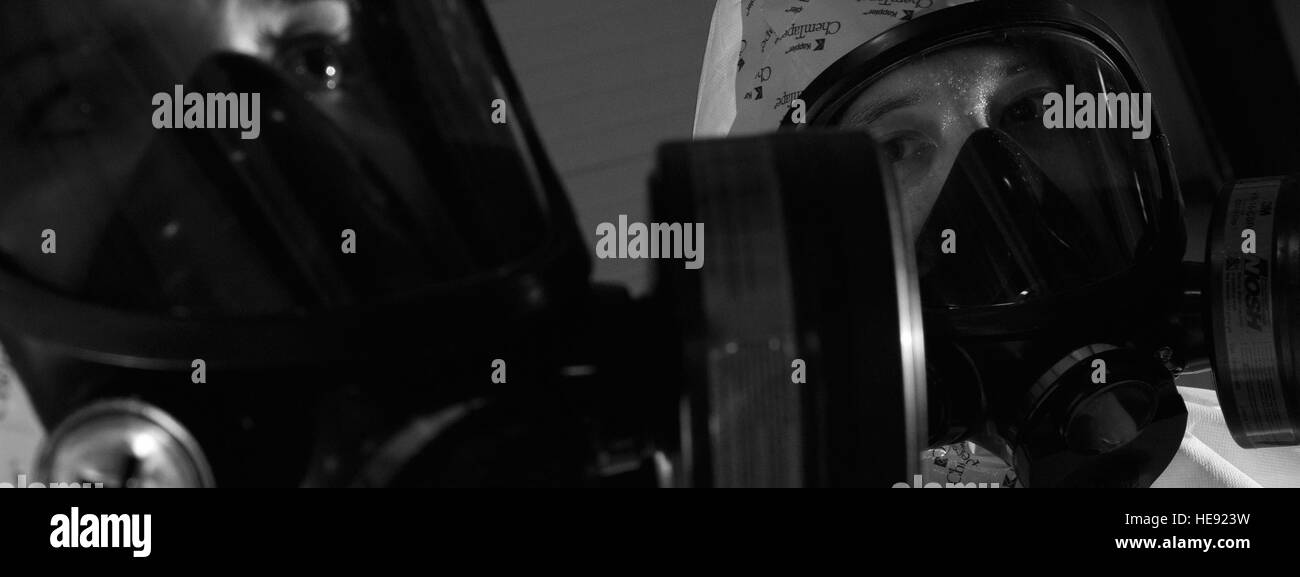 Senior Airman Jessica Paulson, 97th Civil Engineer Squadron emergency management flight entry team member, and Staff Sgt. Daniel Burdick, 97th Medical Operations Support Squadron bioenvironmental engineering flight entry team member, prepare for decontamination after a lengthy time spent in hazardous material suits as part of the all hazards chemical, biological, radiological, and nuclear response (ACR) training, July 25. The Altus AFB ACR team uses the training environment to allow for mistakes and utilizing them as lessons learned to improve skills. Real world responses create a pressure co Stock Photohttps://www.alamy.com/image-license-details/?v=1https://www.alamy.com/stock-photo-senior-airman-jessica-paulson-97th-civil-engineer-squadron-emergency-129277005.html
Senior Airman Jessica Paulson, 97th Civil Engineer Squadron emergency management flight entry team member, and Staff Sgt. Daniel Burdick, 97th Medical Operations Support Squadron bioenvironmental engineering flight entry team member, prepare for decontamination after a lengthy time spent in hazardous material suits as part of the all hazards chemical, biological, radiological, and nuclear response (ACR) training, July 25. The Altus AFB ACR team uses the training environment to allow for mistakes and utilizing them as lessons learned to improve skills. Real world responses create a pressure co Stock Photohttps://www.alamy.com/image-license-details/?v=1https://www.alamy.com/stock-photo-senior-airman-jessica-paulson-97th-civil-engineer-squadron-emergency-129277005.htmlRMHE923W–Senior Airman Jessica Paulson, 97th Civil Engineer Squadron emergency management flight entry team member, and Staff Sgt. Daniel Burdick, 97th Medical Operations Support Squadron bioenvironmental engineering flight entry team member, prepare for decontamination after a lengthy time spent in hazardous material suits as part of the all hazards chemical, biological, radiological, and nuclear response (ACR) training, July 25. The Altus AFB ACR team uses the training environment to allow for mistakes and utilizing them as lessons learned to improve skills. Real world responses create a pressure co
 ALTUS AIR FORCE BASE, Okla. -- Staff Sgt. Marshall Varrato, 97th Medical Operations Squadron bioenvironmental engineering NCO in charge of readiness and training, removes a water sample from a testing machine during a routine water sampling at the main water line on base. Members of the 97th MDOS bioenvironmental engineering flight conduct water samplings twice a month. The samples are collected and then delivered to a lab in Elk City, Okla. where they are tested for contaminants. (U.S. Air Force photo by Senior Airman Kenneth W. Norman / Released) Stock Photohttps://www.alamy.com/image-license-details/?v=1https://www.alamy.com/stock-photo-altus-air-force-base-okla-staff-sgt-marshall-varrato-97th-medical-129332028.html
ALTUS AIR FORCE BASE, Okla. -- Staff Sgt. Marshall Varrato, 97th Medical Operations Squadron bioenvironmental engineering NCO in charge of readiness and training, removes a water sample from a testing machine during a routine water sampling at the main water line on base. Members of the 97th MDOS bioenvironmental engineering flight conduct water samplings twice a month. The samples are collected and then delivered to a lab in Elk City, Okla. where they are tested for contaminants. (U.S. Air Force photo by Senior Airman Kenneth W. Norman / Released) Stock Photohttps://www.alamy.com/image-license-details/?v=1https://www.alamy.com/stock-photo-altus-air-force-base-okla-staff-sgt-marshall-varrato-97th-medical-129332028.htmlRMHEBG90–ALTUS AIR FORCE BASE, Okla. -- Staff Sgt. Marshall Varrato, 97th Medical Operations Squadron bioenvironmental engineering NCO in charge of readiness and training, removes a water sample from a testing machine during a routine water sampling at the main water line on base. Members of the 97th MDOS bioenvironmental engineering flight conduct water samplings twice a month. The samples are collected and then delivered to a lab in Elk City, Okla. where they are tested for contaminants. (U.S. Air Force photo by Senior Airman Kenneth W. Norman / Released)
 Staff Sgt. Hector Vaca Flores, 374th Aerospace Medicine Squadron bioenvironmental engineering flight technician, drives during a mission oriented protective posture driver training course at Yokota Air Base, Japan, Nov. 17, 2017. The driving exercises helped the Airmen become better acquainted with driving while wearing all of the gear. (U.S. Air Force photo by Staff Sgt. David Owsianka) Stock Photohttps://www.alamy.com/image-license-details/?v=1https://www.alamy.com/staff-sgt-hector-vaca-flores-374th-aerospace-medicine-squadron-bioenvironmental-engineering-flight-technician-drives-during-a-mission-oriented-protective-posture-driver-training-course-at-yokota-air-base-japan-nov-17-2017-the-driving-exercises-helped-the-airmen-become-better-acquainted-with-driving-while-wearing-all-of-the-gear-us-air-force-photo-by-staff-sgt-david-owsianka-image183955577.html
Staff Sgt. Hector Vaca Flores, 374th Aerospace Medicine Squadron bioenvironmental engineering flight technician, drives during a mission oriented protective posture driver training course at Yokota Air Base, Japan, Nov. 17, 2017. The driving exercises helped the Airmen become better acquainted with driving while wearing all of the gear. (U.S. Air Force photo by Staff Sgt. David Owsianka) Stock Photohttps://www.alamy.com/image-license-details/?v=1https://www.alamy.com/staff-sgt-hector-vaca-flores-374th-aerospace-medicine-squadron-bioenvironmental-engineering-flight-technician-drives-during-a-mission-oriented-protective-posture-driver-training-course-at-yokota-air-base-japan-nov-17-2017-the-driving-exercises-helped-the-airmen-become-better-acquainted-with-driving-while-wearing-all-of-the-gear-us-air-force-photo-by-staff-sgt-david-owsianka-image183955577.htmlRMMK7W61–Staff Sgt. Hector Vaca Flores, 374th Aerospace Medicine Squadron bioenvironmental engineering flight technician, drives during a mission oriented protective posture driver training course at Yokota Air Base, Japan, Nov. 17, 2017. The driving exercises helped the Airmen become better acquainted with driving while wearing all of the gear. (U.S. Air Force photo by Staff Sgt. David Owsianka)
 The 20th Aerospace Medicine Squadron bioenvironmental engineering flight (BEE) works to discover environmental hazards before they can affect the Shaw Air Force Base, S.C., community. They are also responsible for responding to various chemical, biological, radiological and nuclear incidents such as fuel spills. Stock Photohttps://www.alamy.com/image-license-details/?v=1https://www.alamy.com/the-20th-aerospace-medicine-squadron-bioenvironmental-engineering-flight-bee-works-to-discover-environmental-hazards-before-they-can-affect-the-shaw-air-force-base-sc-community-they-are-also-responsible-for-responding-to-various-chemical-biological-radiological-and-nuclear-incidents-such-as-fuel-spills-image235059806.html
The 20th Aerospace Medicine Squadron bioenvironmental engineering flight (BEE) works to discover environmental hazards before they can affect the Shaw Air Force Base, S.C., community. They are also responsible for responding to various chemical, biological, radiological and nuclear incidents such as fuel spills. Stock Photohttps://www.alamy.com/image-license-details/?v=1https://www.alamy.com/the-20th-aerospace-medicine-squadron-bioenvironmental-engineering-flight-bee-works-to-discover-environmental-hazards-before-they-can-affect-the-shaw-air-force-base-sc-community-they-are-also-responsible-for-responding-to-various-chemical-biological-radiological-and-nuclear-incidents-such-as-fuel-spills-image235059806.htmlRMRJBW52–The 20th Aerospace Medicine Squadron bioenvironmental engineering flight (BEE) works to discover environmental hazards before they can affect the Shaw Air Force Base, S.C., community. They are also responsible for responding to various chemical, biological, radiological and nuclear incidents such as fuel spills.
 Senior Airman Robert Sherwood, 374th Civil Engineer Squadron emergency manager, shows Airmen from the 374th Aerospace Medicine Squadron bioenvironmental engineering flight how to use a joint chemical agent detector at Yokota Air Base, Japan, Nov. 17, 2017. The JCAD automatically detects, identifies and alarms to chemical warfare agents and toxic chemical vapors. (U.S. Air Force photo by Staff Sgt. David Owsianka) Stock Photohttps://www.alamy.com/image-license-details/?v=1https://www.alamy.com/senior-airman-robert-sherwood-374th-civil-engineer-squadron-emergency-manager-shows-airmen-from-the-374th-aerospace-medicine-squadron-bioenvironmental-engineering-flight-how-to-use-a-joint-chemical-agent-detector-at-yokota-air-base-japan-nov-17-2017-the-jcad-automatically-detects-identifies-and-alarms-to-chemical-warfare-agents-and-toxic-chemical-vapors-us-air-force-photo-by-staff-sgt-david-owsianka-image183955569.html
Senior Airman Robert Sherwood, 374th Civil Engineer Squadron emergency manager, shows Airmen from the 374th Aerospace Medicine Squadron bioenvironmental engineering flight how to use a joint chemical agent detector at Yokota Air Base, Japan, Nov. 17, 2017. The JCAD automatically detects, identifies and alarms to chemical warfare agents and toxic chemical vapors. (U.S. Air Force photo by Staff Sgt. David Owsianka) Stock Photohttps://www.alamy.com/image-license-details/?v=1https://www.alamy.com/senior-airman-robert-sherwood-374th-civil-engineer-squadron-emergency-manager-shows-airmen-from-the-374th-aerospace-medicine-squadron-bioenvironmental-engineering-flight-how-to-use-a-joint-chemical-agent-detector-at-yokota-air-base-japan-nov-17-2017-the-jcad-automatically-detects-identifies-and-alarms-to-chemical-warfare-agents-and-toxic-chemical-vapors-us-air-force-photo-by-staff-sgt-david-owsianka-image183955569.htmlRMMK7W5N–Senior Airman Robert Sherwood, 374th Civil Engineer Squadron emergency manager, shows Airmen from the 374th Aerospace Medicine Squadron bioenvironmental engineering flight how to use a joint chemical agent detector at Yokota Air Base, Japan, Nov. 17, 2017. The JCAD automatically detects, identifies and alarms to chemical warfare agents and toxic chemical vapors. (U.S. Air Force photo by Staff Sgt. David Owsianka)
 Maj. Edgar Cedua, 374th Aerospace Medical Squadron bioenvironmental engineering flight commander, briefs personnel on chemical warfare agent air exposure guidelines and standards at Yokota Air Base, Japan, March 24, 2017. The training helped bioenvironmental and emergency management members gain a better understanding of how to effectively complete their mission during potential scenarios in the future. Stock Photohttps://www.alamy.com/image-license-details/?v=1https://www.alamy.com/maj-edgar-cedua-374th-aerospace-medical-squadron-bioenvironmental-engineering-flight-commander-briefs-personnel-on-chemical-warfare-agent-air-exposure-guidelines-and-standards-at-yokota-air-base-japan-march-24-2017-the-training-helped-bioenvironmental-and-emergency-management-members-gain-a-better-understanding-of-how-to-effectively-complete-their-mission-during-potential-scenarios-in-the-future-image228538018.html
Maj. Edgar Cedua, 374th Aerospace Medical Squadron bioenvironmental engineering flight commander, briefs personnel on chemical warfare agent air exposure guidelines and standards at Yokota Air Base, Japan, March 24, 2017. The training helped bioenvironmental and emergency management members gain a better understanding of how to effectively complete their mission during potential scenarios in the future. Stock Photohttps://www.alamy.com/image-license-details/?v=1https://www.alamy.com/maj-edgar-cedua-374th-aerospace-medical-squadron-bioenvironmental-engineering-flight-commander-briefs-personnel-on-chemical-warfare-agent-air-exposure-guidelines-and-standards-at-yokota-air-base-japan-march-24-2017-the-training-helped-bioenvironmental-and-emergency-management-members-gain-a-better-understanding-of-how-to-effectively-complete-their-mission-during-potential-scenarios-in-the-future-image228538018.htmlRMR7PPG2–Maj. Edgar Cedua, 374th Aerospace Medical Squadron bioenvironmental engineering flight commander, briefs personnel on chemical warfare agent air exposure guidelines and standards at Yokota Air Base, Japan, March 24, 2017. The training helped bioenvironmental and emergency management members gain a better understanding of how to effectively complete their mission during potential scenarios in the future.
 Senior Airman Julian Austria, 374th Aerospace Medicine Squadron bioenvironmental engineering flight technician, simulates using a joint chemical agent detector during a training scenario at Yokota Air Base, Japan, Nov. 17, 2017. The JCAD helps responding personnel know the type of chemical agent while being able to set up a cordon around the hazardous area. (U.S. Air Force photo by Staff Sgt. David Owsianka) Stock Photohttps://www.alamy.com/image-license-details/?v=1https://www.alamy.com/senior-airman-julian-austria-374th-aerospace-medicine-squadron-bioenvironmental-engineering-flight-technician-simulates-using-a-joint-chemical-agent-detector-during-a-training-scenario-at-yokota-air-base-japan-nov-17-2017-the-jcad-helps-responding-personnel-know-the-type-of-chemical-agent-while-being-able-to-set-up-a-cordon-around-the-hazardous-area-us-air-force-photo-by-staff-sgt-david-owsianka-image183955575.html
Senior Airman Julian Austria, 374th Aerospace Medicine Squadron bioenvironmental engineering flight technician, simulates using a joint chemical agent detector during a training scenario at Yokota Air Base, Japan, Nov. 17, 2017. The JCAD helps responding personnel know the type of chemical agent while being able to set up a cordon around the hazardous area. (U.S. Air Force photo by Staff Sgt. David Owsianka) Stock Photohttps://www.alamy.com/image-license-details/?v=1https://www.alamy.com/senior-airman-julian-austria-374th-aerospace-medicine-squadron-bioenvironmental-engineering-flight-technician-simulates-using-a-joint-chemical-agent-detector-during-a-training-scenario-at-yokota-air-base-japan-nov-17-2017-the-jcad-helps-responding-personnel-know-the-type-of-chemical-agent-while-being-able-to-set-up-a-cordon-around-the-hazardous-area-us-air-force-photo-by-staff-sgt-david-owsianka-image183955575.htmlRMMK7W5Y–Senior Airman Julian Austria, 374th Aerospace Medicine Squadron bioenvironmental engineering flight technician, simulates using a joint chemical agent detector during a training scenario at Yokota Air Base, Japan, Nov. 17, 2017. The JCAD helps responding personnel know the type of chemical agent while being able to set up a cordon around the hazardous area. (U.S. Air Force photo by Staff Sgt. David Owsianka)
 2nd Lt. Eric Olson, 23d Aerospace Medicine Squadron bioenvironmental engineer, gears up during readiness training, Jan. 12, 2018, at Moody Air Force Base, Ga. The Bioenvironmental Engineering Flight tested their response capabilities in a simulated contamination scenario. Bioenvironmental engineering specialists focus on reducing health hazards in the workplace and surrounding areas. (U.S. Air Force photo illustration by Airman 1st Class Erick Requadt) Stock Photohttps://www.alamy.com/image-license-details/?v=1https://www.alamy.com/2nd-lt-eric-olson-23d-aerospace-medicine-squadron-bioenvironmental-engineer-gears-up-during-readiness-training-jan-12-2018-at-moody-air-force-base-ga-the-bioenvironmental-engineering-flight-tested-their-response-capabilities-in-a-simulated-contamination-scenario-bioenvironmental-engineering-specialists-focus-on-reducing-health-hazards-in-the-workplace-and-surrounding-areas-us-air-force-photo-illustration-by-airman-1st-class-erick-requadt-image179481000.html
2nd Lt. Eric Olson, 23d Aerospace Medicine Squadron bioenvironmental engineer, gears up during readiness training, Jan. 12, 2018, at Moody Air Force Base, Ga. The Bioenvironmental Engineering Flight tested their response capabilities in a simulated contamination scenario. Bioenvironmental engineering specialists focus on reducing health hazards in the workplace and surrounding areas. (U.S. Air Force photo illustration by Airman 1st Class Erick Requadt) Stock Photohttps://www.alamy.com/image-license-details/?v=1https://www.alamy.com/2nd-lt-eric-olson-23d-aerospace-medicine-squadron-bioenvironmental-engineer-gears-up-during-readiness-training-jan-12-2018-at-moody-air-force-base-ga-the-bioenvironmental-engineering-flight-tested-their-response-capabilities-in-a-simulated-contamination-scenario-bioenvironmental-engineering-specialists-focus-on-reducing-health-hazards-in-the-workplace-and-surrounding-areas-us-air-force-photo-illustration-by-airman-1st-class-erick-requadt-image179481000.htmlRMMC01RM–2nd Lt. Eric Olson, 23d Aerospace Medicine Squadron bioenvironmental engineer, gears up during readiness training, Jan. 12, 2018, at Moody Air Force Base, Ga. The Bioenvironmental Engineering Flight tested their response capabilities in a simulated contamination scenario. Bioenvironmental engineering specialists focus on reducing health hazards in the workplace and surrounding areas. (U.S. Air Force photo illustration by Airman 1st Class Erick Requadt)
 Senior Airman Robert Sherwood, 374th Civil Engineer Squadron emergency manager, briefs personnel from the 374th Aerospace Medicine Squadron bioenvironmental engineering flight on how to properly respond to an area containing hazardous chemicals during a training scenario at Yokota Air Base, Japan, Nov. 17, 2017. Personnel from the bioenvironmental engineering flight learned multiple techniques on how to properly respond to chemical agents. (U.S. Air Force photo by Staff Sgt. David Owsianka) Stock Photohttps://www.alamy.com/image-license-details/?v=1https://www.alamy.com/senior-airman-robert-sherwood-374th-civil-engineer-squadron-emergency-manager-briefs-personnel-from-the-374th-aerospace-medicine-squadron-bioenvironmental-engineering-flight-on-how-to-properly-respond-to-an-area-containing-hazardous-chemicals-during-a-training-scenario-at-yokota-air-base-japan-nov-17-2017-personnel-from-the-bioenvironmental-engineering-flight-learned-multiple-techniques-on-how-to-properly-respond-to-chemical-agents-us-air-force-photo-by-staff-sgt-david-owsianka-image183955573.html
Senior Airman Robert Sherwood, 374th Civil Engineer Squadron emergency manager, briefs personnel from the 374th Aerospace Medicine Squadron bioenvironmental engineering flight on how to properly respond to an area containing hazardous chemicals during a training scenario at Yokota Air Base, Japan, Nov. 17, 2017. Personnel from the bioenvironmental engineering flight learned multiple techniques on how to properly respond to chemical agents. (U.S. Air Force photo by Staff Sgt. David Owsianka) Stock Photohttps://www.alamy.com/image-license-details/?v=1https://www.alamy.com/senior-airman-robert-sherwood-374th-civil-engineer-squadron-emergency-manager-briefs-personnel-from-the-374th-aerospace-medicine-squadron-bioenvironmental-engineering-flight-on-how-to-properly-respond-to-an-area-containing-hazardous-chemicals-during-a-training-scenario-at-yokota-air-base-japan-nov-17-2017-personnel-from-the-bioenvironmental-engineering-flight-learned-multiple-techniques-on-how-to-properly-respond-to-chemical-agents-us-air-force-photo-by-staff-sgt-david-owsianka-image183955573.htmlRMMK7W5W–Senior Airman Robert Sherwood, 374th Civil Engineer Squadron emergency manager, briefs personnel from the 374th Aerospace Medicine Squadron bioenvironmental engineering flight on how to properly respond to an area containing hazardous chemicals during a training scenario at Yokota Air Base, Japan, Nov. 17, 2017. Personnel from the bioenvironmental engineering flight learned multiple techniques on how to properly respond to chemical agents. (U.S. Air Force photo by Staff Sgt. David Owsianka)
 2nd Lt. Eric Olson, 23d Aerospace Medicine Squadron (AMDS) bioenvironmental engineer, secures a breathing apparatus during biohazard readiness training, Jan. 12, 2018, at Moody Air Force Base, Ga. The Bioenvironmental Engineering Flight tested their response capabilities in a simulated contamination scenario. Bioenvironmental engineering specialists focus on reducing health hazards in the workplace and surrounding areas. (U.S. Air Force photo by Airman 1st Class Erick Requadt) Stock Photohttps://www.alamy.com/image-license-details/?v=1https://www.alamy.com/2nd-lt-eric-olson-23d-aerospace-medicine-squadron-amds-bioenvironmental-engineer-secures-a-breathing-apparatus-during-biohazard-readiness-training-jan-12-2018-at-moody-air-force-base-ga-the-bioenvironmental-engineering-flight-tested-their-response-capabilities-in-a-simulated-contamination-scenario-bioenvironmental-engineering-specialists-focus-on-reducing-health-hazards-in-the-workplace-and-surrounding-areas-us-air-force-photo-by-airman-1st-class-erick-requadt-image179481005.html
2nd Lt. Eric Olson, 23d Aerospace Medicine Squadron (AMDS) bioenvironmental engineer, secures a breathing apparatus during biohazard readiness training, Jan. 12, 2018, at Moody Air Force Base, Ga. The Bioenvironmental Engineering Flight tested their response capabilities in a simulated contamination scenario. Bioenvironmental engineering specialists focus on reducing health hazards in the workplace and surrounding areas. (U.S. Air Force photo by Airman 1st Class Erick Requadt) Stock Photohttps://www.alamy.com/image-license-details/?v=1https://www.alamy.com/2nd-lt-eric-olson-23d-aerospace-medicine-squadron-amds-bioenvironmental-engineer-secures-a-breathing-apparatus-during-biohazard-readiness-training-jan-12-2018-at-moody-air-force-base-ga-the-bioenvironmental-engineering-flight-tested-their-response-capabilities-in-a-simulated-contamination-scenario-bioenvironmental-engineering-specialists-focus-on-reducing-health-hazards-in-the-workplace-and-surrounding-areas-us-air-force-photo-by-airman-1st-class-erick-requadt-image179481005.htmlRMMC01RW–2nd Lt. Eric Olson, 23d Aerospace Medicine Squadron (AMDS) bioenvironmental engineer, secures a breathing apparatus during biohazard readiness training, Jan. 12, 2018, at Moody Air Force Base, Ga. The Bioenvironmental Engineering Flight tested their response capabilities in a simulated contamination scenario. Bioenvironmental engineering specialists focus on reducing health hazards in the workplace and surrounding areas. (U.S. Air Force photo by Airman 1st Class Erick Requadt)
 Airman 1st Class Katrina Garcia, 374th Civil Engineer Squadron emergency manager, briefs Airmen from the 374th Aerospace Medicine Squadron bioenvironmental engineering flight on chemical, biological, radiological and nuclear reconnaissance techniques at Yokota Air Base, Japan, Nov. 17, 2017. The group also focused on equipment and supplies, communication, integrating the base populace and remaining efficient at responding to chemical agents being released during the briefing portion of the training. (U.S. Air Force photo by Staff Sgt. David Owsianka) Stock Photohttps://www.alamy.com/image-license-details/?v=1https://www.alamy.com/airman-1st-class-katrina-garcia-374th-civil-engineer-squadron-emergency-manager-briefs-airmen-from-the-374th-aerospace-medicine-squadron-bioenvironmental-engineering-flight-on-chemical-biological-radiological-and-nuclear-reconnaissance-techniques-at-yokota-air-base-japan-nov-17-2017-the-group-also-focused-on-equipment-and-supplies-communication-integrating-the-base-populace-and-remaining-efficient-at-responding-to-chemical-agents-being-released-during-the-briefing-portion-of-the-training-us-air-force-photo-by-staff-sgt-david-owsianka-image183955568.html
Airman 1st Class Katrina Garcia, 374th Civil Engineer Squadron emergency manager, briefs Airmen from the 374th Aerospace Medicine Squadron bioenvironmental engineering flight on chemical, biological, radiological and nuclear reconnaissance techniques at Yokota Air Base, Japan, Nov. 17, 2017. The group also focused on equipment and supplies, communication, integrating the base populace and remaining efficient at responding to chemical agents being released during the briefing portion of the training. (U.S. Air Force photo by Staff Sgt. David Owsianka) Stock Photohttps://www.alamy.com/image-license-details/?v=1https://www.alamy.com/airman-1st-class-katrina-garcia-374th-civil-engineer-squadron-emergency-manager-briefs-airmen-from-the-374th-aerospace-medicine-squadron-bioenvironmental-engineering-flight-on-chemical-biological-radiological-and-nuclear-reconnaissance-techniques-at-yokota-air-base-japan-nov-17-2017-the-group-also-focused-on-equipment-and-supplies-communication-integrating-the-base-populace-and-remaining-efficient-at-responding-to-chemical-agents-being-released-during-the-briefing-portion-of-the-training-us-air-force-photo-by-staff-sgt-david-owsianka-image183955568.htmlRMMK7W5M–Airman 1st Class Katrina Garcia, 374th Civil Engineer Squadron emergency manager, briefs Airmen from the 374th Aerospace Medicine Squadron bioenvironmental engineering flight on chemical, biological, radiological and nuclear reconnaissance techniques at Yokota Air Base, Japan, Nov. 17, 2017. The group also focused on equipment and supplies, communication, integrating the base populace and remaining efficient at responding to chemical agents being released during the briefing portion of the training. (U.S. Air Force photo by Staff Sgt. David Owsianka)
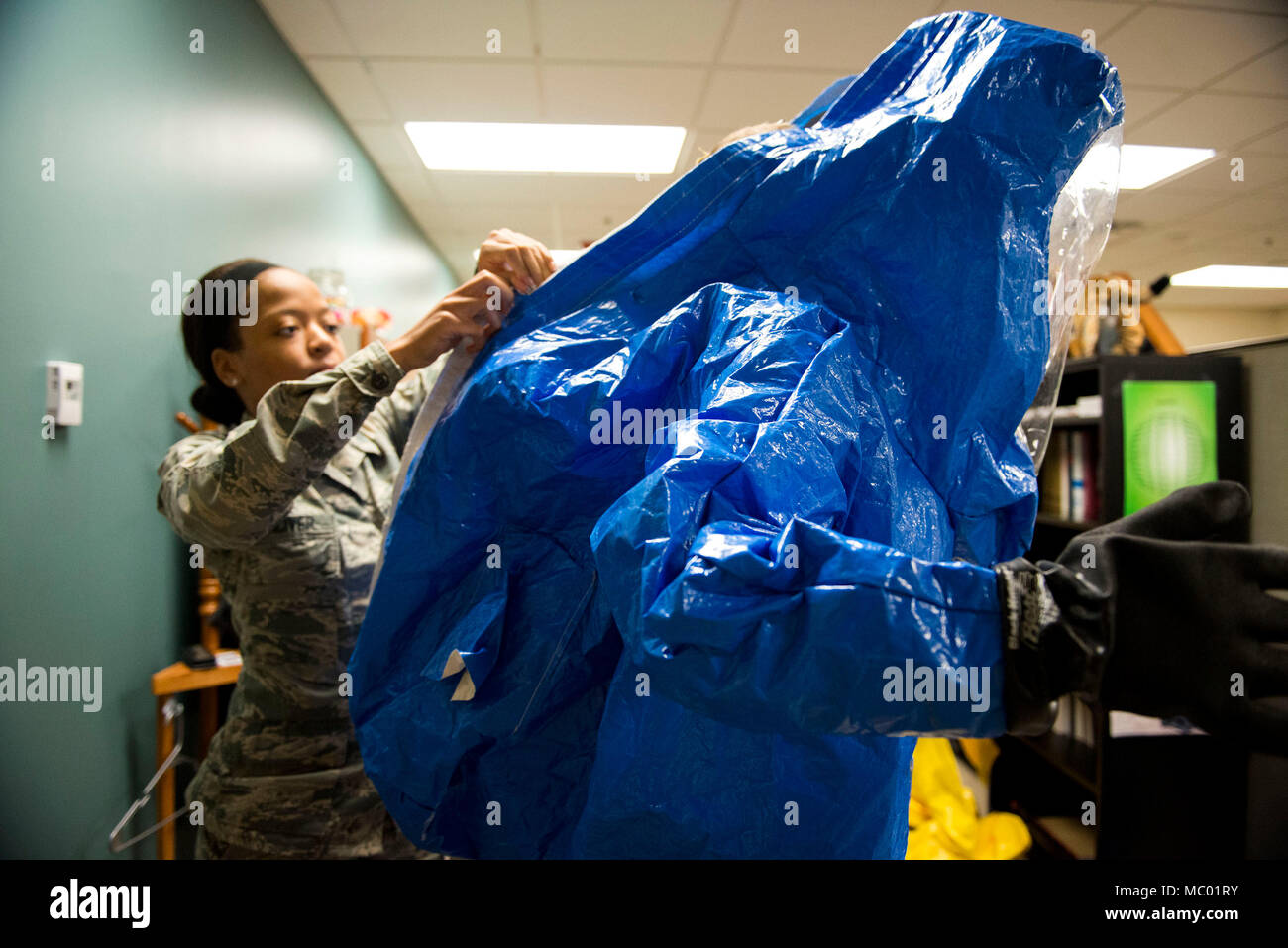 Airman 1st Class Briana McIver, left, 23d Aerospace Medicine Squadron (AMDS) bioenvironmental engineering apprentice, secures 2nd Lt. Eric Olson, 23d AMDS bioenvironmental engineer, in a Level A suit during readiness training, Jan. 12, 2018, at Moody Air Force Base, Ga. A Level A suit is designed to protect the user against any biological threat. The Bioenvironmental Engineering Flight tested their response capabilities in a simulated contamination scenario. Bioenvironmental engineering specialists focus on reducing health hazards in the workplace and surrounding areas. (U.S. Air Force photo b Stock Photohttps://www.alamy.com/image-license-details/?v=1https://www.alamy.com/airman-1st-class-briana-mciver-left-23d-aerospace-medicine-squadron-amds-bioenvironmental-engineering-apprentice-secures-2nd-lt-eric-olson-23d-amds-bioenvironmental-engineer-in-a-level-a-suit-during-readiness-training-jan-12-2018-at-moody-air-force-base-ga-a-level-a-suit-is-designed-to-protect-the-user-against-any-biological-threat-the-bioenvironmental-engineering-flight-tested-their-response-capabilities-in-a-simulated-contamination-scenario-bioenvironmental-engineering-specialists-focus-on-reducing-health-hazards-in-the-workplace-and-surrounding-areas-us-air-force-photo-b-image179481007.html
Airman 1st Class Briana McIver, left, 23d Aerospace Medicine Squadron (AMDS) bioenvironmental engineering apprentice, secures 2nd Lt. Eric Olson, 23d AMDS bioenvironmental engineer, in a Level A suit during readiness training, Jan. 12, 2018, at Moody Air Force Base, Ga. A Level A suit is designed to protect the user against any biological threat. The Bioenvironmental Engineering Flight tested their response capabilities in a simulated contamination scenario. Bioenvironmental engineering specialists focus on reducing health hazards in the workplace and surrounding areas. (U.S. Air Force photo b Stock Photohttps://www.alamy.com/image-license-details/?v=1https://www.alamy.com/airman-1st-class-briana-mciver-left-23d-aerospace-medicine-squadron-amds-bioenvironmental-engineering-apprentice-secures-2nd-lt-eric-olson-23d-amds-bioenvironmental-engineer-in-a-level-a-suit-during-readiness-training-jan-12-2018-at-moody-air-force-base-ga-a-level-a-suit-is-designed-to-protect-the-user-against-any-biological-threat-the-bioenvironmental-engineering-flight-tested-their-response-capabilities-in-a-simulated-contamination-scenario-bioenvironmental-engineering-specialists-focus-on-reducing-health-hazards-in-the-workplace-and-surrounding-areas-us-air-force-photo-b-image179481007.htmlRMMC01RY–Airman 1st Class Briana McIver, left, 23d Aerospace Medicine Squadron (AMDS) bioenvironmental engineering apprentice, secures 2nd Lt. Eric Olson, 23d AMDS bioenvironmental engineer, in a Level A suit during readiness training, Jan. 12, 2018, at Moody Air Force Base, Ga. A Level A suit is designed to protect the user against any biological threat. The Bioenvironmental Engineering Flight tested their response capabilities in a simulated contamination scenario. Bioenvironmental engineering specialists focus on reducing health hazards in the workplace and surrounding areas. (U.S. Air Force photo b
 An 8th Healthcare Operations Squadron bioenvironmental engineering technician, collects a water sample during a training event at Kunsan Air Base, Republic of Korea, Sept. 14, 2022. Water gathered from off-installation locations requires constant pH and chlorine level monitoring by the bioenvironmental flight to ensure installation water remains healthy to drink. Stock Photohttps://www.alamy.com/image-license-details/?v=1https://www.alamy.com/an-8th-healthcare-operations-squadron-bioenvironmental-engineering-technician-collects-a-water-sample-during-a-training-event-at-kunsan-air-base-republic-of-korea-sept-14-2022-water-gathered-from-off-installation-locations-requires-constant-ph-and-chlorine-level-monitoring-by-the-bioenvironmental-flight-to-ensure-installation-water-remains-healthy-to-drink-image511486944.html
An 8th Healthcare Operations Squadron bioenvironmental engineering technician, collects a water sample during a training event at Kunsan Air Base, Republic of Korea, Sept. 14, 2022. Water gathered from off-installation locations requires constant pH and chlorine level monitoring by the bioenvironmental flight to ensure installation water remains healthy to drink. Stock Photohttps://www.alamy.com/image-license-details/?v=1https://www.alamy.com/an-8th-healthcare-operations-squadron-bioenvironmental-engineering-technician-collects-a-water-sample-during-a-training-event-at-kunsan-air-base-republic-of-korea-sept-14-2022-water-gathered-from-off-installation-locations-requires-constant-ph-and-chlorine-level-monitoring-by-the-bioenvironmental-flight-to-ensure-installation-water-remains-healthy-to-drink-image511486944.htmlRM2MM46PT–An 8th Healthcare Operations Squadron bioenvironmental engineering technician, collects a water sample during a training event at Kunsan Air Base, Republic of Korea, Sept. 14, 2022. Water gathered from off-installation locations requires constant pH and chlorine level monitoring by the bioenvironmental flight to ensure installation water remains healthy to drink.
 Capt. James Reilly, the bioenvironmental engineering flight commander assigned to the 28th Medical Group, holds the Military Health Leadership Excellence award for junior non-providers at Ellsworth Air Force Base, S.D., Jan. 26, 2017. The MHLE award is an annual award given to those who display great innovation in the medical field and is presented to the top junior providers and non-providers from each branch of the Department of Defense. Stock Photohttps://www.alamy.com/image-license-details/?v=1https://www.alamy.com/capt-james-reilly-the-bioenvironmental-engineering-flight-commander-assigned-to-the-28th-medical-group-holds-the-military-health-leadership-excellence-award-for-junior-non-providers-at-ellsworth-air-force-base-sd-jan-26-2017-the-mhle-award-is-an-annual-award-given-to-those-who-display-great-innovation-in-the-medical-field-and-is-presented-to-the-top-junior-providers-and-non-providers-from-each-branch-of-the-department-of-defense-image230175390.html
Capt. James Reilly, the bioenvironmental engineering flight commander assigned to the 28th Medical Group, holds the Military Health Leadership Excellence award for junior non-providers at Ellsworth Air Force Base, S.D., Jan. 26, 2017. The MHLE award is an annual award given to those who display great innovation in the medical field and is presented to the top junior providers and non-providers from each branch of the Department of Defense. Stock Photohttps://www.alamy.com/image-license-details/?v=1https://www.alamy.com/capt-james-reilly-the-bioenvironmental-engineering-flight-commander-assigned-to-the-28th-medical-group-holds-the-military-health-leadership-excellence-award-for-junior-non-providers-at-ellsworth-air-force-base-sd-jan-26-2017-the-mhle-award-is-an-annual-award-given-to-those-who-display-great-innovation-in-the-medical-field-and-is-presented-to-the-top-junior-providers-and-non-providers-from-each-branch-of-the-department-of-defense-image230175390.htmlRMRADB1J–Capt. James Reilly, the bioenvironmental engineering flight commander assigned to the 28th Medical Group, holds the Military Health Leadership Excellence award for junior non-providers at Ellsworth Air Force Base, S.D., Jan. 26, 2017. The MHLE award is an annual award given to those who display great innovation in the medical field and is presented to the top junior providers and non-providers from each branch of the Department of Defense.
 An 8th Healthcare Operations Squadron bioenvironmental engineering technician, collects a water sample during a training event at Kunsan Air Base, Republic of Korea, Sept. 14, 2022. Water gathered from off-installation locations requires constant pH and chlorine level monitoring by the bioenvironmental flight to ensure installation water remains healthy to drink. Stock Photohttps://www.alamy.com/image-license-details/?v=1https://www.alamy.com/an-8th-healthcare-operations-squadron-bioenvironmental-engineering-technician-collects-a-water-sample-during-a-training-event-at-kunsan-air-base-republic-of-korea-sept-14-2022-water-gathered-from-off-installation-locations-requires-constant-ph-and-chlorine-level-monitoring-by-the-bioenvironmental-flight-to-ensure-installation-water-remains-healthy-to-drink-image491449452.html
An 8th Healthcare Operations Squadron bioenvironmental engineering technician, collects a water sample during a training event at Kunsan Air Base, Republic of Korea, Sept. 14, 2022. Water gathered from off-installation locations requires constant pH and chlorine level monitoring by the bioenvironmental flight to ensure installation water remains healthy to drink. Stock Photohttps://www.alamy.com/image-license-details/?v=1https://www.alamy.com/an-8th-healthcare-operations-squadron-bioenvironmental-engineering-technician-collects-a-water-sample-during-a-training-event-at-kunsan-air-base-republic-of-korea-sept-14-2022-water-gathered-from-off-installation-locations-requires-constant-ph-and-chlorine-level-monitoring-by-the-bioenvironmental-flight-to-ensure-installation-water-remains-healthy-to-drink-image491449452.htmlRM2KFFCP4–An 8th Healthcare Operations Squadron bioenvironmental engineering technician, collects a water sample during a training event at Kunsan Air Base, Republic of Korea, Sept. 14, 2022. Water gathered from off-installation locations requires constant pH and chlorine level monitoring by the bioenvironmental flight to ensure installation water remains healthy to drink.
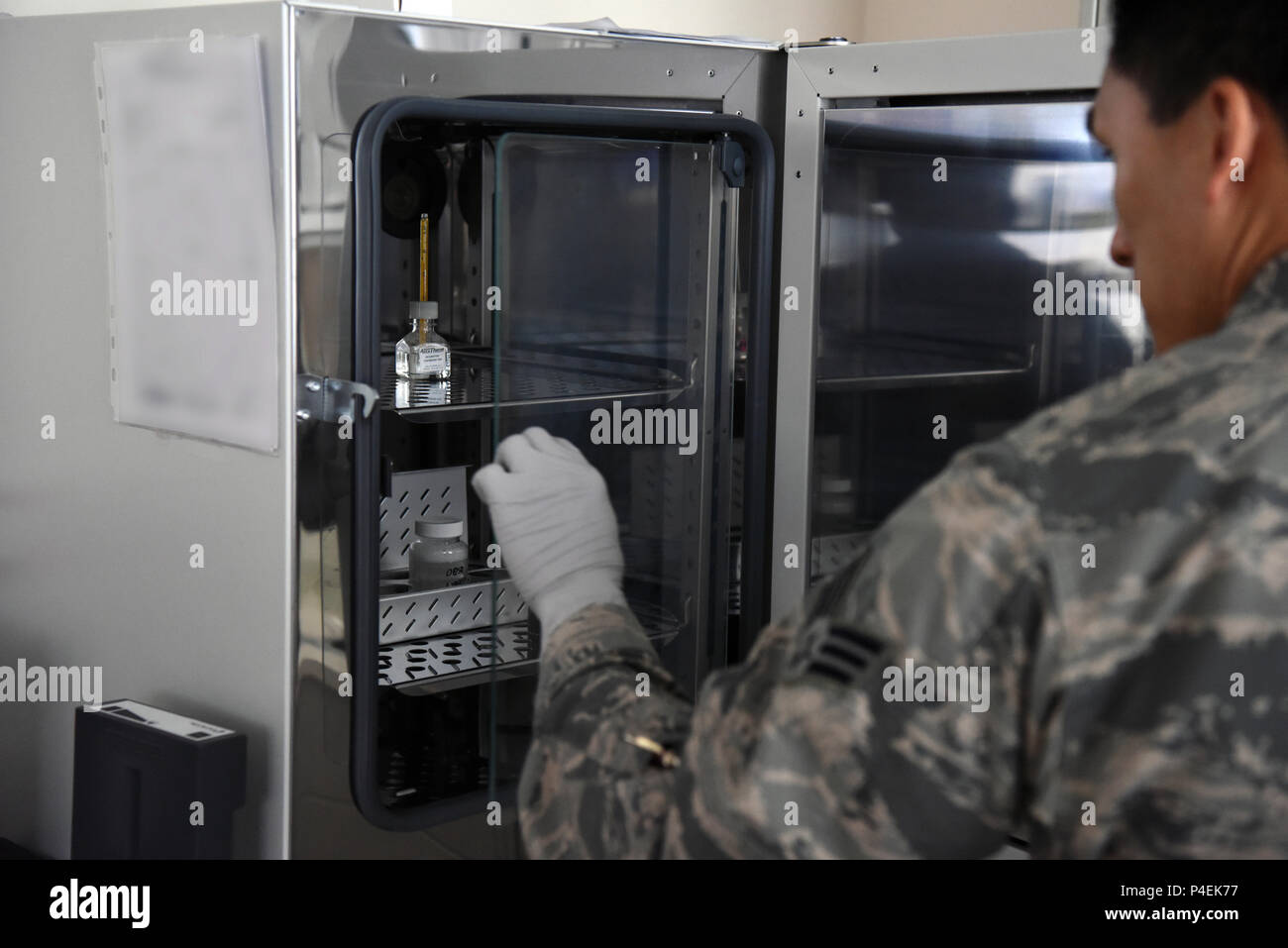 An Airman assigned to the 48th Aerospace Medicine Squadron Bioenvironmental Engineering flight places a water sample in an incubator at Royal Air Force Lakenheath, England, June 19, 2018. The 48th Bioenvironmental Engineering flight uses incubation of water samples as a form of testing for possible contaminants. (U.S. Air Force photo/ Airman 1st Class John A. Crawford) Stock Photohttps://www.alamy.com/image-license-details/?v=1https://www.alamy.com/an-airman-assigned-to-the-48th-aerospace-medicine-squadron-bioenvironmental-engineering-flight-places-a-water-sample-in-an-incubator-at-royal-air-force-lakenheath-england-june-19-2018-the-48th-bioenvironmental-engineering-flight-uses-incubation-of-water-samples-as-a-form-of-testing-for-possible-contaminants-us-air-force-photo-airman-1st-class-john-a-crawford-image209305467.html
An Airman assigned to the 48th Aerospace Medicine Squadron Bioenvironmental Engineering flight places a water sample in an incubator at Royal Air Force Lakenheath, England, June 19, 2018. The 48th Bioenvironmental Engineering flight uses incubation of water samples as a form of testing for possible contaminants. (U.S. Air Force photo/ Airman 1st Class John A. Crawford) Stock Photohttps://www.alamy.com/image-license-details/?v=1https://www.alamy.com/an-airman-assigned-to-the-48th-aerospace-medicine-squadron-bioenvironmental-engineering-flight-places-a-water-sample-in-an-incubator-at-royal-air-force-lakenheath-england-june-19-2018-the-48th-bioenvironmental-engineering-flight-uses-incubation-of-water-samples-as-a-form-of-testing-for-possible-contaminants-us-air-force-photo-airman-1st-class-john-a-crawford-image209305467.htmlRMP4EK77–An Airman assigned to the 48th Aerospace Medicine Squadron Bioenvironmental Engineering flight places a water sample in an incubator at Royal Air Force Lakenheath, England, June 19, 2018. The 48th Bioenvironmental Engineering flight uses incubation of water samples as a form of testing for possible contaminants. (U.S. Air Force photo/ Airman 1st Class John A. Crawford)
 Staff Sgt. Shane Pentheny, 22nd Civil Engineer Squadron Water and Fuels System Maintenance technician, performs water-quality tests on water taken from several base buildings March 9, 2017, at McConnell Air Force Base, Kan. In addition to WFSM’s daily tests, the 22nd Aerospace Medicine Squadron Bioenvironmental Engineering flight performs more in-depth tests on a weekly basis. Stock Photohttps://www.alamy.com/image-license-details/?v=1https://www.alamy.com/staff-sgt-shane-pentheny-22nd-civil-engineer-squadron-water-and-fuels-system-maintenance-technician-performs-water-quality-tests-on-water-taken-from-several-base-buildings-march-9-2017-at-mcconnell-air-force-base-kan-in-addition-to-wfsms-daily-tests-the-22nd-aerospace-medicine-squadron-bioenvironmental-engineering-flight-performs-more-in-depth-tests-on-a-weekly-basis-image229255382.html
Staff Sgt. Shane Pentheny, 22nd Civil Engineer Squadron Water and Fuels System Maintenance technician, performs water-quality tests on water taken from several base buildings March 9, 2017, at McConnell Air Force Base, Kan. In addition to WFSM’s daily tests, the 22nd Aerospace Medicine Squadron Bioenvironmental Engineering flight performs more in-depth tests on a weekly basis. Stock Photohttps://www.alamy.com/image-license-details/?v=1https://www.alamy.com/staff-sgt-shane-pentheny-22nd-civil-engineer-squadron-water-and-fuels-system-maintenance-technician-performs-water-quality-tests-on-water-taken-from-several-base-buildings-march-9-2017-at-mcconnell-air-force-base-kan-in-addition-to-wfsms-daily-tests-the-22nd-aerospace-medicine-squadron-bioenvironmental-engineering-flight-performs-more-in-depth-tests-on-a-weekly-basis-image229255382.htmlRMR8YDG6–Staff Sgt. Shane Pentheny, 22nd Civil Engineer Squadron Water and Fuels System Maintenance technician, performs water-quality tests on water taken from several base buildings March 9, 2017, at McConnell Air Force Base, Kan. In addition to WFSM’s daily tests, the 22nd Aerospace Medicine Squadron Bioenvironmental Engineering flight performs more in-depth tests on a weekly basis.
 Airman 1st Class An Ngo, 36th Medical Operations Squadron Bioenvironmental Engineering technician, sets up the Wet Bulb Global Temperature system at Andersen Air Force Base, Guam, Oct. 19, 2017. The Bioenvironmental Engineering Flight is responsible for testing Andersen’s water supply, heat index and air quality year round. (U.S. Air Force photo/Airman 1st Class Gerald R. Willis) Stock Photohttps://www.alamy.com/image-license-details/?v=1https://www.alamy.com/airman-1st-class-an-ngo-36th-medical-operations-squadron-bioenvironmental-engineering-technician-sets-up-the-wet-bulb-global-temperature-system-at-andersen-air-force-base-guam-oct-19-2017-the-bioenvironmental-engineering-flight-is-responsible-for-testing-andersens-water-supply-heat-index-and-air-quality-year-round-us-air-force-photoairman-1st-class-gerald-r-willis-image184722060.html
Airman 1st Class An Ngo, 36th Medical Operations Squadron Bioenvironmental Engineering technician, sets up the Wet Bulb Global Temperature system at Andersen Air Force Base, Guam, Oct. 19, 2017. The Bioenvironmental Engineering Flight is responsible for testing Andersen’s water supply, heat index and air quality year round. (U.S. Air Force photo/Airman 1st Class Gerald R. Willis) Stock Photohttps://www.alamy.com/image-license-details/?v=1https://www.alamy.com/airman-1st-class-an-ngo-36th-medical-operations-squadron-bioenvironmental-engineering-technician-sets-up-the-wet-bulb-global-temperature-system-at-andersen-air-force-base-guam-oct-19-2017-the-bioenvironmental-engineering-flight-is-responsible-for-testing-andersens-water-supply-heat-index-and-air-quality-year-round-us-air-force-photoairman-1st-class-gerald-r-willis-image184722060.htmlRMMMEPTC–Airman 1st Class An Ngo, 36th Medical Operations Squadron Bioenvironmental Engineering technician, sets up the Wet Bulb Global Temperature system at Andersen Air Force Base, Guam, Oct. 19, 2017. The Bioenvironmental Engineering Flight is responsible for testing Andersen’s water supply, heat index and air quality year round. (U.S. Air Force photo/Airman 1st Class Gerald R. Willis)
 2nd Lt. Eric Olson, 23d Aerospace Medicine Squadron bioenvironmental engineer, runs unknown samples through an assay during biohazard readiness training, Jan. 12, 2018, at Moody Air Force Base, Ga. An HHA distinguishes whether or not the sample is a deadly protein. The Bioenvironmental Engineering Flight tested their response capabilities in a simulated contamination scenario. Bioenvironmental engineering specialists focus on reducing health hazards in the workplace and surrounding areas. Stock Photohttps://www.alamy.com/image-license-details/?v=1https://www.alamy.com/2nd-lt-eric-olson-23d-aerospace-medicine-squadron-bioenvironmental-engineer-runs-unknown-samples-through-an-assay-during-biohazard-readiness-training-jan-12-2018-at-moody-air-force-base-ga-an-hha-distinguishes-whether-or-not-the-sample-is-a-deadly-protein-the-bioenvironmental-engineering-flight-tested-their-response-capabilities-in-a-simulated-contamination-scenario-bioenvironmental-engineering-specialists-focus-on-reducing-health-hazards-in-the-workplace-and-surrounding-areas-image235078621.html
2nd Lt. Eric Olson, 23d Aerospace Medicine Squadron bioenvironmental engineer, runs unknown samples through an assay during biohazard readiness training, Jan. 12, 2018, at Moody Air Force Base, Ga. An HHA distinguishes whether or not the sample is a deadly protein. The Bioenvironmental Engineering Flight tested their response capabilities in a simulated contamination scenario. Bioenvironmental engineering specialists focus on reducing health hazards in the workplace and surrounding areas. Stock Photohttps://www.alamy.com/image-license-details/?v=1https://www.alamy.com/2nd-lt-eric-olson-23d-aerospace-medicine-squadron-bioenvironmental-engineer-runs-unknown-samples-through-an-assay-during-biohazard-readiness-training-jan-12-2018-at-moody-air-force-base-ga-an-hha-distinguishes-whether-or-not-the-sample-is-a-deadly-protein-the-bioenvironmental-engineering-flight-tested-their-response-capabilities-in-a-simulated-contamination-scenario-bioenvironmental-engineering-specialists-focus-on-reducing-health-hazards-in-the-workplace-and-surrounding-areas-image235078621.htmlRMRJCN51–2nd Lt. Eric Olson, 23d Aerospace Medicine Squadron bioenvironmental engineer, runs unknown samples through an assay during biohazard readiness training, Jan. 12, 2018, at Moody Air Force Base, Ga. An HHA distinguishes whether or not the sample is a deadly protein. The Bioenvironmental Engineering Flight tested their response capabilities in a simulated contamination scenario. Bioenvironmental engineering specialists focus on reducing health hazards in the workplace and surrounding areas.
 Airman 1st Class An Ngo, 36th Medical Operations Squadron Bioenvironmental Engineering technician, uses a water sample test kit at Andersen Air Force Base, Guam, Oct. 19, 2017. The Bioenvironmental Engineering Flight is responsible for testing Andersen’s water supply, heat index and air quality year round. (U.S. Air Force photo/Airman 1st Class Gerald R. Willis) Stock Photohttps://www.alamy.com/image-license-details/?v=1https://www.alamy.com/airman-1st-class-an-ngo-36th-medical-operations-squadron-bioenvironmental-engineering-technician-uses-a-water-sample-test-kit-at-andersen-air-force-base-guam-oct-19-2017-the-bioenvironmental-engineering-flight-is-responsible-for-testing-andersens-water-supply-heat-index-and-air-quality-year-round-us-air-force-photoairman-1st-class-gerald-r-willis-image184722061.html
Airman 1st Class An Ngo, 36th Medical Operations Squadron Bioenvironmental Engineering technician, uses a water sample test kit at Andersen Air Force Base, Guam, Oct. 19, 2017. The Bioenvironmental Engineering Flight is responsible for testing Andersen’s water supply, heat index and air quality year round. (U.S. Air Force photo/Airman 1st Class Gerald R. Willis) Stock Photohttps://www.alamy.com/image-license-details/?v=1https://www.alamy.com/airman-1st-class-an-ngo-36th-medical-operations-squadron-bioenvironmental-engineering-technician-uses-a-water-sample-test-kit-at-andersen-air-force-base-guam-oct-19-2017-the-bioenvironmental-engineering-flight-is-responsible-for-testing-andersens-water-supply-heat-index-and-air-quality-year-round-us-air-force-photoairman-1st-class-gerald-r-willis-image184722061.htmlRMMMEPTD–Airman 1st Class An Ngo, 36th Medical Operations Squadron Bioenvironmental Engineering technician, uses a water sample test kit at Andersen Air Force Base, Guam, Oct. 19, 2017. The Bioenvironmental Engineering Flight is responsible for testing Andersen’s water supply, heat index and air quality year round. (U.S. Air Force photo/Airman 1st Class Gerald R. Willis)
 U.S. Air Force Senior Airman Brandon Burgess, 20th Aerospace Medicine Squadron bioenvironmental journeyman, prepares gas masks for fit testing at Shaw Air Force Base, S.C., Jan. 12, 2018. The bioenvironmental engineering flight does a gas mask fit test for Airmen on the installation to prepare them for deployments. (U.S. Air Force photo by Senior Airman Destinee Sweeney) Stock Photohttps://www.alamy.com/image-license-details/?v=1https://www.alamy.com/us-air-force-senior-airman-brandon-burgess-20th-aerospace-medicine-squadron-bioenvironmental-journeyman-prepares-gas-masks-for-fit-testing-at-shaw-air-force-base-sc-jan-12-2018-the-bioenvironmental-engineering-flight-does-a-gas-mask-fit-test-for-airmen-on-the-installation-to-prepare-them-for-deployments-us-air-force-photo-by-senior-airman-destinee-sweeney-image179438244.html
U.S. Air Force Senior Airman Brandon Burgess, 20th Aerospace Medicine Squadron bioenvironmental journeyman, prepares gas masks for fit testing at Shaw Air Force Base, S.C., Jan. 12, 2018. The bioenvironmental engineering flight does a gas mask fit test for Airmen on the installation to prepare them for deployments. (U.S. Air Force photo by Senior Airman Destinee Sweeney) Stock Photohttps://www.alamy.com/image-license-details/?v=1https://www.alamy.com/us-air-force-senior-airman-brandon-burgess-20th-aerospace-medicine-squadron-bioenvironmental-journeyman-prepares-gas-masks-for-fit-testing-at-shaw-air-force-base-sc-jan-12-2018-the-bioenvironmental-engineering-flight-does-a-gas-mask-fit-test-for-airmen-on-the-installation-to-prepare-them-for-deployments-us-air-force-photo-by-senior-airman-destinee-sweeney-image179438244.htmlRMMBX38M–U.S. Air Force Senior Airman Brandon Burgess, 20th Aerospace Medicine Squadron bioenvironmental journeyman, prepares gas masks for fit testing at Shaw Air Force Base, S.C., Jan. 12, 2018. The bioenvironmental engineering flight does a gas mask fit test for Airmen on the installation to prepare them for deployments. (U.S. Air Force photo by Senior Airman Destinee Sweeney)
 Airman 1st Class Briana McIver, left, 23d Aerospace Medicine Squadron (AMDS) bioenvironmental engineering apprentice, and 2nd Lt. Eric Olson, 23d AMDS bioenvironmental engineer, read instructions for a hand held assay (HHA) during biohazard readiness training, Jan. 12, 2018, at Moody Air Force Base, Ga. An HHA distinguishes whether or not the sample is a deadly protein. This process of going through the instructions ensures standardization of sampling. The Bioenvironmental Engineering Flight tested their response capabilities in a simulated contamination scenario. Bioenvironmental engineering Stock Photohttps://www.alamy.com/image-license-details/?v=1https://www.alamy.com/airman-1st-class-briana-mciver-left-23d-aerospace-medicine-squadron-amds-bioenvironmental-engineering-apprentice-and-2nd-lt-eric-olson-23d-amds-bioenvironmental-engineer-read-instructions-for-a-hand-held-assay-hha-during-biohazard-readiness-training-jan-12-2018-at-moody-air-force-base-ga-an-hha-distinguishes-whether-or-not-the-sample-is-a-deadly-protein-this-process-of-going-through-the-instructions-ensures-standardization-of-sampling-the-bioenvironmental-engineering-flight-tested-their-response-capabilities-in-a-simulated-contamination-scenario-bioenvironmental-engineering-image235078622.html
Airman 1st Class Briana McIver, left, 23d Aerospace Medicine Squadron (AMDS) bioenvironmental engineering apprentice, and 2nd Lt. Eric Olson, 23d AMDS bioenvironmental engineer, read instructions for a hand held assay (HHA) during biohazard readiness training, Jan. 12, 2018, at Moody Air Force Base, Ga. An HHA distinguishes whether or not the sample is a deadly protein. This process of going through the instructions ensures standardization of sampling. The Bioenvironmental Engineering Flight tested their response capabilities in a simulated contamination scenario. Bioenvironmental engineering Stock Photohttps://www.alamy.com/image-license-details/?v=1https://www.alamy.com/airman-1st-class-briana-mciver-left-23d-aerospace-medicine-squadron-amds-bioenvironmental-engineering-apprentice-and-2nd-lt-eric-olson-23d-amds-bioenvironmental-engineer-read-instructions-for-a-hand-held-assay-hha-during-biohazard-readiness-training-jan-12-2018-at-moody-air-force-base-ga-an-hha-distinguishes-whether-or-not-the-sample-is-a-deadly-protein-this-process-of-going-through-the-instructions-ensures-standardization-of-sampling-the-bioenvironmental-engineering-flight-tested-their-response-capabilities-in-a-simulated-contamination-scenario-bioenvironmental-engineering-image235078622.htmlRMRJCN52–Airman 1st Class Briana McIver, left, 23d Aerospace Medicine Squadron (AMDS) bioenvironmental engineering apprentice, and 2nd Lt. Eric Olson, 23d AMDS bioenvironmental engineer, read instructions for a hand held assay (HHA) during biohazard readiness training, Jan. 12, 2018, at Moody Air Force Base, Ga. An HHA distinguishes whether or not the sample is a deadly protein. This process of going through the instructions ensures standardization of sampling. The Bioenvironmental Engineering Flight tested their response capabilities in a simulated contamination scenario. Bioenvironmental engineering
 U.S. Air Force Airman 1st Class Jackson Gordon, 20th Aerospace Medicine Squadron bioenvironmental apprentice, prepares an x-ray probe for calibration at Shaw Air Force Base, S.C., Jan. 12, 2018. The bioenvironmental engineering flight is responsible for calibrating some of their tools, such as the x-ray probe, to ensure accuracy when they monitor hazards in workplaces. (U.S. Air Force photo by Senior Airman Destinee Sweeney) Stock Photohttps://www.alamy.com/image-license-details/?v=1https://www.alamy.com/us-air-force-airman-1st-class-jackson-gordon-20th-aerospace-medicine-squadron-bioenvironmental-apprentice-prepares-an-x-ray-probe-for-calibration-at-shaw-air-force-base-sc-jan-12-2018-the-bioenvironmental-engineering-flight-is-responsible-for-calibrating-some-of-their-tools-such-as-the-x-ray-probe-to-ensure-accuracy-when-they-monitor-hazards-in-workplaces-us-air-force-photo-by-senior-airman-destinee-sweeney-image179438232.html
U.S. Air Force Airman 1st Class Jackson Gordon, 20th Aerospace Medicine Squadron bioenvironmental apprentice, prepares an x-ray probe for calibration at Shaw Air Force Base, S.C., Jan. 12, 2018. The bioenvironmental engineering flight is responsible for calibrating some of their tools, such as the x-ray probe, to ensure accuracy when they monitor hazards in workplaces. (U.S. Air Force photo by Senior Airman Destinee Sweeney) Stock Photohttps://www.alamy.com/image-license-details/?v=1https://www.alamy.com/us-air-force-airman-1st-class-jackson-gordon-20th-aerospace-medicine-squadron-bioenvironmental-apprentice-prepares-an-x-ray-probe-for-calibration-at-shaw-air-force-base-sc-jan-12-2018-the-bioenvironmental-engineering-flight-is-responsible-for-calibrating-some-of-their-tools-such-as-the-x-ray-probe-to-ensure-accuracy-when-they-monitor-hazards-in-workplaces-us-air-force-photo-by-senior-airman-destinee-sweeney-image179438232.htmlRMMBX388–U.S. Air Force Airman 1st Class Jackson Gordon, 20th Aerospace Medicine Squadron bioenvironmental apprentice, prepares an x-ray probe for calibration at Shaw Air Force Base, S.C., Jan. 12, 2018. The bioenvironmental engineering flight is responsible for calibrating some of their tools, such as the x-ray probe, to ensure accuracy when they monitor hazards in workplaces. (U.S. Air Force photo by Senior Airman Destinee Sweeney)
 Senior Airman Alexander Delfs, 436th Aerospace Medicine Squadron bioenvironmental engineering journeyman, collects a water sample for bacteriologic testing Nov. 16, 2016, at an aircraft watering point on Dover Air Force Base, Del. Members of the 436th AMDS bioenvironmental engineering flight send water samples to a laboratory to test for the presence of harmful bacteria in drinking water. (U.S. Air Force photo by Senior Airman Aaron J. Jenne) Stock Photohttps://www.alamy.com/image-license-details/?v=1https://www.alamy.com/senior-airman-alexander-delfs-436th-aerospace-medicine-squadron-bioenvironmental-engineering-journeyman-collects-a-water-sample-for-bacteriologic-testing-nov-16-2016-at-an-aircraft-watering-point-on-dover-air-force-base-del-members-of-the-436th-amds-bioenvironmental-engineering-flight-send-water-samples-to-a-laboratory-to-test-for-the-presence-of-harmful-bacteria-in-drinking-water-us-air-force-photo-by-senior-airman-aaron-j-jenne-image188669613.html
Senior Airman Alexander Delfs, 436th Aerospace Medicine Squadron bioenvironmental engineering journeyman, collects a water sample for bacteriologic testing Nov. 16, 2016, at an aircraft watering point on Dover Air Force Base, Del. Members of the 436th AMDS bioenvironmental engineering flight send water samples to a laboratory to test for the presence of harmful bacteria in drinking water. (U.S. Air Force photo by Senior Airman Aaron J. Jenne) Stock Photohttps://www.alamy.com/image-license-details/?v=1https://www.alamy.com/senior-airman-alexander-delfs-436th-aerospace-medicine-squadron-bioenvironmental-engineering-journeyman-collects-a-water-sample-for-bacteriologic-testing-nov-16-2016-at-an-aircraft-watering-point-on-dover-air-force-base-del-members-of-the-436th-amds-bioenvironmental-engineering-flight-send-water-samples-to-a-laboratory-to-test-for-the-presence-of-harmful-bacteria-in-drinking-water-us-air-force-photo-by-senior-airman-aaron-j-jenne-image188669613.htmlRMMXXJ0D–Senior Airman Alexander Delfs, 436th Aerospace Medicine Squadron bioenvironmental engineering journeyman, collects a water sample for bacteriologic testing Nov. 16, 2016, at an aircraft watering point on Dover Air Force Base, Del. Members of the 436th AMDS bioenvironmental engineering flight send water samples to a laboratory to test for the presence of harmful bacteria in drinking water. (U.S. Air Force photo by Senior Airman Aaron J. Jenne)
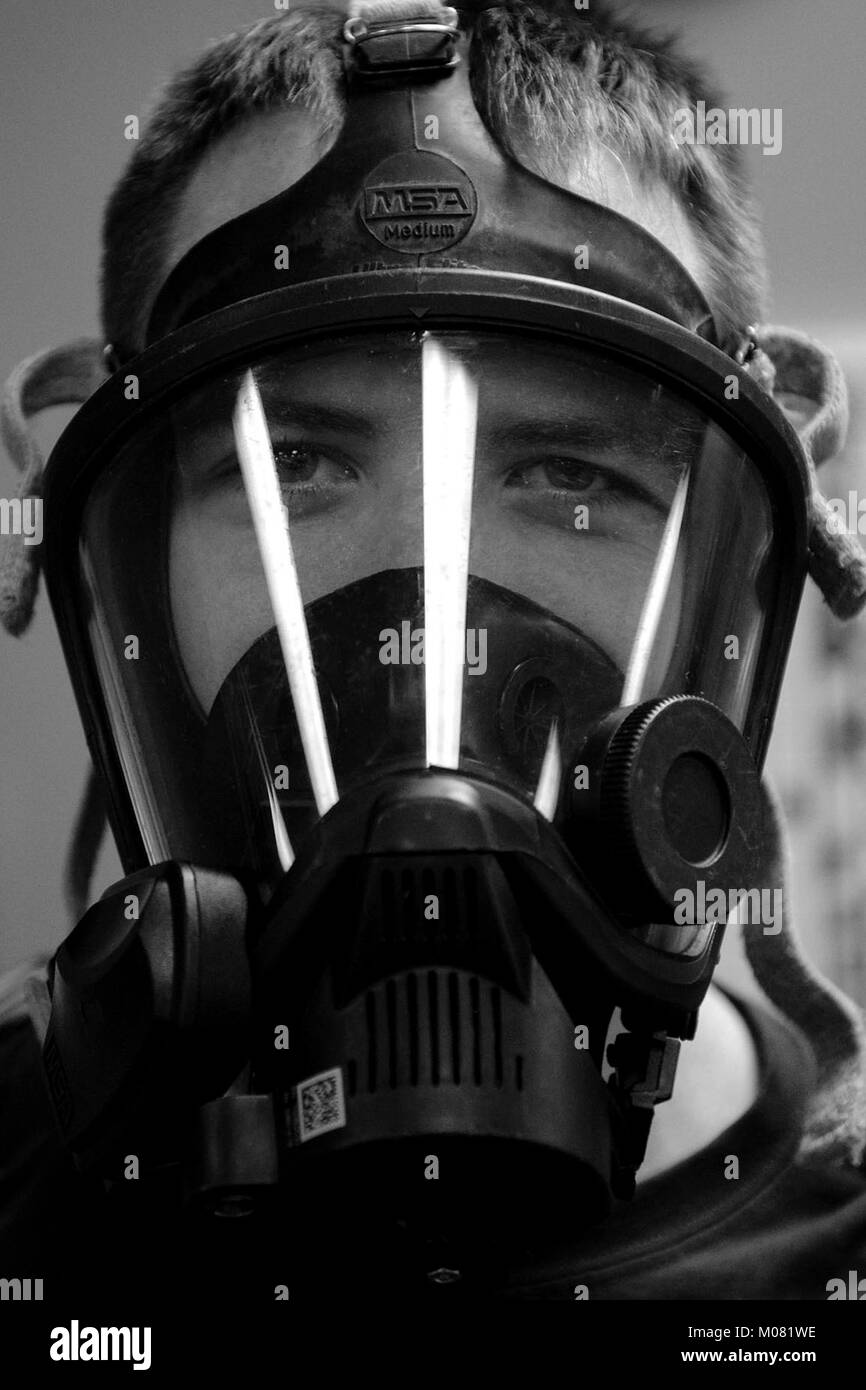 2nd Lt. Eric Olson, 23d Aerospace Medicine Squadron bioenvironmental engineer, gears up during readiness training, Jan. 12, 2018, at Moody Air Force Base, Ga. The Bioenvironmental Engineering Flight tested their response capabilities in a simulated contamination scenario. Bioenvironmental engineering specialists focus on reducing health hazards in the workplace and surrounding areas. (U.S. Air Force Stock Photohttps://www.alamy.com/image-license-details/?v=1https://www.alamy.com/stock-photo-2nd-lt-eric-olson-23d-aerospace-medicine-squadron-bioenvironmental-172280794.html
2nd Lt. Eric Olson, 23d Aerospace Medicine Squadron bioenvironmental engineer, gears up during readiness training, Jan. 12, 2018, at Moody Air Force Base, Ga. The Bioenvironmental Engineering Flight tested their response capabilities in a simulated contamination scenario. Bioenvironmental engineering specialists focus on reducing health hazards in the workplace and surrounding areas. (U.S. Air Force Stock Photohttps://www.alamy.com/image-license-details/?v=1https://www.alamy.com/stock-photo-2nd-lt-eric-olson-23d-aerospace-medicine-squadron-bioenvironmental-172280794.htmlRMM081WE–2nd Lt. Eric Olson, 23d Aerospace Medicine Squadron bioenvironmental engineer, gears up during readiness training, Jan. 12, 2018, at Moody Air Force Base, Ga. The Bioenvironmental Engineering Flight tested their response capabilities in a simulated contamination scenario. Bioenvironmental engineering specialists focus on reducing health hazards in the workplace and surrounding areas. (U.S. Air Force
 Senior Airman Alexander Delfs, 436th Aerospace Medicine Squadron bioenvironmental engineering journeyman, drops a reagent into a water sample during water testing Nov. 16, 2016, at an aircraft watering point on Dover Air Force Base, Del. The 436th AMDS bioenvironmental engineering flight tests water at all youth-age programs and every aircraft watering point monthly. (U.S. Air Force photo by Senior Airman Aaron J. Jenne) Stock Photohttps://www.alamy.com/image-license-details/?v=1https://www.alamy.com/senior-airman-alexander-delfs-436th-aerospace-medicine-squadron-bioenvironmental-engineering-journeyman-drops-a-reagent-into-a-water-sample-during-water-testing-nov-16-2016-at-an-aircraft-watering-point-on-dover-air-force-base-del-the-436th-amds-bioenvironmental-engineering-flight-tests-water-at-all-youth-age-programs-and-every-aircraft-watering-point-monthly-us-air-force-photo-by-senior-airman-aaron-j-jenne-image188669607.html
Senior Airman Alexander Delfs, 436th Aerospace Medicine Squadron bioenvironmental engineering journeyman, drops a reagent into a water sample during water testing Nov. 16, 2016, at an aircraft watering point on Dover Air Force Base, Del. The 436th AMDS bioenvironmental engineering flight tests water at all youth-age programs and every aircraft watering point monthly. (U.S. Air Force photo by Senior Airman Aaron J. Jenne) Stock Photohttps://www.alamy.com/image-license-details/?v=1https://www.alamy.com/senior-airman-alexander-delfs-436th-aerospace-medicine-squadron-bioenvironmental-engineering-journeyman-drops-a-reagent-into-a-water-sample-during-water-testing-nov-16-2016-at-an-aircraft-watering-point-on-dover-air-force-base-del-the-436th-amds-bioenvironmental-engineering-flight-tests-water-at-all-youth-age-programs-and-every-aircraft-watering-point-monthly-us-air-force-photo-by-senior-airman-aaron-j-jenne-image188669607.htmlRMMXXJ07–Senior Airman Alexander Delfs, 436th Aerospace Medicine Squadron bioenvironmental engineering journeyman, drops a reagent into a water sample during water testing Nov. 16, 2016, at an aircraft watering point on Dover Air Force Base, Del. The 436th AMDS bioenvironmental engineering flight tests water at all youth-age programs and every aircraft watering point monthly. (U.S. Air Force photo by Senior Airman Aaron J. Jenne)
 An Airman assigned to the 48th Aerospace Medicine Squadron Bioenvironmental Engineering flight tests the acidity levels of the drinking water at Royal Air Force Lakenheath, England, June 19, 2018. The 48th AMDS, Bioenvironmental Engineering flight uses engineering principles to check for pollutants and radioactive materials, implementing environmental protections, monitoring OSHA and NRC work safety standards and permits, and other duties to reduce health risks and dangers to Airmen. (U.S. Air Force photo/ Airman 1st Class John A. Crawford) Stock Photohttps://www.alamy.com/image-license-details/?v=1https://www.alamy.com/an-airman-assigned-to-the-48th-aerospace-medicine-squadron-bioenvironmental-engineering-flight-tests-the-acidity-levels-of-the-drinking-water-at-royal-air-force-lakenheath-england-june-19-2018-the-48th-amds-bioenvironmental-engineering-flight-uses-engineering-principles-to-check-for-pollutants-and-radioactive-materials-implementing-environmental-protections-monitoring-osha-and-nrc-work-safety-standards-and-permits-and-other-duties-to-reduce-health-risks-and-dangers-to-airmen-us-air-force-photo-airman-1st-class-john-a-crawford-image209305463.html
An Airman assigned to the 48th Aerospace Medicine Squadron Bioenvironmental Engineering flight tests the acidity levels of the drinking water at Royal Air Force Lakenheath, England, June 19, 2018. The 48th AMDS, Bioenvironmental Engineering flight uses engineering principles to check for pollutants and radioactive materials, implementing environmental protections, monitoring OSHA and NRC work safety standards and permits, and other duties to reduce health risks and dangers to Airmen. (U.S. Air Force photo/ Airman 1st Class John A. Crawford) Stock Photohttps://www.alamy.com/image-license-details/?v=1https://www.alamy.com/an-airman-assigned-to-the-48th-aerospace-medicine-squadron-bioenvironmental-engineering-flight-tests-the-acidity-levels-of-the-drinking-water-at-royal-air-force-lakenheath-england-june-19-2018-the-48th-amds-bioenvironmental-engineering-flight-uses-engineering-principles-to-check-for-pollutants-and-radioactive-materials-implementing-environmental-protections-monitoring-osha-and-nrc-work-safety-standards-and-permits-and-other-duties-to-reduce-health-risks-and-dangers-to-airmen-us-air-force-photo-airman-1st-class-john-a-crawford-image209305463.htmlRMP4EK73–An Airman assigned to the 48th Aerospace Medicine Squadron Bioenvironmental Engineering flight tests the acidity levels of the drinking water at Royal Air Force Lakenheath, England, June 19, 2018. The 48th AMDS, Bioenvironmental Engineering flight uses engineering principles to check for pollutants and radioactive materials, implementing environmental protections, monitoring OSHA and NRC work safety standards and permits, and other duties to reduce health risks and dangers to Airmen. (U.S. Air Force photo/ Airman 1st Class John A. Crawford)
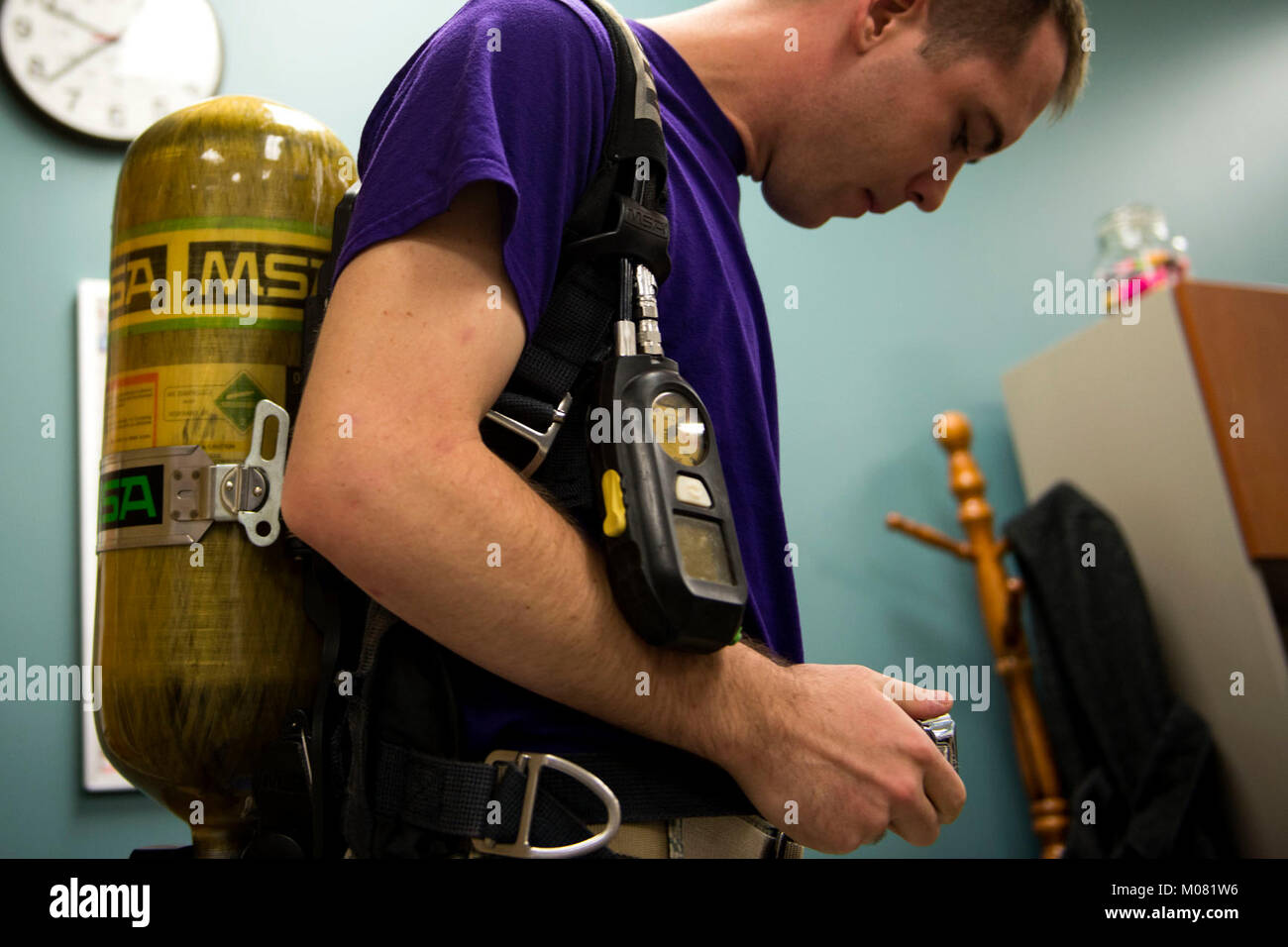 2nd Lt. Eric Olson, 23d Aerospace Medicine Squadron (AMDS) bioenvironmental engineer, secures a breathing apparatus during biohazard readiness training, Jan. 12, 2018, at Moody Air Force Base, Ga. The Bioenvironmental Engineering Flight tested their response capabilities in a simulated contamination scenario. Bioenvironmental engineering specialists focus on reducing health hazards in the workplace and surrounding areas. (U.S. Air Force Stock Photohttps://www.alamy.com/image-license-details/?v=1https://www.alamy.com/stock-photo-2nd-lt-eric-olson-23d-aerospace-medicine-squadron-amds-bioenvironmental-172280786.html
2nd Lt. Eric Olson, 23d Aerospace Medicine Squadron (AMDS) bioenvironmental engineer, secures a breathing apparatus during biohazard readiness training, Jan. 12, 2018, at Moody Air Force Base, Ga. The Bioenvironmental Engineering Flight tested their response capabilities in a simulated contamination scenario. Bioenvironmental engineering specialists focus on reducing health hazards in the workplace and surrounding areas. (U.S. Air Force Stock Photohttps://www.alamy.com/image-license-details/?v=1https://www.alamy.com/stock-photo-2nd-lt-eric-olson-23d-aerospace-medicine-squadron-amds-bioenvironmental-172280786.htmlRMM081W6–2nd Lt. Eric Olson, 23d Aerospace Medicine Squadron (AMDS) bioenvironmental engineer, secures a breathing apparatus during biohazard readiness training, Jan. 12, 2018, at Moody Air Force Base, Ga. The Bioenvironmental Engineering Flight tested their response capabilities in a simulated contamination scenario. Bioenvironmental engineering specialists focus on reducing health hazards in the workplace and surrounding areas. (U.S. Air Force
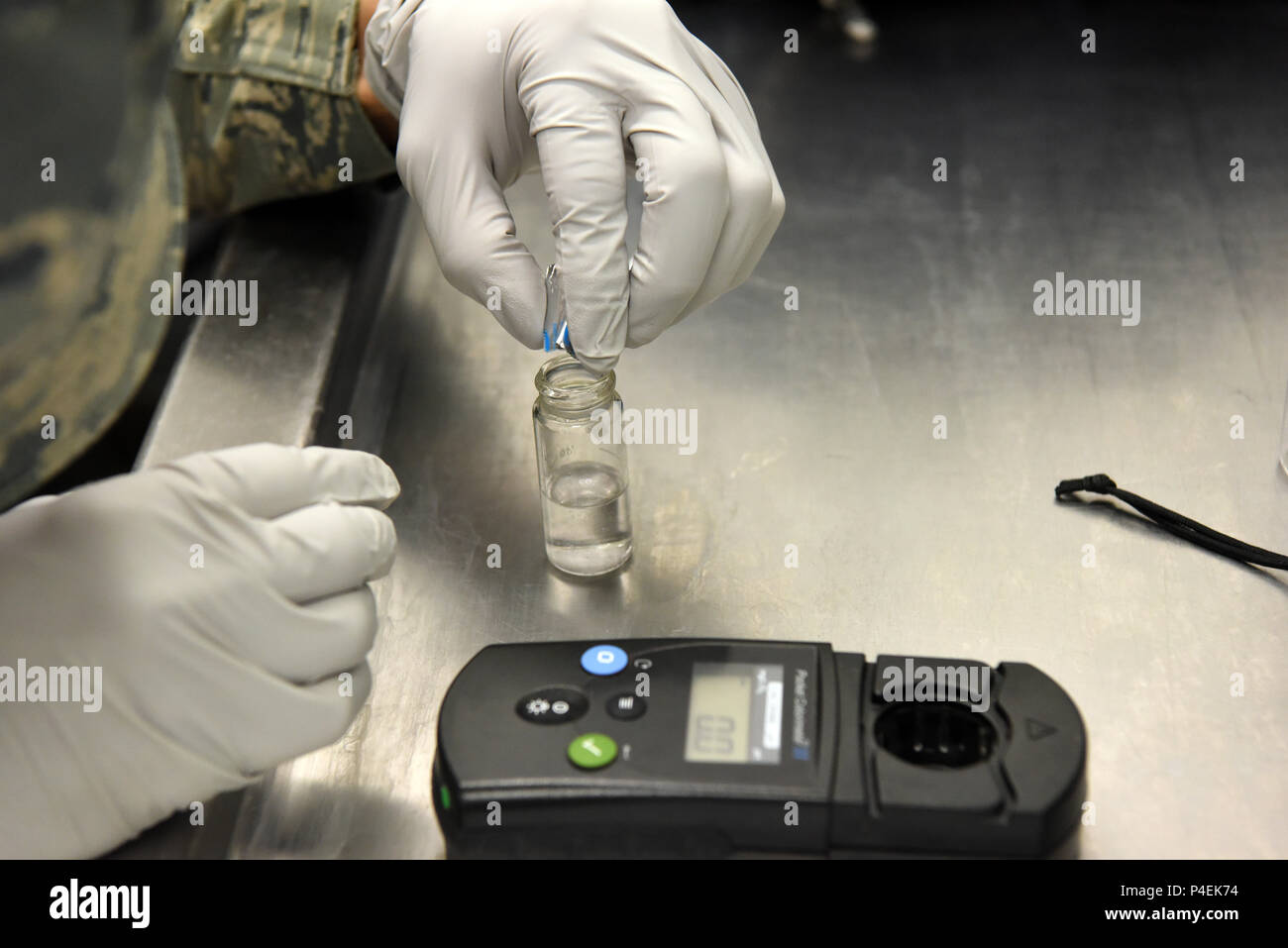 An Airman assigned to the 48th Aerospace Medicine Squadron Bioenvironmental Engineering flight tests the acidity levels of the drinking water at Royal Air Force Lakenheath, England, June 19, 2018. The 48th AMDS, Bioenvironmental Engineering flight uses engineering principles to check for pollutants and radioactive materials, implementing environmental protections, monitoring OSHA and NRC work safety standards and permits, and other duties to reduce health risks and dangers to Airmen. (U.S. Air Force photo/ Airman 1st Class John A. Crawford) Stock Photohttps://www.alamy.com/image-license-details/?v=1https://www.alamy.com/an-airman-assigned-to-the-48th-aerospace-medicine-squadron-bioenvironmental-engineering-flight-tests-the-acidity-levels-of-the-drinking-water-at-royal-air-force-lakenheath-england-june-19-2018-the-48th-amds-bioenvironmental-engineering-flight-uses-engineering-principles-to-check-for-pollutants-and-radioactive-materials-implementing-environmental-protections-monitoring-osha-and-nrc-work-safety-standards-and-permits-and-other-duties-to-reduce-health-risks-and-dangers-to-airmen-us-air-force-photo-airman-1st-class-john-a-crawford-image209305464.html
An Airman assigned to the 48th Aerospace Medicine Squadron Bioenvironmental Engineering flight tests the acidity levels of the drinking water at Royal Air Force Lakenheath, England, June 19, 2018. The 48th AMDS, Bioenvironmental Engineering flight uses engineering principles to check for pollutants and radioactive materials, implementing environmental protections, monitoring OSHA and NRC work safety standards and permits, and other duties to reduce health risks and dangers to Airmen. (U.S. Air Force photo/ Airman 1st Class John A. Crawford) Stock Photohttps://www.alamy.com/image-license-details/?v=1https://www.alamy.com/an-airman-assigned-to-the-48th-aerospace-medicine-squadron-bioenvironmental-engineering-flight-tests-the-acidity-levels-of-the-drinking-water-at-royal-air-force-lakenheath-england-june-19-2018-the-48th-amds-bioenvironmental-engineering-flight-uses-engineering-principles-to-check-for-pollutants-and-radioactive-materials-implementing-environmental-protections-monitoring-osha-and-nrc-work-safety-standards-and-permits-and-other-duties-to-reduce-health-risks-and-dangers-to-airmen-us-air-force-photo-airman-1st-class-john-a-crawford-image209305464.htmlRMP4EK74–An Airman assigned to the 48th Aerospace Medicine Squadron Bioenvironmental Engineering flight tests the acidity levels of the drinking water at Royal Air Force Lakenheath, England, June 19, 2018. The 48th AMDS, Bioenvironmental Engineering flight uses engineering principles to check for pollutants and radioactive materials, implementing environmental protections, monitoring OSHA and NRC work safety standards and permits, and other duties to reduce health risks and dangers to Airmen. (U.S. Air Force photo/ Airman 1st Class John A. Crawford)
 Airman 1st Class Briana McIver, left, 23d Aerospace Medicine Squadron (AMDS) bioenvironmental engineering apprentice, secures 2nd Lt. Eric Olson, 23d AMDS bioenvironmental engineer, in a Level A suit during readiness training, Jan. 12, 2018, at Moody Air Force Base, Ga. A Level A suit is designed to protect the user against any biological threat. The Bioenvironmental Engineering Flight tested their response capabilities in a simulated contamination scenario. Bioenvironmental engineering specialists focus on reducing health hazards in the workplace and surrounding areas. (U.S. Air Force Stock Photohttps://www.alamy.com/image-license-details/?v=1https://www.alamy.com/stock-photo-airman-1st-class-briana-mciver-left-23d-aerospace-medicine-squadron-172280788.html
Airman 1st Class Briana McIver, left, 23d Aerospace Medicine Squadron (AMDS) bioenvironmental engineering apprentice, secures 2nd Lt. Eric Olson, 23d AMDS bioenvironmental engineer, in a Level A suit during readiness training, Jan. 12, 2018, at Moody Air Force Base, Ga. A Level A suit is designed to protect the user against any biological threat. The Bioenvironmental Engineering Flight tested their response capabilities in a simulated contamination scenario. Bioenvironmental engineering specialists focus on reducing health hazards in the workplace and surrounding areas. (U.S. Air Force Stock Photohttps://www.alamy.com/image-license-details/?v=1https://www.alamy.com/stock-photo-airman-1st-class-briana-mciver-left-23d-aerospace-medicine-squadron-172280788.htmlRMM081W8–Airman 1st Class Briana McIver, left, 23d Aerospace Medicine Squadron (AMDS) bioenvironmental engineering apprentice, secures 2nd Lt. Eric Olson, 23d AMDS bioenvironmental engineer, in a Level A suit during readiness training, Jan. 12, 2018, at Moody Air Force Base, Ga. A Level A suit is designed to protect the user against any biological threat. The Bioenvironmental Engineering Flight tested their response capabilities in a simulated contamination scenario. Bioenvironmental engineering specialists focus on reducing health hazards in the workplace and surrounding areas. (U.S. Air Force
 An Airman assigned to the 48th Aerospace Medicine Squadron Bioenvironmental Engineering flight confirms the results of a water acidity test at Royal Air Force Lakenheath, England, June 19, 2018. The 48th AMDS, Bioenvironmental Engineering flight uses engineering principles to check for pollutants and radioactive materials, implementing environmental protections, monitoring OSHA and NRC work safety standards and permits, and other duties to reduce health risks and dangers to Airmen. (U.S. Air Force photo/ Airman 1st Class John A. Crawford) Stock Photohttps://www.alamy.com/image-license-details/?v=1https://www.alamy.com/an-airman-assigned-to-the-48th-aerospace-medicine-squadron-bioenvironmental-engineering-flight-confirms-the-results-of-a-water-acidity-test-at-royal-air-force-lakenheath-england-june-19-2018-the-48th-amds-bioenvironmental-engineering-flight-uses-engineering-principles-to-check-for-pollutants-and-radioactive-materials-implementing-environmental-protections-monitoring-osha-and-nrc-work-safety-standards-and-permits-and-other-duties-to-reduce-health-risks-and-dangers-to-airmen-us-air-force-photo-airman-1st-class-john-a-crawford-image209305469.html
An Airman assigned to the 48th Aerospace Medicine Squadron Bioenvironmental Engineering flight confirms the results of a water acidity test at Royal Air Force Lakenheath, England, June 19, 2018. The 48th AMDS, Bioenvironmental Engineering flight uses engineering principles to check for pollutants and radioactive materials, implementing environmental protections, monitoring OSHA and NRC work safety standards and permits, and other duties to reduce health risks and dangers to Airmen. (U.S. Air Force photo/ Airman 1st Class John A. Crawford) Stock Photohttps://www.alamy.com/image-license-details/?v=1https://www.alamy.com/an-airman-assigned-to-the-48th-aerospace-medicine-squadron-bioenvironmental-engineering-flight-confirms-the-results-of-a-water-acidity-test-at-royal-air-force-lakenheath-england-june-19-2018-the-48th-amds-bioenvironmental-engineering-flight-uses-engineering-principles-to-check-for-pollutants-and-radioactive-materials-implementing-environmental-protections-monitoring-osha-and-nrc-work-safety-standards-and-permits-and-other-duties-to-reduce-health-risks-and-dangers-to-airmen-us-air-force-photo-airman-1st-class-john-a-crawford-image209305469.htmlRMP4EK79–An Airman assigned to the 48th Aerospace Medicine Squadron Bioenvironmental Engineering flight confirms the results of a water acidity test at Royal Air Force Lakenheath, England, June 19, 2018. The 48th AMDS, Bioenvironmental Engineering flight uses engineering principles to check for pollutants and radioactive materials, implementing environmental protections, monitoring OSHA and NRC work safety standards and permits, and other duties to reduce health risks and dangers to Airmen. (U.S. Air Force photo/ Airman 1st Class John A. Crawford)